issue HOLIDAY
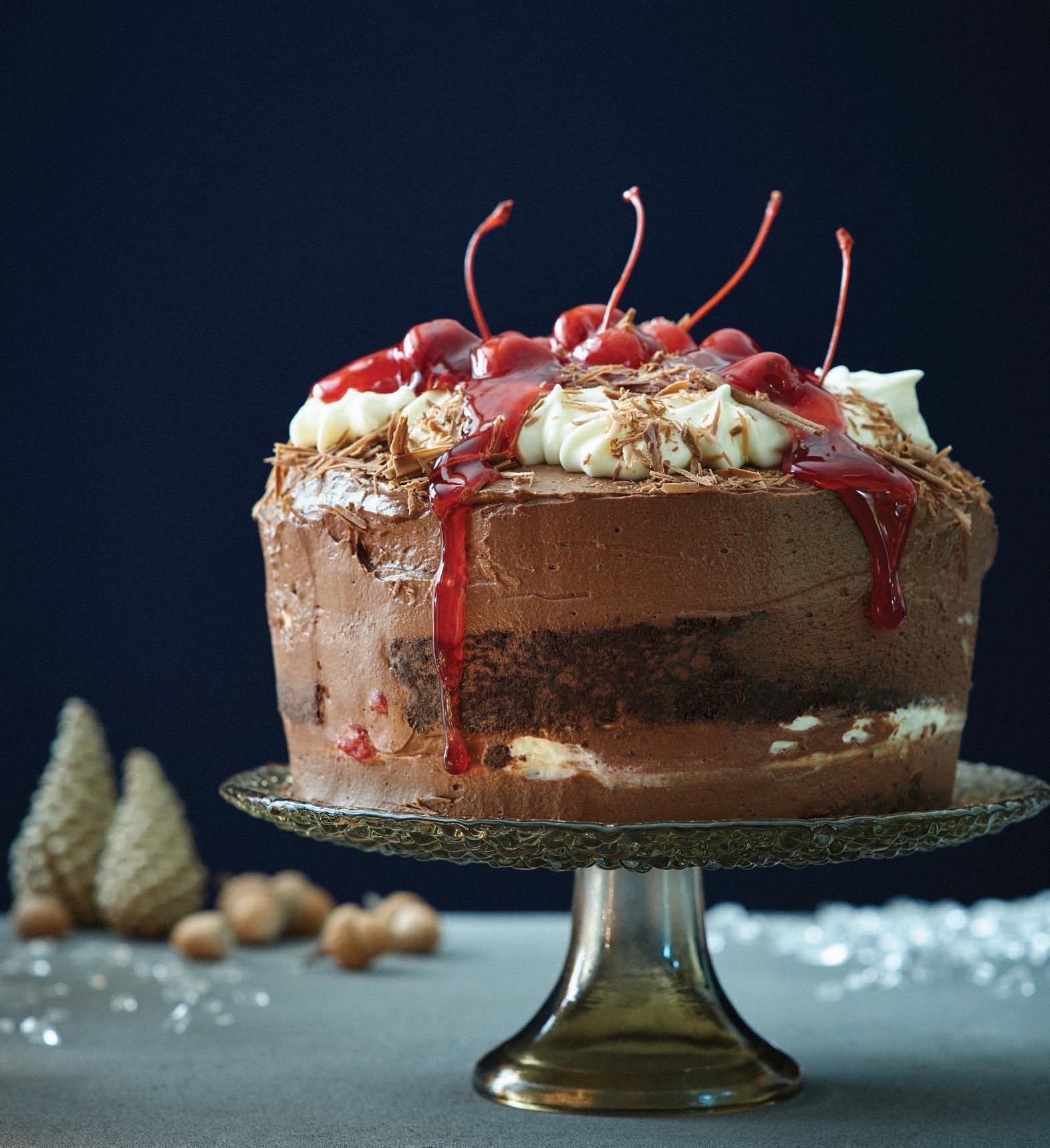
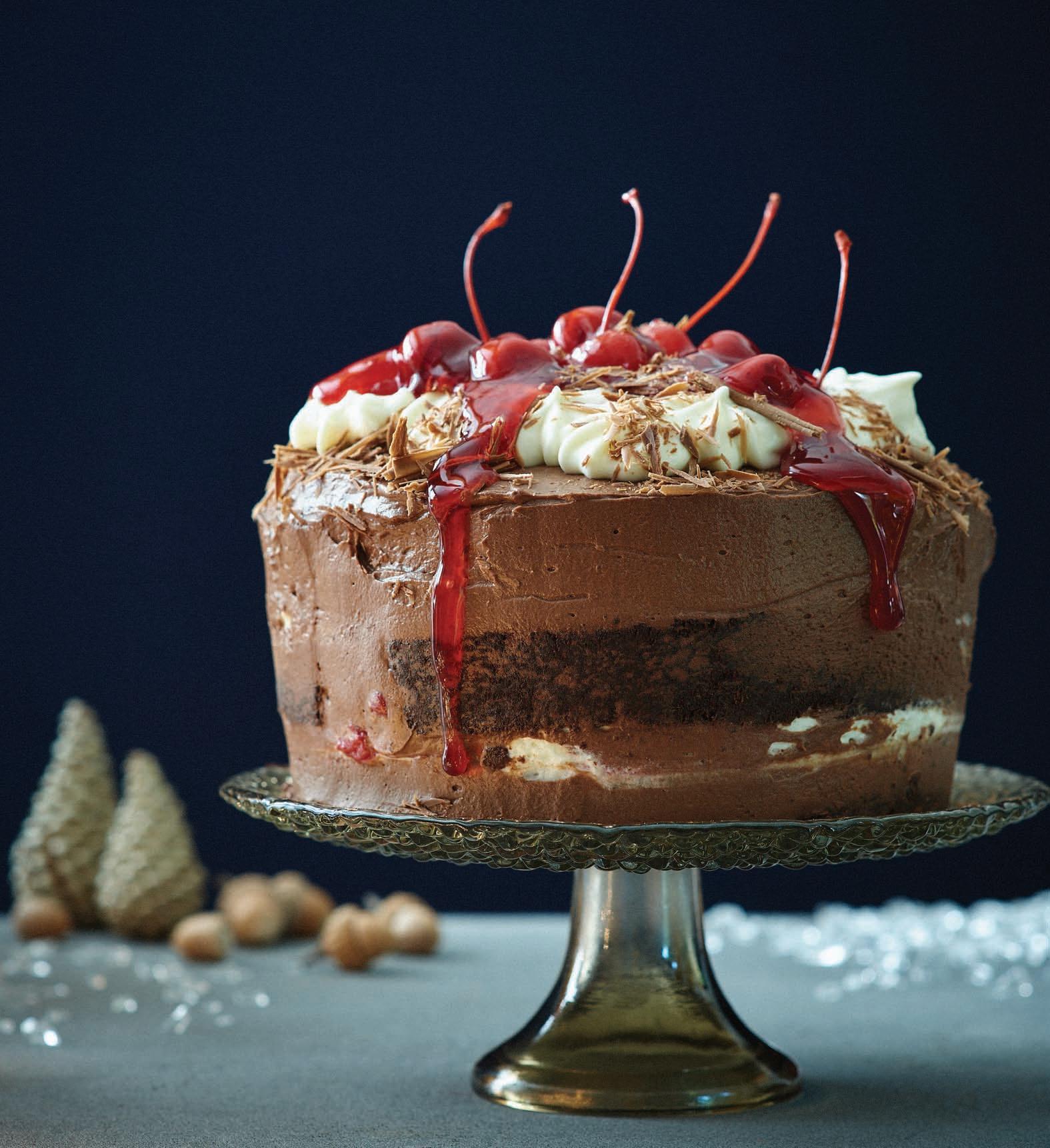




the
ROAST PORK • BC WINES • CAKE • QUAIL

WHAT ARE THE SPECIAL CHRISTMAS MOMENTS that put you in the spirit for the holiday season? For me it's seeing the first cases of mandarins at the grocery store, putting up the tree and sorting through boxes of old and cherished ornaments (each one tells a story), and taking brisk winter walks with our Taiwanese rescue dog, Etta, to work off the rich meals we've been enjoying. At our house we make shortbread cookies, nibble on artisan cheese and charcuterie while watching the latest episode of the Great British Baking Show (or maybe this year The Great Canadian Baking Show) while slow-braising beef cheeks that perfume the house with tantalizing aromas. We drink brandy (sometimes with eggnog), switch to darker winter beers and sip more brooding and complex red wines. It’s the sights, aromas, tastes, and personal traditions that make this such a special time of year.
In this Holiday issue, we offer-up more recipes than we usually do—elegant stuffed quail with pancetta, a unique and satisfying pork roast with fennel and prawns, and for dessert, a stunning version of the classic Black Forest Cake. In “Holiday Heaven on the Half Shell” writer Cinda Chavich talks West Coast oysters and shares her prized recipe for Double Oyster Stew. Elsewhere in this packed issue, there are articles on new Canadian cookbooks, holiday wines, a buzzy new downtown cocktail bar, and three terrific, budget-friendly restaurants. Plus the second installment of writer Jill Van Gyn's "The Politics of Food" will make you pause and think. You'll find more to read in our regular columns and, for those thinking of a food start-up, there's a story on a new kitchen commissary that just might make all the difference. Have a great holiday and we’ll see you in the New Year 2018.
Gary Hynes
















































CITY EATS:









We have an update on Kunal Ghose’s second Fishhook location: Fishhook at Mermaid Wharf will build on the success of the three-year-old ‘Fishhook’ at Fort Commons, with a beautiful waterside patio, an expanded menu featuring a variety of sustainable, locally sourced and farm fresh ingredients, shared plates featuring sustainable seafood charcuterie, weekend brunch, and a beverage program featuring six local taps, BC wines and seasonal cocktails. The expansive space also allows for reservations and large parties even Xmas parties. Fall and winter hours are Wed-Sun 4-late with weekend brunch 10-3. FISHHOOKVIC.COM
The Happy Goat Cheese Company is the most recent recipient of an Island Chef Collaborative micro-loan. ICC micro-loans support growers, harvesters and producers who are increasing food production on Vancouver Island. You can find Happy Goat cheese at Caffe Fantastico Bar-Deli at Dockside Green, or at the Esquimalt Farmers’ Christmas Market on Sunday Nov 12. THEHAPPYGOAT.CA


A number of closures have occurred in recent months. In the spring of 2017, The Apple Box on Cook St was forced to close following financial distress that was triggered by having their stock wiped out by a “huge freezer malfunction”. The owners have hopes to reopen “if they can get back on their feet” (quotations taken from the Apple Box website). The Cottage Picnic and Play on Cedar Hill has also closed their doors and put the business on the market. At press time, it appears that Fairfield Market on Oscar Street is also closed indefinitely. North 48 closed on Broughton St, and Cascadia Bakery closed their storefront on Government Street, but will continue to supply Rebar and Pure Vanilla with baked goods. Now for some good news: following a very successful Kickstarter campaign that brought in over $60,000, The Very Good Butchers, the vegan and organic plant-based meat producers whose storefront opened in the Victoria Public Market last February, will be able to expand operations. VERYGOODBUTCHERS.COM
White Chocolate Christmas?



Make that dream come true and treat your family and friends to this decadent White Chocolate Mandarin Orange Cake. Learn how to make this and many more tempting, holiday inspired favourites at thriftyfoods.com/recipes
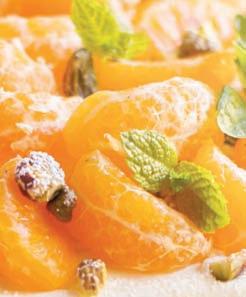
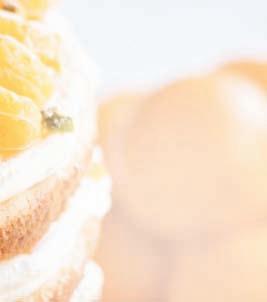
3 Be merry Eat happy
A
thriftyfoods.com 1.800.667.8280 Connect with us
DREAMING OF
Welcome
HYNES
EDITOR
GARY
FOUNDER &
Visit eatmagazine.ca for news and events from: COWICHAN VALLEY UP ISLAND TOFINO UCLUELET VANCOUVER
REBECCA BAUGNIET
The Local in Bastion Square acquired the neighbouring space (formerly Paradiso Di Stelle) and has opened the
licensed Farmhouse, serving coffee, sandwiches and more.
FARMHOUSEVICTORIA.COM
The Livet is excited to intro-
duce their new chef Jason Bivall. Chef Bivall hails from some of Canada’s best restaurants, such as Canoe in Toronto and Au Pied de Cochon in Montreal.
THELIVET.CA
The Parkside Hotel and Spa is hosting the 9th Annual Gingerbread Showcase from Nov 18-Jan 2. You are invited to feast your eyes on creative inspirations fashioned from gingerbread and other edible components. More than just houses, these are detailed sculptures and unique works of art crafted by professional and amateur chefs. Vote for your favourite with your donation to Habitat for Humanity Victoria .
PARKSIDEVICTORIA.COM
Looking for a way to get Santa photos without a trip to the mall? The Oak Bay Beach
Hotel is hosting a series of Breakfast with Santa events on weekends in December, featuring a breakfast buffet, cookie decorating and on-site photographer with photo printing. OAKBAYBEACHHOTEL.COM
Vancouver-based Canadian Craft Tours are offering a number of tours around Victoria, including a Butchart Gardens and Winery Tour, Cowichan Valley Wine Tour, Victoria Brewery Tour, Saanich Peninsula Tour and Craft Brewery and Distillery Tour.
CANADIANCRAFTTOURS.CA
Moss Street Market’s 23rd annual Holiday Market will take place on Dec 9 & 10 in the Fairfield Gonzales Community Association buildings (1330 Fairfield Road), the Garry Oak Room and the Sir James Douglas School Gym. MOSSSTREETMARKET.COM
If food restrictions make it hard to get excited about holiday baking, join nutritionist and chef Ellie Shortt in a festively-fun afternoon of baking and treatmaking filled with options for everyone on your list including gluten-free, dairy-free, low-carb, plantbased, and raw recipes. There will be demonstrations, tastings, and hands-on experience, as well as an option to take home some of your creations to share with family and friends. Class is offered Dec 9 at the London Chef. Tickets $100. LONDONCHEF.COM
Fans of True Grain Bakery in Cowichan Bay will be happy to hear that they have now have another bakery further up island. Earlier this fall, True Grain announced that they had purchased the assets of Grains Bakery in Courtenay and would be opening their new location in October. This is the third location for the old world-inspired bakery, which opened their second location in Summerland in 2012.
TRUEGRAIN.CA
Cornucopia, Whistler’s annual celebration of food and drink, takes place this year from November 9-19 Presented by BlueShore Financial, the event bills itself as the True North of food and drink festivals – a place of culinary reckonings, where the wild meets the refined and the epic and the epicurious come together.
WHISTLERCORNUCOPIA.COM
Try an almost free sampling event on November 18 at the 3rd annual Victoria MidLife Show . Tastes and Spirits is a show within a show, showcasing the work of local restaurants, caterers, fine food purveyors, brewers, vintners and distillers. Meet the people behind the fabulous food and drink, and ask them about their sourcing and preparation. Tastes runs from 10 to 5, Spirits from noon to 5. Admission to Tastes & Spirits is included in your $5 admission to the Show. While you are there check out the interactive exhibits and the action on the main stage and in the workshop space. Valuable door prizes drawn at 1 and 4 pm. Victoria Conference Centre, 720 Douglas.
MIDLIFESHOW.COM
Masthead
FOUNDER & EDITOR
Gary Hynes
PUBLISHER
Pacific Island Gourmet
CONTRIBUTING EDITOR Carolyn Bateman
VANCOUVER CONTRIBUTING EDITOR
Julie Pegg
SENIOR WINE WRITER
Larry Arnold
PRODUCTION Gary Hynes
DESIGN CONSULTANT
Aleya Samji
COPYEDITOR Cynthia Annett
REGIONAL REPORTERS
Tofino Ucluelet, Jen Dart Victoria, Rebecca Baugniet
Cowichan Valley-Up Island, Kirsten Tyler Vancouver, Jennifer Carter
CONTRIBUTORS
Larry Arnold Joseph Blake Michelle Bouffard
Isabelle Bulota Marie-Eve Charron Cinda Chavich
Pam Durkin
Lillie Louise Major Sherri Martin Elizabeth Monk Daniel Murphy Daisy Orser Elizabeth Nyland Adrian Paradis André Rozon
Adrien Sala
Shelora Sheldan Shawn Soole Jill Van Gyn Johann Vincent Rebecca Wellman
COVER

Marie-Eve Charron (styling) & André Rozon (photo)
ADVERTISING DIRECTOR

Gary Hynes
DIRECTOR OF BUSINESS
DEVELOPMENT
Jen Kinna
SENIOR ACCOUNT MANAGER Susan Worrall
FACEBOOK/EATMAGAZINE
TWITTER/EATMAGAZINE

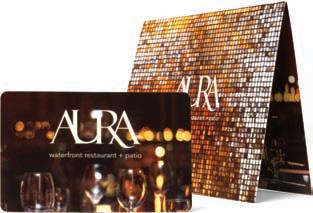
INSTAGRAM/EATMAG

For advertising and other inquiries: PHONE 250.384.9042, EMAIL editor@eatmagazine.ca
ONLINE EatMagazine.ca, TheEatJournal.com
MAILING ADDRESS Box 5225, Victoria, BC, V8R 6N4
STOCKISTS EAT is delivered to over 300 pick-up locations in BC. Visit our website for locations.
PRINTED IN BRITISH COLUMBIA EAT ® is a registered trademark. Est. 1999
4NOVEMBER/DECEMBER 2017
CITY EATS: NOVEMBER / DECEMBER Bridal Registry Available Le Creuset Forged NonStick Frypans SENSATIONAL SEASONAL SAVINGS! B roadme ad V Vil lage, 130 777 R Royal O Oak D Dri ve, V Victori a, B BC www.pennaki tc he n.co m, 2 250- 727-2110, Info@p ennakitchen.com for people who love to cook Regular $175 - $320 Sale $89.99 - $179.99 PFOA free. Induction ready. Suitable for any type of cooktop.
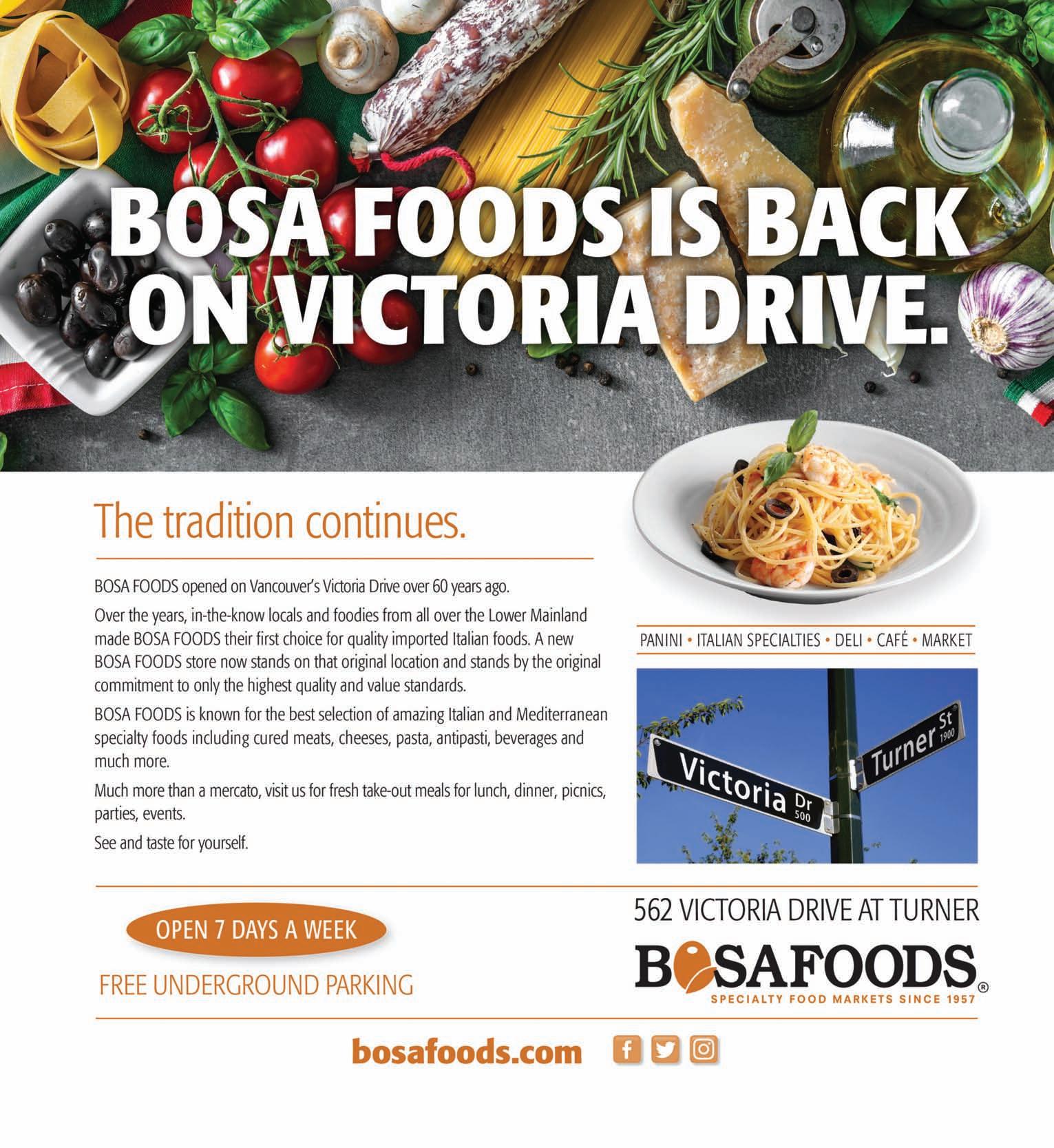
AS THIS YEAR’S HOLIDAY SEASON GEARS UP , I’m reminded of the early 1950s. I remember a political and geographic rough and tumble not unlike 2017. World War II had taken its toll, McCarthyism was hell-bent on exposing Communists in the U.S.; Hurricane Hazel had hit Southern Ontario hard and the Cold War loomed. Added to that, finances were tough on new Canadians. Our mainly immigrant neighbourhood was a motley mix of Italians, Romanians, Germans and Ukrainians, Poles, Irish, Scots and English. A few French Canadians, Nova Scotians and Ontario farmers whose land had not been turned into an adjacent subdivision rounded out the hodgepodge. Perhaps it was a hankering for political stability. Perhaps it was a yearning for the old country, but come December the stoves were fired up right through to January 7 (Orthodox Christmas). The (mostly) women were natural cooks, whipping up hearty homey dishes capable of ensuring



us that, during the holidays at least, all was right with the world.








For many European Catholics or Orthodox families, a Christmas Eve spread was bereft of meat. It was as much to do with heritage as it was with faith. A typical “starter” for an EasternEuropean twelve-course meal is wild mushroom and sour cream soup (I was particularly partial, however, to Lucy Buchko’s Ukrainian meatless borscht). My Italian in-laws celebrated “the Vigil” with a multi-course seafood meal. The Irish (and the English, according to cooking maven Elizabeth David) tucked into brined and boiled spiced beef (rather like corned beef), before and after the 25th but never on the day. That was reserved for turkey. There would also be gammon (ham) served with champ (potatoes mashed with green onions). The all-American turkey had claimed centre stage, although standard bread stuffing often took on a cultural flair.


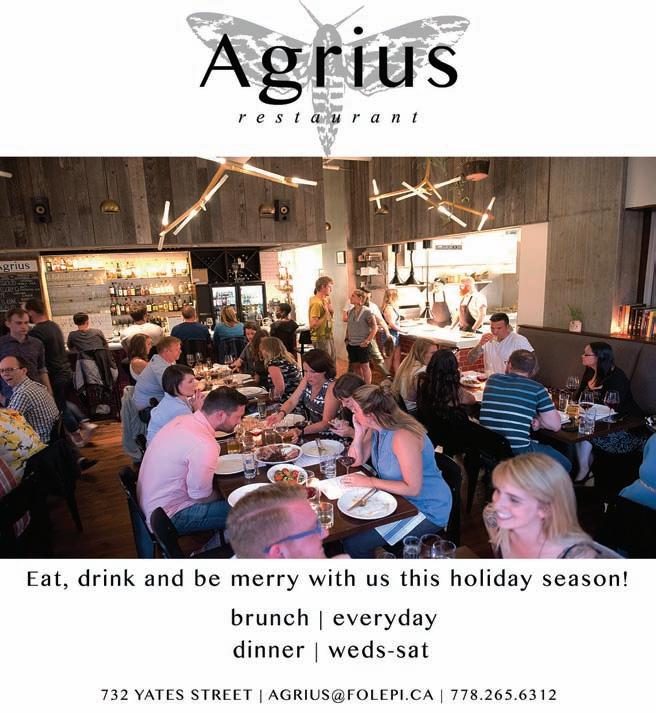

The turkey might be dressed with rustic bread flecked with olives and sweet pepper, oregano or paprika, spicy Italian sausage or chorizo. When I moved to Vancouver many years later, my Asian sister-in-law introduced me to a bird filled with sticky rice, dried shrimp and Chinese sausage.




The stoves were fired up for the sweet stuff, too. I remember our Romanian neighbour, Lena, popping a basket of just-outof-the oil, plum-jam-filled doughnuts over the fence on a frosty Saturday morning. Ella Black up the road whipped up flaky

Scottish scones and thick, crumbly shortbread. My British mum’s rum-soaked fruitcakes and steamed suet puddings wrapped in torn pillowcases tied with string were “aging” in a cool pantry. There was Italian pannetone and German stollen.
It was years, though, before I learned of Danish aebleskiver. I had a heavy, circular, cast-iron pan that I’d found in a thrift shop. It looked like a muffin tin with round instead of flat “cups.”
I didn’t know what it was, and for a very long time I put it to Yorkshire pudding (or popover) use. A Danish carpenter doing work in our tiny kitchen one day spotted the pan hanging on the wall. With as much animation as his six-foot-four, rotund fame would allow, he informed me I had scored an old aebleskiver, which was the name of both the pan and the fluffy roly-poly pancakes so beloved in Denmark at Christmas. It took some doing to master aebleskiver. The method requires flipping the dough when a good dollop of batter begins to bubble and curl in the hot “cups.” (I use tongs or two long chopsticks, which, incidentally, Lena used to flip doughnuts.)
6NOVEMBER/DECEMBER 2017
FOOD MATTERS
RIGHTING THE WORLD One treasured, traditional holiday dish at a time. VE A romantic evening celebration under the stars at an unforgettable place! for details contact: 1.250.856.0188 or info@villaeyrie.com UNMASK 2018 IN STYLE A romantic evening celebration under the stars at an unforgettable place! Countdown to midnight with a romantic 6-course dinner, dancing, overnight stay in a beautiful suite, and breakfast brunch bu et. MidnightCELEBRATE IN VENICE reb gnenive M omr A M E TE I C at a elc cint N U A ATR EBRAEL E Mi d g i n gh A dight i or rs nffor u na at a s E ats eht erdnu on t L Y T N S 8 I 01 K 2 N V S h ht t nght i ight Mdiddn Mid !ecalp elabtteg ECIVEN A C 1 ct: atnoscl ia ai etr d of fo uaen a by i a ttshginrevo t whgindiomntwodtnou a atrebel cgneniv ecint om m r e.ciyreallio@vf fo@vn r i 1.250.856.0188 o 12 nur t b saf fakaerb d n ne,atiul s uf fu itu ni se d rou oc c 6-c or itnamoh a rtit w nffor u na t at rsat seh terdn uoniat mo et. et. h bu c g,ncina , d r, e !ecalp elabtteg
Getting the middle of each “pancake” cooked without burning the outside is a bit tricky. But once grasped, aebleskivers are quick and easy to make. I shy away from filling them. Instead, I split them and spread with creamery butter and tart jam (Ikea’s lingonberry is ideal) or herb jelly, or I sprinkle them with lemon juice and a dusting of sugar. The doughy balls toast beautifully the next day— if any are left. Refrigerated leftover batter after a few days begins to ferment. The resulting pancakes take on a tasty sour tang.


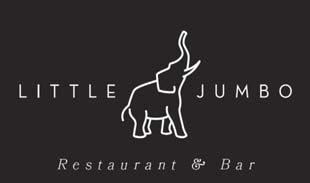





Traditional holiday cooking doesn’t have to have fussy ingredients or be complicated. The time it takes prepping and cooking is well worth it. Kids can chip in with the stirring and measuring. The kitchen smells good. The food is nourishing and warm and comforting. Life moves slowly for a time. And all is right with the world.

QUALITY, CREATIVITY, & EXECUTION Fall's arrival delivers amazing fresh ingredients, rich aromas, and full flavours to maximize your dining & beverage experience. Down the Hall, 506 Fort St. www.li lejumbo.ca 778.433.5535 Reserva ons accepted online Open 7 days a week 5 PM un l late JULIE PEGG
7
AEBLESKIVER
Get fresh DO YOU FUYU?













Persimmons, an Asian tree fruit both astringent and sweet, is in season now and ready to be enjoyed.




IMAGINE ROWS OF NAKED TREES STANDING IN POOLS OF LEAVES in a stark early winter landscape, laden with vibrant orange fruit. If you’ve witnessed persimmon harvest season, you will remember because it will have been a stunning sight.

Considered a “hardy subtropical,” these lovely sweet treats are available most of the year from various global growing regions, but the peak season for persimmons grown close to (California) or at home is October through December. Yes, at home. A persimmon tree can be acquired at Fruit Trees and More in Saanich, and though it is said to be a difficult crop to manage, with inconsistent yields, if you’re up for the challenge I imagine it is worth the reward. Several local farms have small persimmon orchards, as late- season harvests are always desirable, but yields vary from meagre to moderate.

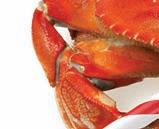


Though there are more than a thousand persimmon varieties, two are most popular at market, and knowing their differences is strongly recommended before you embark on your persimmon-gathering foray. Both varieties contain tannins, but one is non-astringent, the other is very astringent. You will be delivered either a surprisingly bitter bite or a shockingly sweet sensation, depending on the variety you choose and its ripeness. Both varieties can be found dried, though they have become




less common in recent years; think of a large date with a creamy smooth texture and a powdery thin skin. If you happen upon them, they are a must-try.
The less astringent, and more popular, Fuyu persimmon can be enjoyed out of hand when still crisp. It only sweetens as it softens, lending itself to a myriad of uses throughout the ripening process. It has a lighter orange exterior and a more squat shape, often compared to an orange tomato with a slight pumpkin taste. Its skin can be eaten and its variable texture lends itself to everything from salads to cakes to jams and chutneys. When cut, a fresh Fuyu persimmon has a beautiful star-like cross section, and they do not oxidize when exposed to air.
The deep orange, almost red, heart-shaped Hachiya persimmon is less readily available, as it is the extremely astringent variety. It is not ready to be eaten until its outward appearance is quite unappealing and it looks over-ripe. When its flesh is palatable to eat, it will have a jelly-like texture, lending itself best to uses like baking, sauces and purees. If you bite into an under-ripe Hachiya, you will recoil and pucker, so read your signs and know your persimmons.
It is said that people who like persimmons, love them. Become a persimmon lover this winter.
Daisy Orser is co-owner of The Root Cellar Village Green Grocer
8NOVEMBER/DECEMBER 2017
LET’S PARTY! CLASSIC CUISINE. SPECTACULARLY GOOD TIMES. 250 598 8555 | marinarestaurant.com | 1327 Beach Drive at the Oak Bay Marina The Marina Restaurant has everything you need to make your special occasion special. From an intimate party with shared dishes to a stunning
course dinner for
we can make your celebration unforgettable. Talk to us and get your party started.
five
up to 40,
SELECTION: Choose your recipe before you choose your persimmon. If slicing into a salad, choose a more firm Fuyu, which will still be mildly sweet. If making a cake, select a Hachiya and wait patiently for full ripeness; it will deliver amazing sweetness.
STORAGE: Like any fresh produce, aim to consume quickly once ripe to enjoy it at its finest. Store at room temperature until ready to use. Do not refrigerate. If you have under-ripe Hachiya persimmons, you can hasten ripening by putting them in a paper bag with a banana or an apple.
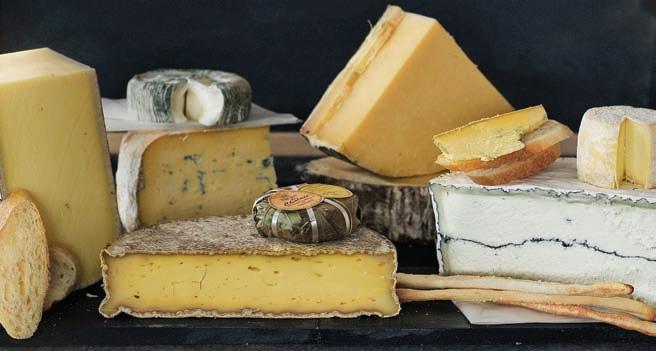
TASTE: Ripe persimmons lend themselves to winter spices, pairing beautifully with cinnamon, cloves, cardamom and ginger.

FUYU: Depending on its level of ripeness, the Fuyu varies from a crisp, mild, pumpkin-like taste to a very sweet date-like flavour.
HACHIYA: Once fully ripe, the texture is pudding-like and the flavour is honeysweet and very robust.
TREND : Persimmons were once only available in ethnic markets but have been slowly creeping into the mainstream. Let’s keep them there.
SUSTAINABILITY: Choose persimmon grown in California, or nearer if you can. Less time on a truck means less carbon footprint and a higher nutrient density when it makes it onto your plate.
PREPARATION: As its rich colour suggests, persimmons are nutrient-rich and boast high levels of beta-carotene, iron, vitamins A and C. But the lovely flavour also delivers a high sugar content.
DAISY ORSER
Handmade Ethical Local Traditional CURED AND SMOKED MEATS 2032 OAK BAY AVENUE, VICTORIA 250.590.PORK THEWHOLEBEAST.CA CURED@THEWHOLEBEAST.CA 9 FUYU PERSIMMONS BRINGING MEAT & CHEESE TO THE PARTY SINCE 1997 OTTAVIO ITALIAN BAKERY & DELICATESSEN 2272 OAK BAY AVENUE (250 592-4080 OTTAVIOVICTORIA.COM
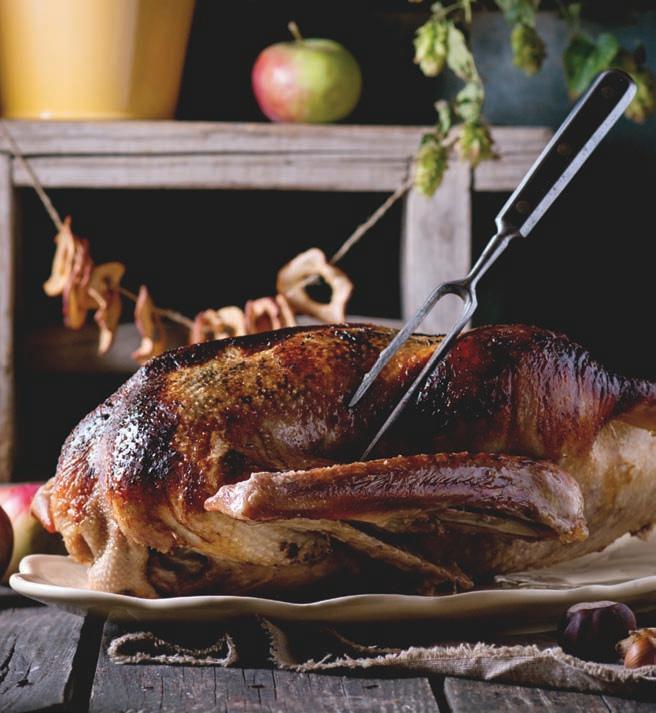






















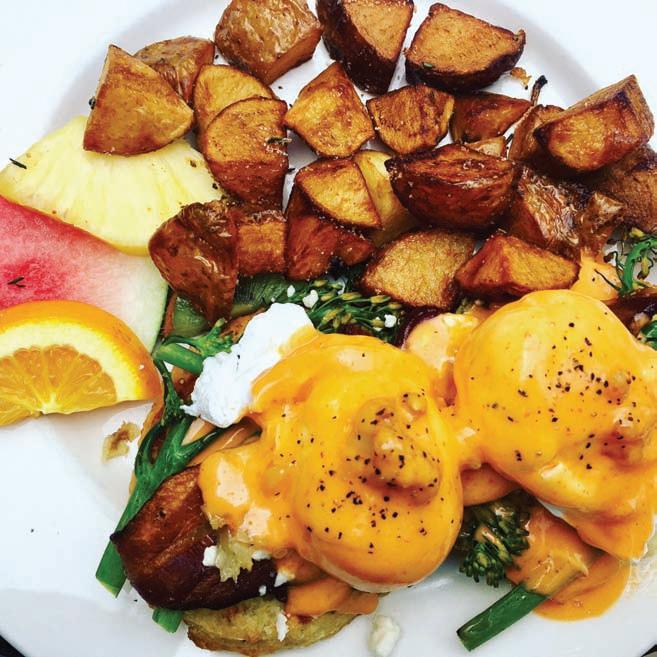









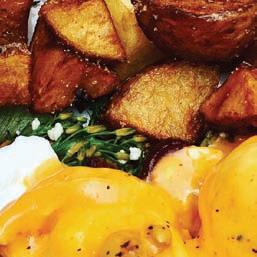




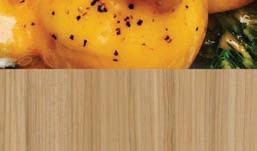




10NOVEMBER/DECEMBER 2017 SHERRI MARTIN HAPPY HOLIDAYS 2032 OAK BAY AVE BREAKFAST - LUNCH - DINNER - EVERYDAY this coup a FREE FREE 355 Cook St. - BubbysKitchen.ca - 250-590-8915 Fresh, all natural, made with love. F COOKIE
HOLIDAY HEROES
FROM A NUTRITIONAL PERSPECTIVE, MOST FESTIVE FARE is viewed negatively. However, if you look at all the individual foods we typically consume over the holidays, some are worthy of superstar status when it comes to health benefits. Here are my top four “holiday heroes”—seasonal favourites you can enjoy with impunity. Be sure to include them in your festive menus. You’ll be doing your body and palate a favour.
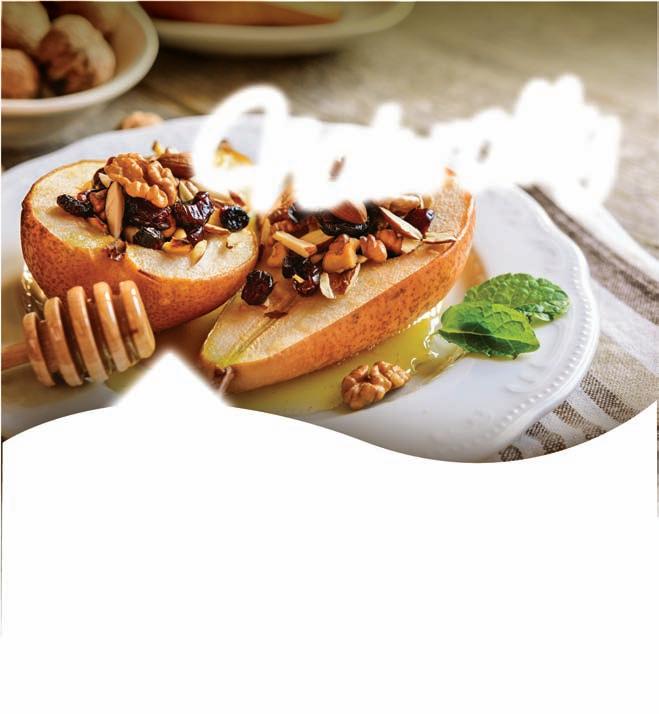
BRUSSEL SPROUTS
No longer the vegetable of childhood nightmares, Brussel sprouts are now the new “it” vegetable. There’s good reason for their rise in status. The hated sprouts of yore were actually a hybrid variety developed by growers to make machine harvesting easier. Thankfully, that unpalatable breed has been abandoned, and growers now use plants that yield sweeter tasting sprouts. In addition, modern cooks are preparing them in ways that bring out the vegetable’s delightfully robust flavour. “Boiling-till-mush” has been replaced by roasting, braising, sautéing and glazing. Taste aside, Brussel sprouts are packed with B-vitamins, vitamins C and K, potassium, fibre and plant chemicals like sulforaphane that provide protection against major-league diseases like cancer and heart disease. Get the whole family gobbling them with relish by preparing them à la Grant Gard, chef and co-owner of Part and Parcel. “I like to deep-fry them (halved) in grapeseed oil, over high heat until crispy and golden brown—then toss them with lemon juice and salt,” he says.


CRANBERRIES
This holiday staple makes its way into our diets every year—then gets forgotten once the festive season is over. That’s a shame because this tart little berry has much to offer when it comes to enhancing our health and our meals. Teeming with vitamin C, manganese, potassium and fibre, cranberries also contain a payload of plant compounds like ellagic acid and quercetin that can help prevent everything from heart disease and cancer to urinary tract infections. Even more impressive is the fact that its nutritional might is paired with great taste and a surprising degree of culinary versatility. Heather Cunliffe, chef and co-owner of Be Love, concurs: “The berry’s sweettart flavour marries beautifully with everything from oatmeal to pilafs and sweet roasted vegetables, and, of course, chocolate.” Be forewarned that commercially packaged cranberries, like OceanSpray’s “Craisins,” contain added sugar.



MANDARINS
Mandarins are as de rigueur at Christmas as shortbread—but decidedly healthier. Low in calories but high in nutrition, satsuma mandarins contain a bevvy of key vitamins and minerals, in addition to a class of flavones in their peel called polymethoxylated flavones. These super-flavanoids flavonoids have been shown to lower cholesterol and blood pressure as effectively as prescription drugs. To reap all the health benefits these juicy little oranges offer, employ the whole fruit. Try grating satsuma peel into your morning smoothie or baked goods and marry the sweet flesh with everything from duck breast to trifle.







SQUASH

Winter squash varieties are some of the most versatile and festive vegetables of the fall harvest. They also offer an impressive array of disease-fighting nutrients. All winter squash play host to health-supportive carotenoids, such as beta-carotene and lutein. Studies show these antioxidants can help prevent cancer. If that doesn't impress, consider this—these colourful veggies are chockfull of polysaccharides that have anti-inflammatory and anti-diabetic properties. What’s more— one cup of winter squash provides you with 340 mg of heart-healthy omega-3 fatty acids. Just one more compelling reason to use these beneficial gourds in your seasonal repertoire. As local dietitian Jennifer Letham-Sobkin notes, “There simply isn’t another vegetable with their nutritional might that you can use to make everything from pies to soups and bread.”

11 GOOD FOR YOU PAM DURKIN
Seasonal food favourites you can enjoy with impunity.
Adapt to Survive
The team behind Foo finds opportunity at Victoria’s hospitality crossroads.
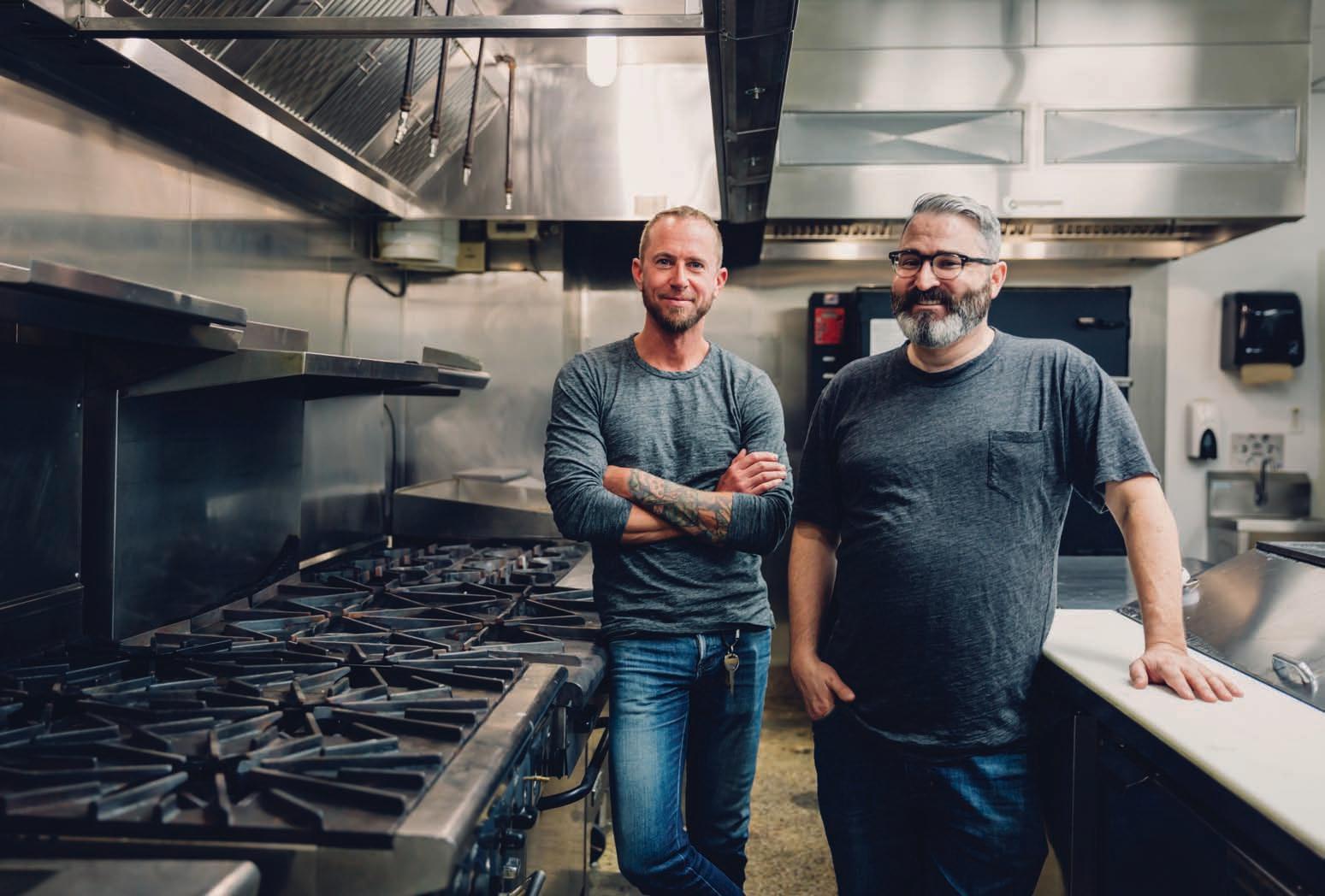 story by DANIEL MURPHY photography by JOHANN VINCENT
story by DANIEL MURPHY photography by JOHANN VINCENT
12NOVEMBER/DECEMBER 2017
REPORTER
PATRICK LYNCH AND STERLING MOORE AT THE COMMISSARY KITCHEN
IT’S NOT BREAKING NEWS: Victoria’s restaurant scene is in the midst of varying states of crisis, depending on which Industry Insider you speak with. Opinions on the timing vary, but there is definitely a consensus that a critical point looms somewhere on the near horizon. Each passing year has seen an amplification of the factors that make restaurants such risky, lowmargin ventures to begin with: commercial rental prices have risen on an incredulous arc; competent staffing has become an impossible gamut for kitchen managers; and there’s a pervasive disconnect between consumer expectation and the very real cost of presenting a plated meal. In the midst of these trials, it’s become a sink-or-swim game, and eateries that tread water just won’t cut it anymore.

Sterling Moore and Patrick Lynch are quietly prominent Victorian restaurateurs. Their first venture, Foo – Asian Street Food, has inauspiciously occupied the parking lot of the Dominion Hotel on Yates Street for more than eight years, providing more sanitary but equally flavourful versions of various Asian-style street foods. A low-margin cuisine by nature, it was always going to be an uphill battle to fill this culinary niche while upholding their personal mandate of ethical, from-scratch dishes, prepared by professionals. It made for a difficult, though sustainable model in its planning and initial execution, but times have since changed—and not for the better. Says Sterling, “When we started out, trying to get a loan, it was hard. I can’t even imagine what that looks like now.” Without the benefit of a relatively low “grandfathered” rent, set prior to the nationwide property spike over the past few years, the traditional “brick and mortar” restaurant model is becoming a consistently higher-investment, higher-risk venture. Another side effect of the sharp increase in demand for liveable and workable space in Victoria is the surge in construction. For every crane on the city skyline, there is a construction team wherein a labourer can earn a good chunk more than he/she would sweating out the long, late hours of the restaurant grind. As Patrick puts it, “In this town, right now, a skilled food-industry worker is somehow worth less than an unskilled construction labourer.” It’s easy for those glaring at “expensive” menu items to frame the situation as some greedy restaurant owner “jacking up the price of food.” And maybe that is a reality for some of Victoria’s dining establishments, but the smaller-scale industry figures that I know, successful in their business ventures, aren’t exactly retiring to their mansions every night. Sterling in particular has vocalized his discontent previously, on CBC Radio’s “On the Island” program (2015), drawing a direct parallel between the percentage of revenue that a small business can viably afford to pay its staff and “people’s totally skewed idea of what food is actually worth.” My suggestion that this is somewhat of a local phenomenon, that Victoria in particular clings to an archaic idea of eternally static restaurant prices, and that we as a city are, in essence, terribly, terribly cheap, is met with diplomatic shrugs. No one wants to offend their potential clientele.

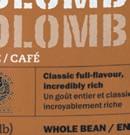















LABOURER










It’s easy game to list the issues plaguing the industry; it’s another thing to create opportunity from the downhill slide. In much the same way that modern app technology has broken businesses down to their fundamental elements, and reconstructed them with more streamlined or direct delivery channels, Foo has been working at ways to restructure the current restaurant/consumer model in ways that are making more and more sense in Victoria’s increasingly challenging market. One significant result is their newest venture: The Commissary Kitchen. Occupying the corner of the Hudson building on Douglas and Herald Streets (the ex-Smoken Bones downtown location), their vision for the new space is a shared creative area for many and varied culinary uses. And a place that strives to ease some of the growing pains facing smaller and start-up food businesses across town.


The workspace is huge: four separate enterprises can comfortably work their stations simultane-

DANIEL MURPHY 13 CONTINUED ON FOLLOWING PAGE
A
CAN EARN A GOOD CHUNK MORE THAN HE/SHE WOULD SWEATING OUT THE LONG, LATE HOURS OF THE RESTAURANT GRIND.
ously. Eighteen gas burners and three commercial ovens dominate the space, but the pièce de resistance, which lights up both Sterling and Patrick’s faces at its mention, is the newly purchased “combi-oven.” The steamer, convection and regular oven all-in-one is fully computer-programmable and also enables production of canned and jarred goods. The $20,000 industrial smoker that is also onsite seems to be unfairly relegated to a footnote.
So, if you build it, who will come? All the equipment above, combined with the mandated infrastructure for a commercial kitchen (grease trap, refrigeration, ventilation, etc.) becomes a limiting prospect for a small, food-based business to acquire on their own, no matter how great their idea. The Commissary Kitchen can greatly reduce that cost for entrepreneurs, whether their project is a traditional restaurant-style eatery, a mobile catering company or, perhaps most relevant to the evolving culinary market, a food truck. Whispers abound of food-truck owners, desperate for affordable prep space, using sites that would never be deemed allowable by BC’s Foodsafe program. The Commissary’s professional standard of equipment, central location and accessibility by loading dock make it a logical landing spot for the ever-increasing number of local mobile-food vendors.
Unsurprisingly, the motivations behind the Commissary project are not entirely altruistic. The founders are still in the restaurant business. The kitchen doubles as much-needed spatial relief for the regularly multiplying Foo endeavours that Patrick notes are all “bursting at the seams.” In 2014, they diversified with Foo Ramen, which occupies a sliver of storefront on Broughton Street (opposite the public library.) Fridays, after delivery of the weekend’s food inventory, both the original Foo and the Ramen bar are an “ongoing game of Tetris.” Not only will raw goods be easier to manage, but the Commissary venue will provide a centralized prep space for both venues, reducing kitchen labour costs. The result: they can afford to keep paying their skilled employees well in an attempt to compete with rival industries, even as rents and food costs continually rise.
The Commissary might also provide an opportunity to execute an idea that’s been in the works for years: a way to cost-effectively package their own line of restaurant-quality, publicly tested Foo sauces and cooking ingredients. The issue stalling the project until now has been that the money charged by the “co-packing” facility (which owns the manufacturing equipment) shrinks smaller-run production margins to pennies on the dollar. “We really don’t know exactly what direction this will go in … but it’s possible we can become the co-packer,” muses Patrick.
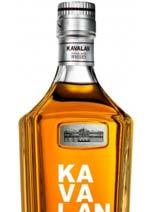


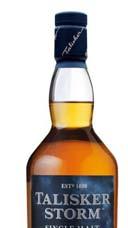


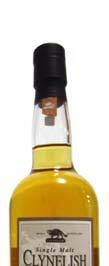
There really is a nebulous—but positive—atmosphere about the project. Among the other potential benefits: combining orders from separate businesses means increased buying power, resulting in more seasonally available ingredients from local farms; existing restaurants will now have an avenue to a “test-kitchen” and the potential to expand their menus; it opens up possibilities for home-delivery through a growing number of online services. It’s a plan born of a communal impulse, wrapped in a truly organic growth model. Says Sterling: “This is our attempt at adapting. Because right now, it’s adapt to survive.”
The Commissary Kitchen is slated to open its doors on November 1 with Foo and Accio Kitchen as the anchor tenants.
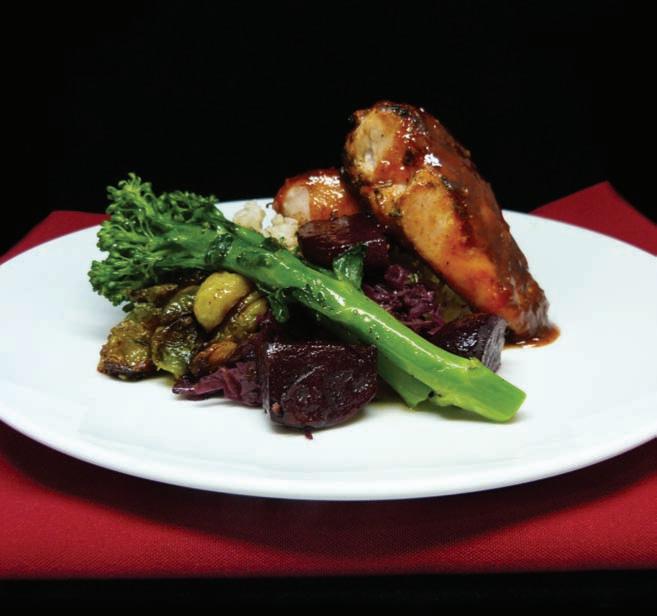
14NOVEMBER/DECEMBER 2017 THE COMMISSARY KITCHEN CAN GREATLY REDUCE THAT COST FOR ENTREPRENEURS, WHETHER THEIR PROJECT IS A TRADITIONAL RESTAURANT-STYLE EATERY, A MOBILE CATERING COMPANY OR, PERHAPS MOST RELEVANT TO THE EVOLVING CULINARY MARKET, A FOOD TRUCK. TRY dozens of new whiskies right downtown receive INcredible members only discounts be part of a community of over 250 local members get invited to exclusive tastings and events join now for free at www.dramassociation.com the strath - ale wine & spirit merchants 919 douglas st VICTORIA’S ENTERTAINMENT CENTRE 919 DOUGLAS ST AFTER THE SHOPPING LEAVE THE COOKING TO US THIS HOLIDAY SEASON
PAIRINGS
Matching Tea, Chocolate & Whisky
SOUR LEMMY
The sleek and modern Terroir Tea salon expands its monthly tea tasting event—with spirit.
chocolate flavours.
Indonesian Silver Needle, with its floral notes, was my favourite tea at the tasting. I also loved the Cacao Hunters Tumaco paired with Silver Needle White Tea. That sample’s unusually swampy terroir and indigenous cacao trees produced an intensely flavoured Colombian chocolate.
A months-long process using fruitwood charcoal produced another favourite tea, the powerful Longan Charcoal Roast Shan Lin Xi High Mountain. I didn’t like the Laphroaig 10’s medicinal nose, but the whisky tasted much better after the Dandelion-Camino Verde Chocolate from Ecuador. Both Dandelion and Upala Costa Rica’s Potomac were rich and nutty over 80% gems. The Brazilian Akesson-Sempre Firme Chocolate was also great when paired with whisky.
It was amazing how the format of tea-whisky-chocolate-whisky-tea tasting enhanced qualities in each of the samples, particularly the whisky after my mouth was coated with chocolate and the tea samples after the whisky.
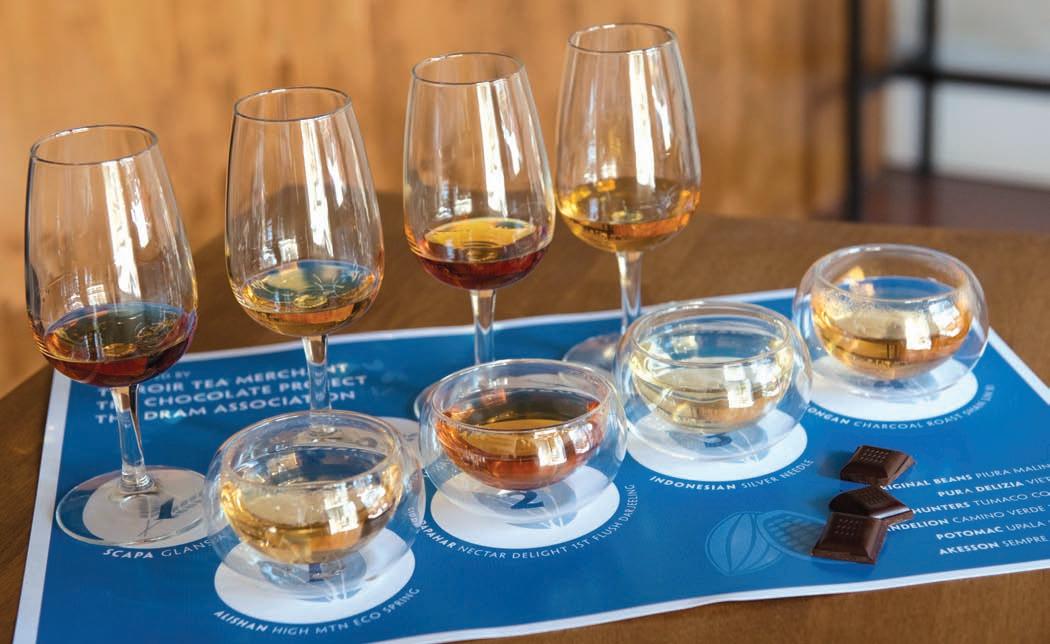
Hobbs and Spencer moved to Australia where she became a certified Tea Master, started an online tea business and helped organize the first Melbourne Tea Fair. The couple moved back to Victoria to be with family, and after extensive renovations to the Fort Street location opened the sleek, modern, 24seat Terroir Tea Merchant two years ago.
“We have eight seats in our urban garden behind the store,” Hobbs tells me from behind the store’s tasting bar. “We want to increase people’s appreciation of pure tea by sharing samples with customers. All of our teas are unadulterated and don’t include blends of fruit or other ingredients, just pure tea.” Hobbs offers me a tall glass of one of the shop’s new world tea specialties, an Arakai Spring Flush, a rare Australian green tea. “We have a tea wheel to help customers develop their palate just like wine tasting, and we encourage people to consider the tea’s growing conditions, time of harvest and processing. We’re very proud of our pure teas. Some, like our Indonesian Silver Needle White Tea, are grown on certified organic plantations that stress biodiversity through companion planting and use of natural pest predators.”
Terroir also has a new liquor license that has allowed the expansion of their monthly tea tasting events. I attended their first licensed tea tasting in September that matched cups of rare new world tea with a half dozen of the Chocolate Project’s equally rare and pure chocolates and four examples of the finest Scotch whiskies presented by The Strath’s Dram Association.
Hobbs began the three-way tasting with a buttery, high-mountain Taiwanese tea, suggesting that we inhale the lightly oxidized tea’s nose and savour the flowery notes before tasting the event’s first whisky, a non-peaty Scapa Glansa. The Strath’s Adam Bradshaw noted the Scapa’s citrus notes, qualities that stood out more distinctly after another sip of the Taiwanese tea and a taste of the 75% cacao Peruvian chocolate offered by the Chocolate Project’s David Mincey.
Giddapahar Nectar Delight, a fruity, sharp-flavoured, first-growth Darjeeling, was followed by my favourite whisky at the tasting, Glen Garioch. The highland distillery’s limited release had a sugary nose and salty minerality, qualities accentuated after tasting Vietnamese Pura Delizia’s dense, earthy
Terroir’s daily menu of 10 tea flights of three light-to-dark samples costs $10 plus $2 if shared. They offer less frequent cold brews that take two to 18 hours to produce and other tea tasting special events like the one scheduled for November 19 at 1 p.m. during which participants will create a chai tea blend and then a cocktail with the blend. Then on December 9, another event at 6 p.m. will feature hot toddies with tea and chocolate tastings.
“We’re hoping to stay open late and create a tea cocktail menu for the pre- and posttheatre crowd,” explains Hobbs. “With our new license, minors are allowed in Terroir at all times. We’ve already participated in the Off the Eaten Track Walking Tour and the EatDrinkPedal Bike Tour. We want to introduce pure tea to everyone in the community.”
Terroir Tea Merchant, 832 Fort St. | 778-747-2739 | terroirteamerchant.com
JOSEPH BLAKE
“I’M FROM A TEA DRINKING FAMILY,” explains Charity Hobbs, the tall, dark-haired co-owner of Terroir Tea Merchant on Fort Street’s blossoming food district. “My parents and grandparents here in Victoria were big tea drinkers, and when my partner Jason Spencer and I travelled we always brought home tea samples from around the world.”
REBECCA WELLMAN
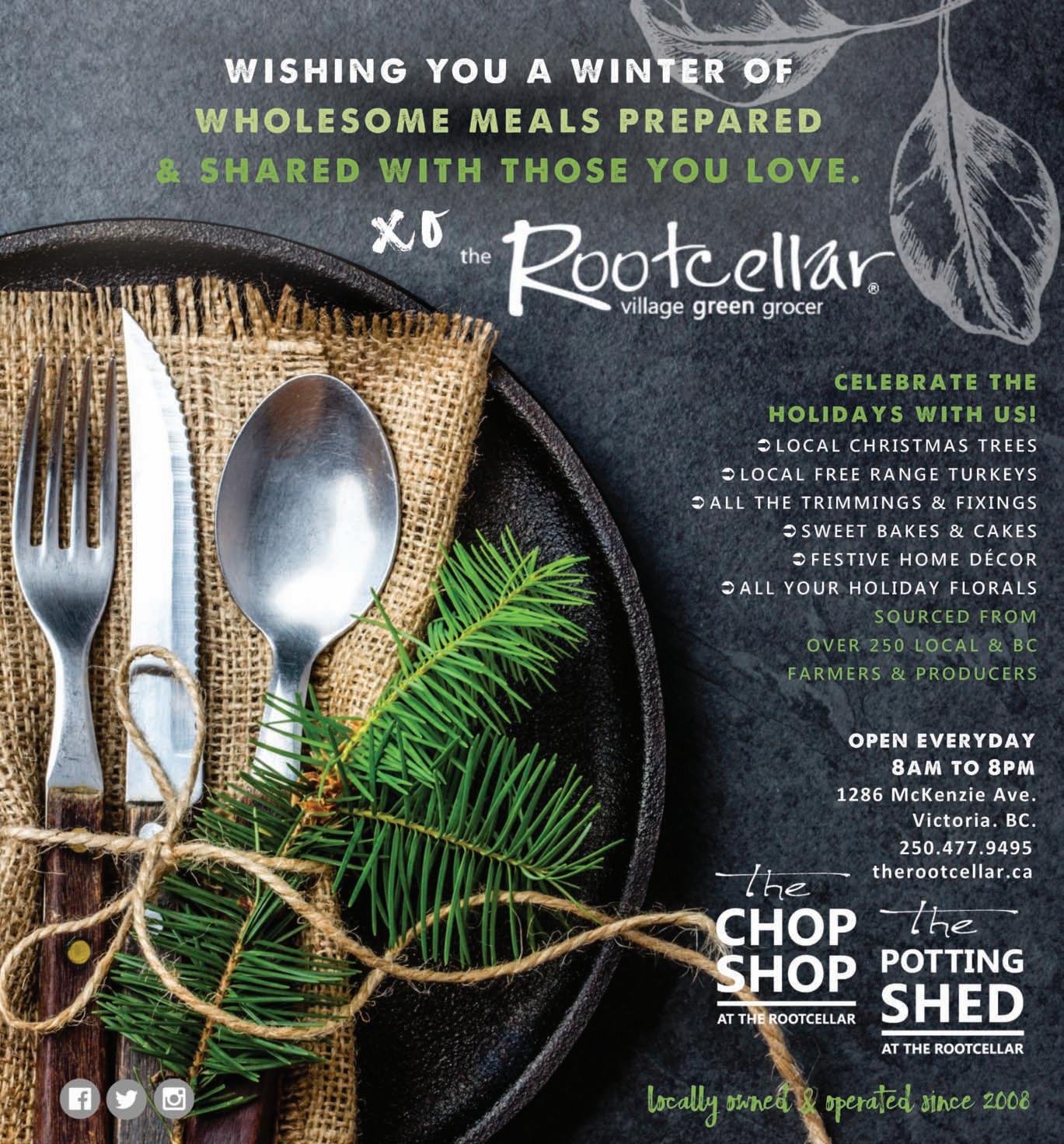
Foxtrot Tango Whisky Bar
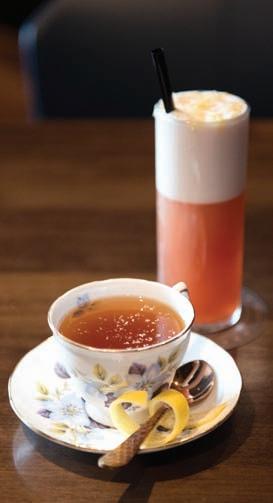
Shawn Soole is back behind his own bar.
At barely 37, Soole has already ticked most of the boxes in the bartending business. He was an award-winning barman in Australia before landing here and pioneering Victoria’s cocktail scene at Clive’s Classic Lounge, Little Jumbo and now, his newest venture, Foxtrot Tango Whisky Bar.
It’s a small but ambitious place, where whisky rules and cocktail geeks will find the very latest technique in molecular mixology laid over classic recipes. Consider the Pimm’s 2023 Cup, complete with clementine tea-infused gin and a spear of frozen cucumber water, or the $400 Rat Pack Sazerac featuring 1934 Armagnac, Aged Peychauds and Lucid Absinthe, possibly the most expensive cocktail in town. These are what Soole calls “elevated cocktails.”
For another $400, you can also become a FTW Devil’s Dram club member. It comes with your personalized “challenge coin” that lets you jump the queue to a seat in the bar’s private back booth and affords other privileges, from access to their “secret spirit list” of rarities and monthly whisky tastings, to a bottle of Tattinger champagne to celebrate your birthday.
The space is one Soole says he has had his eye on for years. Its former incarnation— Doubles Lounge—is in evidence in the dark, coffered ceiling beams and plush, tufted booths, giving FTW a kind of vintage patina that channels Soole’s inspiration: 1950s Hollywood.

“We want to create a very special style and ambiance,” he says, “dark, classy, seedy, with Ella and Sinatra on the stereo.” Add sleek new furnishings and lighting, and “the lab,” where you’ll find them cooking up all kinds of things, from 12 boozy housemade infusions to 22 unique syrups, is a creative cocktail bar.
“We have nine different types of ice,” says Soole, yanking open a couple of freezer drawers filled with giant, hand-chiselled chunks of crystal clear ice, crushed star anise and orange flower ice and golden cubes of pineapple ice for the “Rickey,” made with Tanqueray Rangpur, Chinese 5-spice syrup, lime acid, ginger bitters and juniper-infused soda.
While no food is served here, the drinks are as complicated as many plates. Summer Lovin’ combines rosemary-infused Aperol with Prosecco and a housemade Campari Orange popsicle. Equipment like a centrifuge and edible ink printer (to add logos to foamy flips), adds “a culinary take on all drinks.” The Clandestine Ruski is what Soole describes as a clarified version of “The Dude’s” drink (a reference to Cohen Brothers' cult film The Big Lebowski and Jeff Bridge’s character (The Dude) who famously drinks (many) White Russians).
“We took 20 or 25 top cocktails from the 1950s and elevated every component,” says Soole, adding, “Every cocktail comes with a shot of Prosecco” to clear your palate for the next sip.
Soole has partnered with Shane Clarke and Jill Tulloch of Clarke & Co. (both talented bar chefs themselves) to open FTW. It’s open at 6 p.m. daily and already there are lineups at the door opening into the lower lobby of the DoubleTree by Hilton Hotel.
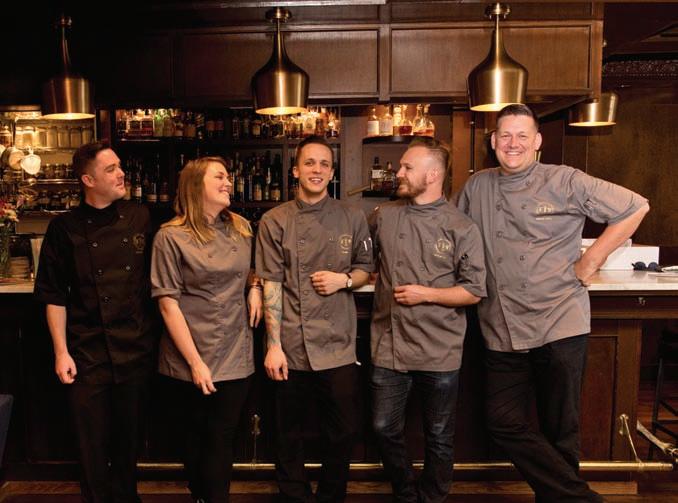
Adding up all of the late nights and long hours he’s spent behind the bar, Soole says it sometimes feels as if he could add another five years to his work history and should hang up his shaker. But with a young team of keen 20-somethings at FTW (Marlee Baxter, Jared Wegenast, West Bourget), his enthusiasm for bartending remains strong.
“It’s sort of my return. I’m not done yet. FTW—for the win.”
CINDA CHAVICH
722 Humboldt St, VICTORIA (250) 340-3126 | FTWBAR.COM
FROM LEFT TO RIGHT: The FTW team - Alastair Ferguson, Marlee Baxter, Jared Wegenast, West Bourget, Shawn Soole.
ABOVE: One Inch Punch (teacup) & Fizz Sloely Now
REBECCA
ABOVE: The FTW interior
WELLMAN
Cereal’s Weird History
Text: Adrian Paradis Photos: Rebecca Wellman
AND WHAT VICTORIA CHEFS HAVE TO SAY ABOUT IT.
While civilizations have been eating some form of hot porridge breakfast for millennia, cold cereal is a relatively new invention. But ever wonder why an entire aisle of the grocery store is devoted to these brightly coloured boxes? Though it might seem innocuous, that milky sweet bowl of cereal we hurriedly consume has a bizarre history of religion, rivalry and spa therapy.
In 1863, a health sanitarium in western New York became the birthplace of modern cereal when James Caleb Jackson devised a hard, graham-flour breakfast cereal he called granula (notice the u). The idea caught the attention of John Harvey Kellogg—yes, the same Kellogg on your box of Special K—who at the time was running a different sanitarium out of Battle Creek, Michigan. Kellogg developed his own version of the cereal that, unlike Jackson’s, did not resemble a brick-like substance. In a moment of “clever” marketing, Kellogg called his product granola. Later, Kellogg’s former patient at the sanitarium, C. W. Post—yes, the same Post on your box of Honey Bunches of Oats—came up with his own version of cereal called Grape Nuts. Thus, the battle for cereal supremacy was born.
But for Jordan Roberts, co-owner at Rise and Grind Coffee and Eats on Broad Street, cereal is all about the short-term history found in nostalgia. “People are surprised, but in a happy way, when they see the cereal bar,” he says, referring to his curated selection of cereals geared towards ’90s sentimentality. “No one is thinking, ‘finally someone is doing this!’ But a lot of people get that nostalgic feel.” For Roberts and his co-owners, growing up in the pre-millennium decade was a bombardment of non-stop cereal commercials.
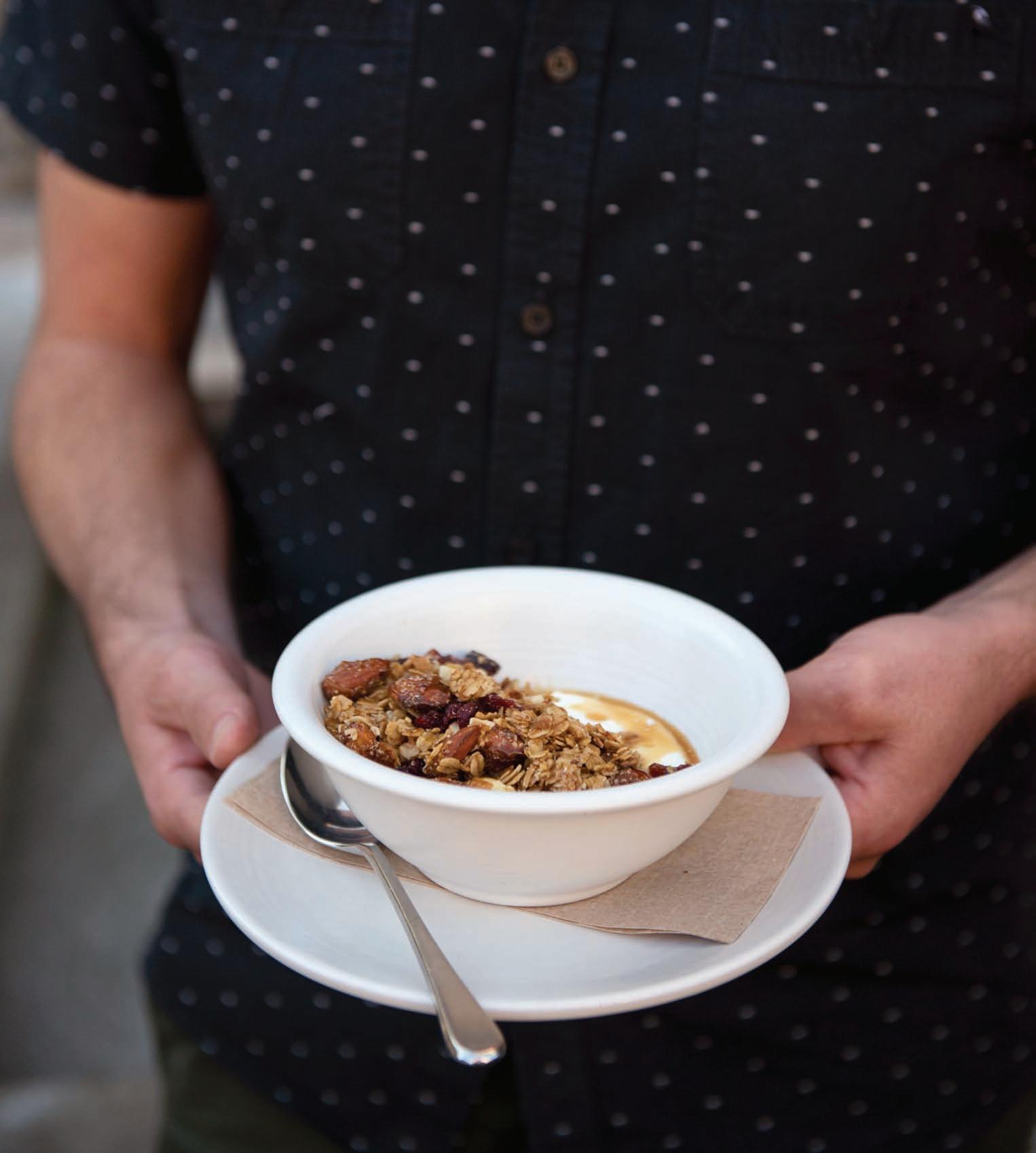
18 NOVEMBER/DECEMBER 2017
PEOPLE LIKE LUCKY CHARMS WITH ALL ITS MARSHMALLOWS OR CINNAMON TOAST

CRUNCH. THE ONES THAT ARE GARBAGE.

it

2018 ROASTER OF THE YEAR
“It seems to be the forbidden fruit ones that are popular,” says Roberts. “People like the Lucky Charms with all its marshmallows or the Cinnamon Toast Crunch. The ones that are garbage. I like Honey Nut Cheerios or Rice Krispies, but no one seems to be eating those.” Despite cereal’s roots as a health product, for Roberts it’s all about the child-like pursuit. “It’s not meant to appeal to kids in any way,” he says. “It’s meant to appeal to the kid inside you.”
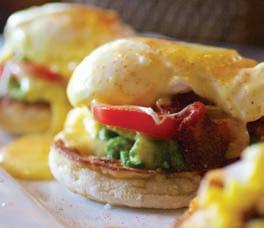
In the 1800s, prior to Jackson’s discovery of granula, a typical breakfast would more resemble a substantial dinner by today’s standards. Meats such as pork, lamb or beef would not be uncommon along with hot oats, potatoes, toast, fruit and, of course, coffee. At his health spa, however, Jackson advocated removing red meat from his patients’ diets. Rather, he focused on fruit, vegetables and unprocessed grains. It was with this in mind that he devised his breakfast cereal as a healthier alternative to the typical, protein-rich first meal. These views rubbed off, particularly on one of Jackson’s patients, Ellen G. White, who brought these ideals of vegetarianism with her when she went on to be a founder of the Seventh-day Adventist Church. She in turn influenced Kellogg’s dietary choices (and religious views) when she became his patient in Michigan. While much of today’s cereal is more like candy than breakfast, granola seems to have retained its image as a healthy product. Jessica Duncan, owner of Singing Bowl Granola, has a history
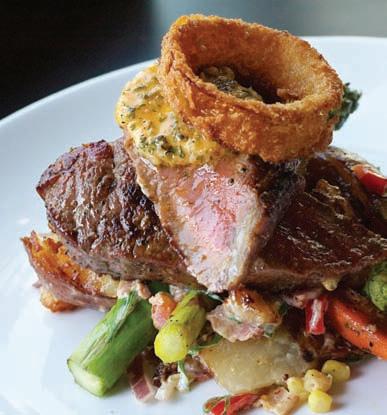
19
CONTINUED ON FOLLOWING PAGE
LEFT: The house made granola at Agrius.
ABOVE: A bowl of Lucky Charmes at Rise and Grind Coffee and Eats.
JORDAN ROBERTS, RISE AND GRIND
We are thrilled to announce that was this years recipient of Roast Magazines annual award for 2018. Roast Magazine presents this award annually to North America’s top roaster of over 100,000 lbs. We are thrilled to Pilot, Propeller
was our that took home website. Please visit for more details.
with this product all to herself. “I used to be a teacher,” she says. “At 8 a.m., I would get a classroom full of kids totally cranked up on chemicals and sugar. Then they would crash before going out to have a snack of chemicals and sugar again.” In 2011, Duncan abandoned her teaching career for one making healthier breakfast options.
“Looking at granolas on the shelf,” she says, “they are mostly filler. This makes it more affordable. But for me, it had to be real ingredients with no sugar. You can bet your boots I’m not making as much money because I’m using organic, ethical ingredients, and because I can’t use cheap, crappy ingredients.” While commercial cereals have a reputation for being junky, granola today still invokes healthier associations of hiking, outdoor living and down-to-earth hippy culture. “In the ’70s, we all started making our own granola,” Duncan says. “We dropped out, went back to nature, started making our own yogurt, granola and wore Birkenstocks.”
Where, then, was the divide between the health spa diet and coloured marshmallows? Historians have often pointed to the other Kellogg brother, Will Keith Kellogg. He was Battle Creek Sanitarium’s bookkeeper, and when his brother developed the granola recipe they went into business together. Will, however, was a shrewd businessman. After the brothers stumbled upon a method for making Cornflakes in 1894—a complete fluke—previous patients of the sanitarium began requesting them by mail. Will insisted on adding sugar to their recipes to appeal to a larger audience and also packaging their products for grocery stores. John was appalled by Will’s suggestions, believing this commercial nature would undermine his medical integrity. But by 1906, Will Kellogg had bought out John’s portion of the company and begun aggressively adverting their products.
So while Cornflakes seem to be the missing link in the evolution from health product to marshmallows, cereal’s healthier cousin, granola, still remains today. Heather Cunliffe, co-owner and chef at Café Bliss, stays true to granola’s healthy roots by making hers with sprouted buckwheat, puréed apple and dates before dehydrating it all for two days with no refined sugar in sight. “Cereal is such a common thing to eat for breakfast,” she says. “With anything that becomes common, the market gets carried away with all the possibilities of how to make the product different and cheap. That’s a huge driver. People will buy the cheap version, and you can’t make something cheap without adding low-quality ingredients.”
Cunliffe points out that the industrialization of food saw many producers turn to quicker, cheaper methods. “At a certain point, in the ’60s and ’70s,” she says, “there was a return to a mentality of making healthy versions. It was the hippy movement that brought back healthy granola.”


Cliff Leir, owner of Agrius and Fol Epi, sees himself at the middle of the road in the argument about sugar and healthy granola. “With most things we do here,” he says, “it’s all pretty standard, but the ingredients we use make it interesting.” Their in-house granola, for instance, is made with caramelized sugar—in order to hit those bitter notes as well as the sweet ones—and singlesource maple syrup. When asked if he considers his granola healthy, Leir says, “I get this question a lot. Not just about the granola, but about the bread, and the croissants, everything. I think it’s important to bring up the whole notion of health and what is healthy. One thing I feel very strongly about is that it’s healthy to enjoy our food.”




Leir is an advocate for moderation, feeling that most foods are not inherently bad when enjoyed in balance with others. “For a lot of people, sugar is the devil,” he says. “That’s why I’m reluctant to say our granola is healthy. To some people, it’s not healthy because it has refined sugar, but it also has whole grains, oats, cranberries and almonds.” Leir attributes cereal’s popularity to its variety, as well as the textural sensation it gives. “The crunch in cereal is really satisfying,” he says. “In natural versions, you have to eat it super-fast. Otherwise it’s just soggy mush. Maybe that’s why granola is also nice that way because it’s got that crunch to it.”
Today, the excitement surrounding cold cereal has yet to subside. In 2014, the Kellogg Company, now a multinational operating in 180 countries with dozens of subsidiaries and revenues of $14.8 billion, still operates out of Battle Creek. While the company may have come a long way from its origins, the influence of modern day cereal still runs deep. Everyone may have their favourite breakfast, whether it be healthy or junky, but it seems almost a given that cereal will have been a part of your morning at some point. Confession time: I try to be a healthy person, but standing in the cereal aisle, the temptation of forbidden fruits—or more accurately Froot Loops— gets me every time.
20NOVEMBER/DECEMBER 2017
THE WEIRD HISTORY OF CEREAL cont’d
WOMEN WHO LAUNCH








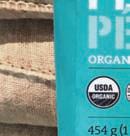









Les Dames d’Escoffier’s BC Chapter celebrates its good work.
 BY REBECCA BAUGNIET
BY REBECCA BAUGNIET
EVERY ONCE IN A WHILE, IT IS A PLEASURE TO BE REMINDED OF THE QUIET but powerful forces for good working within our community. On a late summer’s afternoon, I had the opportunity to encounter one such positive force at Sea Cider Farm and Ciderhouse, where the annual Summerdine luncheon was being presented by Les Dames d’Escoffier’s BC chapter (LDBC). Les Dames d’Escoffier is, according to its website, a “leadership culinary organization composed of women who have not only achieved success in their professions, but who contribute significantly to their communities.” The organization was launched internationally 35 years ago to honour the legacy of Auguste Escoffier, the French chef, restaurateur and culinary writer who was instrumental in making the world of fine dining accessible to women at a time when it had only been hospitable to men. The BC chapter has been active for 25 years and is currently the only chapter in Canada. Throughout Summerdine, familiar faces from across our local culinary community greeted me. First it was Daniela Cubelic, founder and owner of Silk Road, who welcomed those of us on the shuttle and gave an eloquent introduction to the organization, sharing the many ways in which Les Dames d’Escoffier has been advancing women’s opportunities in the culinary sector, telling us how “things change when women are at the head of the kitchen and brought to the decision-making table.” On the bus, I recognized Ceri Barlow, of Pacific Wine & Spirits, and Tara Black, co-owner of Origin Bakery. Kristin Needham, founder and cidermaster at Sea Cider, graciously received guests while Frances von Aesch from Zambri’s (who received her scholarship to complete her sommelier course from Les Dames 16 years ago) served cocktails. Ali Ryan, chef at Spinnakers, led the kitchen team, assisted by Dawn Schultz, food and beverage manager at Kingfisher Oceanside Resort in Courtenay, who had made the trip down in appreciation of her two LDBC scholarships. The entire event was driven by volunteers— women whose careers had been positively impacted by this organization and were more than happy to give back with their valuable time and expertise.

A few weeks later, I met with Ann Brydle, general manager at the Quadra Village Cascadia Liquor store, who had just returned from a four-day experience at the Chateau Ste. Michelle winery, an 87-acre estate that hosts 300,000 visitors annually at their summer concert series, culinary events, tours and tastings. Brydle was the recipient of a Dames d’Escoffier International’s Legacy Wine Award, one in a series of awards designed to provide targeted mentorship opportunities for professional women in food, beverage and hospitality industries who are not already part of the organization. She explained how her award paired her with a member of the Seattle chapter, Kari Leitch, senior vice president of communications and corporate affairs at Chateau Ste. Michelle Winery. She was able to experience every aspect of the winery, meeting staff in each branch of operations, from the VP to the assistant wine maker, director of education, sales team and more.
When asked what was most valuable about the internship, Brydle said her favourite part was spending a day with the sales team in the on-premise restaurant and grocery stores. She described an enriching and inspiring trip exploring each part of the wine industry process, from the vineyard to the bottle. Seeing each stage helped her identify what it is she’s most passionate about in her own work and how she can build on those skills.

It is no surprise that many members of Les Dames d’Escoffier’s BC chapter are also active with the Island Chef Collaborative. The ICC is another example of a powerful force for good working in our community. In recent years, the organization has shifted its focus from grants to micro-loans, providing crucial support to growers, harvesters and processors whose work increases food production on Vancouver Island. In the past five years, the Collaborative has backed 35 loans, with at least six repeat recipients and not a single default in that time. Keep an eye on the City Eats column, where EAT will be featuring ICC micro-loan recipients as they are announced. For more information on Les Dames d’Escoffier BC and the Island Chef Collaborative, visit their websites: lesdames.ca and iccbc.ca

21
Haus Sausage Company


FACEBOOK.COM/HAUSSAUSAGECO/
SHANE HARWOOD AND KYLE CLAYTON, OWNERS OF THE UPSTART artisan meat company Haus Sausage, are used to grinding away in the kitchen. Shane had put some time in with Stage Wine Bar, and Kyle, fresh from culinary school, posted up at Cordova Bay Golf Course. It was always the meat they were attracted to—how to cure it, grind it, slice it, trim it and stuff it. It is a versatile medium that lends itself well to creative minds and hands eager for some hard work.
Shane started working with meat at Thrifty Foods but took on some side jobs breaking down game for hunters. When he moved into the Oak Bay neighbourhood, he walked into the Whole Beast where Cory Pelan saw fit to hire him as a meat cutter and teach him the finer points of sausage making. Kyle joined him soon after to oversee the drying room, and it was there that the two would find some common ground.
After work, Shane and Kyle would hit the gym, then spend a couple hours in the sauna discussing adventures in meat making, honing some of their better ideas over a few pints afterwards. A couple of years, a few more steams and a lot more beers later, they finally decided to pull the trigger—as the picklers. Yes, you heard that right. When they launched the company it was all about the stuff that goes alongside of meat: sauerkraut, kimchi and pickles.
“We wanted to be the Pickle Guys at the farmers’ market,” says Shane. Having laid their hands on a few good ceramic German crocks, they set about making their wares. But at the last minute they decide to make a few sausages to bolster the variety at their table. “We started by making 300 pounds of sauerkraut and kimchi at the beginning of the summer and it was a total nightmare,” says Shane. Fermenting stinks and storing it can be a huge job. Both of their wives were pulled into the fray to get things under control. The sausage business, on the other hand, was far more manageable and something both partners knew and loved well. “After we got hooked up with Two Rivers Meats we shifted to completely sausages.”
Haus Sausage had a solid debut this summer at the Esquimalt Farmers’ Market by featuring locally raised meat and some interesting flavours that change week-to-week depending on ingredient availability. Some of their more daring interpretations include beet, blue cheese and sriracha, and a breakfast sausage flavoured with fig, rosemary and Limoncello. That said, Kyle has to laugh as he describes how they finessed some of these more intense flavours. “Experimenting leads to eating a lot of bad sausages.” But that’s just part of what it takes if you’re going to make your mark in Victoria’s surprisingly competitive butchery scene. Sticking to one key product and keeping things fresh, interesting and in demand has helped to earn them the reputation of Victoria’s go-to sausage guy’s. With market season now in our rearview mirror, you might be wondering where you can get your hands on a pack of their much- sought-after sausages. Fear not, because the boys are launching a subscription delivery service. To get in on a weekly sausage surprise, shoot them an email at haussausageco@gmail.com. - JILL VAN GYN








Fire to Fork: The Firefighters Cookbook








Local restaurants, stores and chefs got behind this book in a big way by donating over 75 appetizer, main course and dessert recipes. There’s everything from Crab Pakoras (Blue Crab) to Beef Short Rib Chow Mein (Foo) to Chocolate Brownies (Canoe) ...and everything in between. There’s even a section on “Feeding the Firefighters” by Shelora Sheldan. Plus beautiful photography from Rebecca Wellman and editing and design volunteered by the EAT Team.
Pick-up a copy at Country Grocer or at local fire halls. It’s for a really good cause. $29.95
22NOVEMBER/DECEMBER 2017
A Fundraiser for the BC Professional Firefighters Association Burn Fund THE FIREFIGHTERS’ COOKBOOK Recipes Vi ctoria’s Best Restaurants & Chefs From
A Fundraiser for the BC Professional Association Burn Fund
The Ethics of Eating: Making an Impact Third in a Four-Part Series
At the Blue Heron Advisory Group of CIBC Wood Gundy, we are passionate about investing our clients’ money in a socially responsible and sustainable way. That is why we dig deeper into local and global issues, and choose investments that align with our client’s environmental, social and governance (ESG) values.

way CIBC W









Less than half the carbon emissions, better returns than the benchmark, and no need to build a seven-car garage. These are the results of making a deliberate choice to do something differently.
he tool we use to calculate CO2 emissio —t onnes of CO2. in t olios, can o portf
s (E h our client’ wit cho .
For example, when we look at the impact of our Blue Heron ESG Leader investment portfolios, we can measure the owned carbon emissions of a portfolio in tonnes of CO2. According to the MSCI ESG Carbon Footprint Calculator1—the tool we use to calculate CO2 emissions—when compared to a $500,000 investment in the blue chip S&P TSX 60 index, the same investment in our Blue Heron Canadian ESG Leader portfolio has a carbon emissions reduction equivalent of taking more than seven cars off the road2.
inve me SX sa T ns—when compared t he Calcula t to
road
This reduction in carbon emissions also came with a performance benefit:
SG) s s that . ustainable reparing • P
ose investment icidepest
deliberate stment in our Blue a $500,000 o Carbon f a
can make choices t beef Canadians have three t have a substant f ou can Y help?









.



Blue Heron Canadian ESG Leader (CAD) – Composite Performance Summary



Inception Date: Nov 2013








As of June 30, 2017

1 Year 3 Years Since Inception
Composite Returns 14.81 10.30 12.66
Benchmark Returns (Canadian Focused Equity IV Ind) 13.21 7.04 9.65
Difference +/- 1.60 3.26 3.01

1 MSCI “Carbon Footprinting 101” https://www.msci.com/www/research-paper/carbon-footprinting-101-a/0229050187
2 MSCI Inc “MSCI ESG Carbon Footprint Calculator.” https://esgmanager.msci.com/
3 Wikipedia “List of countries by GDP (PPP) per capita” (https://en.wikipedia.org/wiki/List_of_countries_by_GDP_(PPP)_per_capita)
4 OECD Data “Meat consumption” (https://data.oecd.org/agroutput/meat-consumption.htm)

g differently in choice to do someth T. hese choices can Tissues. umers we e cons W capita n. For instance, . Our individual choices can ootprint e to fortunat
imes perso o ial t
hat
You may be wondering—how can you help? As Canadians, we are fortunate to have a large economic and environmental footprint. Our individual choices can have a substantial impact relative to the average person. For instance, Canadians have three times the global average GDP per capita3 and eat 2.7 times the global average amount of beef4. We believe that as consumers we can make choices that have an impact on important issues. These choices can help reduce carbon emissions from transport and storage, minimize water and pesticide use, and prevent soil erosion. Consider:
• Preparing more food at home
• Eating fewer dairy products
• Upgrading to energy efficient appliances
he Blue Heron At t , ood no need to build a anLess th That is hese are th T seven-car garage e bette half than g a in e results of mak e an thanrns th r retu d hisT
• Eating wild fish that are not endangered
• Drinking fewer soft drinks
• Eating seasonal and local fruits and vegetables
• Eating fewer packaged snacks and junk food
• Drinking less bottled water
• Walking to your local farmers market or grocery store
• Eating less beef, pork, and lamb
Admittedly, we do not have a spreadsheet to say exactly how much less carbon is consumed by making these choices. There are, however, some excellent online resources that show the impact of our food choices like: http://shrinkthatfootprint.com/shrink-your-food-footprint\.
ood http://shrink excellent , some ere to adsheet
alking • W e consumer choices liberat
We believe we can all have an impact by making deliberate consumer choices to do things differently.

Neil Chappell and Graham Isenegger are Investment Advisors with the Blue Heron Advisory Group of CIBC Wood Gundy in Victoria.
Want to reduce the carbon in your investment diet?
P +/-erenceDiff ocusedF Footp 2 https://www.msci.com/www/ grintinFootp Equity IV Ind) earsY ear 1 Y erformance Summary r.m https://esgmanager.msci.c Calculator.” r.” rint 01-a/g-1rintin www/research-paper/carbon-footp 3.01 9.65 12.66 dif belie ootprint.com/shrink-your-fo online resources t .msci.com/ 01-a/0229050187 .lyf erent de ve we belie od-footprint\. hat ( “Meat CD Data 4 OE ipedia.org/wik /en.wiks:/http ( s of countrie “List ikipedia 3 W ecd.org/agroutp consumption”/data.os:/http i/List_of_countries_by_GDP_(PPP)_per_capita) f C upGro meat-consumption.h s_by_GDP_(PPP)_per_capita) ictoria. d V Victor Woo are Investment pell r Advisory ry on s with the Blue Her Advisorrs guide in companie , L You RANIES A B P www OR COMP s start a conversation. et’ our .blueherongroup choosin sit orical r the hist management investment AMA W ood clie W ood W CIBC W strategy AMA A st g an eturns. Blue Heron Canadia her in ot orldW of CIBC W World Markets Inc.'s belie rld Markets Inc., o i fs, opin orld nt, please a s of risk. It ments certain vestAll in n portfolio s performance these fees and expenses. ’ dividual account . Each in astP formation, in This in ions ons or recommendations. ents opin the Canadian In Blue Heron Advisory Group | (250) 361-2284 w object to revie g any opin cludin formation, in This in dicative of future results. P in ion, based on various belie g any opin cludin those of Chappell Graham not Indust ection Fund and Investment Povesttror y needs, t olerance, liquidit ives, risk t ion, is based on various sources belie dicated rates of return are he inT erformance returns are o it ved t Canada. If ation of f ry Organiz egulato ry R Indust ax ved s
23
degree of risk. It is important to review objectives, risk tolerance, liquidity needs, tax
CIBC Wood Gundy is a division of CIBC World Markets Inc., a subsidiary of CIBC and a Member of the Canadian Investor Protection Fund and Investment Industry Regulatory Organization of Canada. If you are currently a CIBC Wood Gundy client, please contact your Investment Advisor. The comments and opinions expressed herein are those of Neil Chappell and Graham Isenegger and should not be considered representative of CIBC World Markets Inc.'s beliefs, opinions or recommendations. This information, including any opinion, is based on various sources believed to be reliable, but its accuracy cannot be guaranteed, and is subject to change. © CIBC World Markets Inc. 2017. Past performance may not be repeated and is not indicative of future results. Performance returns are gross of AMA investment management fees, and other expenses, if any. Each individual account’s performance returns
will be reduced by these fees and expenses. The indicated rates of return are the historical annual compounded total returns. Inception date for the Blue Heron Canadian portfolio is November 2013. This information, including any opinion, is based on various sources believed to be reliable, but its accuracy cannot be guaranteed and is subject to change. All investments carry a certain
consequences and any other considerations before choosing an AMA strategy.
Your questions about your portfolio deserve thoughtful answers. Let’s start a conversation. BETTER COMPANIES MAKE FOR
www.blueherongroup.ca Blue Heron Advisory Group
In this simple guide, we explain how we find better companies to invest in. Ask us for it!
| (250) 361-2284
SG equiva Heron Canadian E
of f however eadsheetspr , dlyy,
The Middle Eastern food scene in Victoria continues to blossom with the addition of Superbaba on the site of the former PIG BBQ at Johnson and Blanshard. The atmosphere is open, airy and unreservedly ’80s ironic. I really like the bright pink accent wall and vow to wear a sideways ponytail the next time I come. The menu has three main categories: sandwiches, bowls and sides. I highly recommend sharing the fried cauliflower for $9 as a starter. The cauliflower is brined in vinegar, sugar, salt, turmeric and lemon zest and then deep-fried to a golden brown. It’s almost a shame to hide the colour by dipping it in the accompanying beige tahini sauce, but the flavour combination is excellent.
This cauliflower reappears in a supporting role in the Falafel Sandwich for $9—a complex meal for this price. The pita is made fresh every day in an on-site wood stove and is a highlight. In this sandwich, it wraps around chickpea falafel that is vibrant green thanks to the seasonings of parsley, cilantro and dried mint.
Chopped tomatoes, pickled cabbage and sumac-spiced onions add even more texture and colour. The sumac, derived from a Middle Eastern berry, turns the onions a bright pink.
The next menu category of bowls (“mujadra” would be the traditional name) offers proteins on a grain for $9 to $10, or on a salad for $10 to $12. The steak bowl has very tasty kebab-spiced grilled steak drizzled in a sauce called “shug”: this is basically a Middle Eastern salsa verde of cilantro, serrano peppers, onion and garlic. It also comes with hummus, housemade pickles and sumac onions. This rice base, a tasty dish all on its own, is mixed with lentils and spices. This is a space for a quick, fun meal while bopping to ’80s music.


NOVEMBER/DECEMBER 2017 EATING WELL FOR LESS SMALL WORLDS Take away or eat in at these little gems featuring traditional comfort foods and foods from West Africa and the Middle East. Superbaba 1325 BLANSHARD ST., VICTORIA | 250-590-2725 | EATSUPERBABA.COM
QUICK, FUN, DELICIOUS
Sabich Bowl: Tempura eggplant, six minute egg, cucumber, tomato, pickled carrot, tahini, shug, and amba.
Background: Shawarma spiced grilled chicken thighs, fries, cabbage, pickled turnips, and sumac mayo.
NYLAND 24 BOWLS Sabich Fries with Sumac Mayo (+$4.50) $1100 + TAX
ELIZABETH
Le Petit Dakar
904B ESQUIMALT RD., VICTORIA 250-380-3705



 | LEPETITDAKARBC.CA
| LEPETITDAKARBC.CA




The only thing more fun than eating Senegalese food at Le Petit Dakar is meeting the owner and main chef Bintou Toure. She is bubbly and bright, eager to share details about her culture, its unique ingredients and multiculturalism of its food. Two ingredients were new to me: fonio, a grain like a much finer quinoa; and a specific type of black-eyed pea flour that is transformed into some completely addictive dumplings called accara, which I absolutely insist you start your meal with. For $6, you get a generous basket of them, along with a fresh-made spiced tomato sauce for dipping. And here is where both the uniqueness and the internationalism of Senegalese cuisine is combined in one dish, because while the pea flour fritters were unusual to me, Bintou told me that Senegalese food also shares many similarities with Italian and French cuisines. And indeed, the tomato sauce had an Italian feel. Since Senegal is part of La Francophonie, the French piece is no surprise and shows itself most clearly in a dish called “domodo,” a Senegalese beef bourguignon. This stew is just as velvety and rich as its inspiration, despite not having mushrooms, which are not grown in Senegal. Vinegar is substituted for the red wine, since Senegal is 95 percent Muslim. Another beef stew is mafe beef, chunks of yam in a peanut sauce reminiscent of a satay
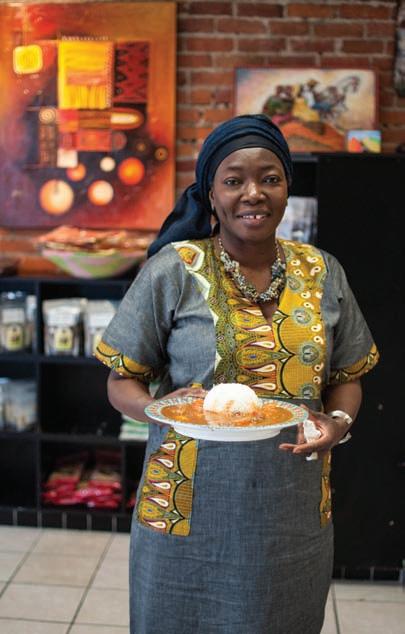
SENEGALESE
Mafe (peanut butter stew)
$1250 + TAX
sauce in texture. Both beef dishes cost $12.50. The black-eyed peas make a return in a vegan ragout for $8.95, which is rich and robust. The atmosphere is very basic and stark. This is largely a takeout business, though there are a few seats and tables. There are also frozen dinners to take out, which include Canadian food like chicken pie. Bintou has a little market going, and products there scream Christmas stocking stuffers for foodies: her own housemade hot sauce, healing products for smoothies like powdered baobab and moringa and some exotic flours.
25 ELIZABETH MONK
left: Bintou Toure holding Mafe Beef (beef stew) ELIZABETH NYLAND
Pendray Inn & Tea House • 309 Belleville Street info@pendrayinnandteahouse.com pendrayinnandteahouse.com Experience our Victorian Style Winter Tea at Pendray Inn and Tea House Hours of Operation Monday & Tuesday – 11:00am to 2:00pm Wednesday through Sunday – 11:00am to 7:00pm Reservations recommended 250-388-3892 Come visit our Festive Wonderland!
You may already think of Ruth and Dean for celebrations, since they are well-known for their elegant party cakes and dessert buffets, but it is worth remembering that their business also includes a luncheonette. The theme is classy comfort food, starting at the crack of 8 a.m. when they start serving their bestseller, the mile-high, all-day Breakfast Sandwich for $7.50. These are professional bakers, so the biscuit they make is fluffy, light and buttery. This sandwich is very healthy, filled with a runny egg, avocado, tomato and cheese, and each half of the biscuit is smeared with a vibrant, green chimichurri sauce made from parsley, cilantro and lime. For those of us in the “bacon makes everything better” category, that can be added for $2.










The lunch offerings I tried were just as satisfy-
ing. The Mushroom Mac ’n Cheese, for $14, boasts a silky Parmesan and Mozzarella mornay sauce over rigatoni noodles, and the flavour of the integrated sautéed portobello mushrooms is enhanced by a dash of truffle oil. This comes with a side of salad, which is also featured in a lighter lunch choice, the Polenta Salad, for $12. I have truly reflected before making this assertion: this is the tastiest polenta I have had in a long time, maybe even ever. The top and bottom are seared golden, and the soft interior is creamy thanks to cream and Parmesan in the mix, rather than just water. The salad is spritely and colourful, with julienned cucumber and radish, and gorgeous curls of bright yellow pickled fennel. There are a few small tables, and Ruth and Dean also does a thriving takeout business.
26NOVEMBER/DECEMBER 2017 Ruth and Dean 1310 DOUGLAS ST., VICTORIA | 778-265-6060 | RUTHANDDEAN.COM ABOVE: Polenta Salad (In the background - cake of the day) ELIZABETH NYLAND 2182 LAKESIDE ROAD, DUNCAN, BC BLUEGROUSE.CA @BLUEGROUSEWINES Find delicious Blue Grouse and Quill wines at select locations in Vancouver and on Vancouver Island EXPERIENCE Your Island Moment V Find delicious Blue Gr ancouv er V ancouv ouse er 2 LAKESIDE R 812 OUSE.CA BLUEGR , OUSEWINES @BLUEGR
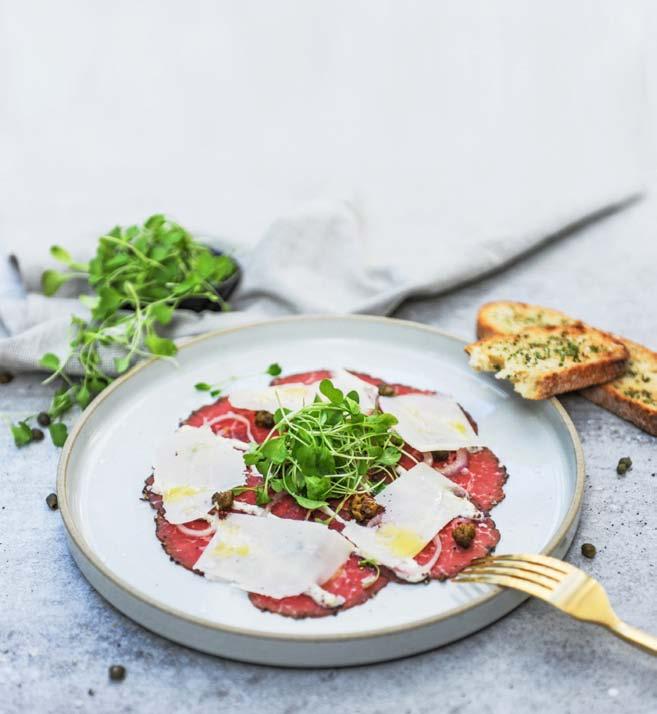



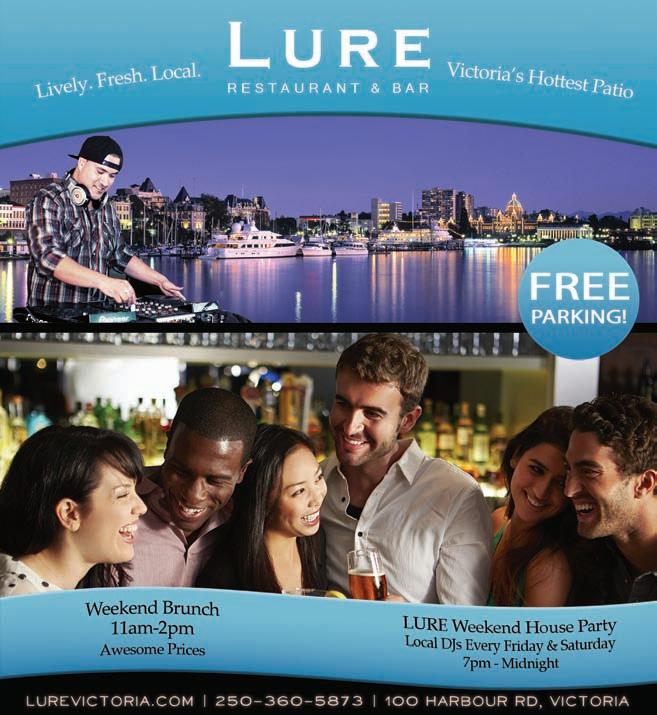


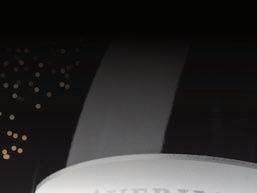



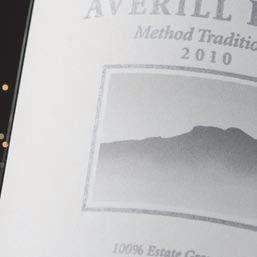

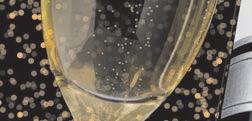


























27 featuring peppercorn-crusted, dijon aioli, capers, g rana padano, crostini. BEEF CARPACCIO eatu r ing ng fe AVERILL BRUT The Quintessential Celebration Wine www.averillcreek.ca/online-store Best Vancouver Island Sparkling Wine Best of BC Wine Country Awards 2017 C W r f BtoseB ocn a t V Va B avew.av w. w w 7 e 10s2dra w y A Aw rtnuoeCniC W en i g W Wi n ngilrka d Sp sl r I Is stor line /on o .ca lcreek l i Christmas at the Market VICTORIAPUBLICMARKET.COM | November 25 - December 24 Open 7 Days a Week Monday-Saturday, 10am-6pm Sunday 11am-5pm 1701 Douglas Street HOLIDAY SEASON! HANG WITH US THIS
CROSS-COUNTRY COOKBOOKS
BY REBECCA BAUGNIET
FIRST WE BRUNCH – Rebecca Wellman
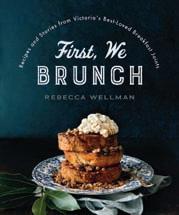
($30.00 TouchWood Editions)
This book is the logical place to start: with the first meal of the day and closest to home, written and photographed by EAT’s own Rebecca Wellman. There is so much to love about this book: utterly gorgeous photographs (what else would you expect?), cleverly divided sections (Where We Sit Down to Eat, Where We Grab Breakfast on the Go, Where We Shop …) insider knowledge, meticulous research and an obvious fervour for her subject. For each recipe sourced from a local restaurant, café or brunch spot, a photo sets the scene, capturing the ambiance or spirit of place as well as a mouth-watering image of the dish. (If you’re wondering about the cover photo, it is Spinnaker’s Dark Ale Caramel Toast with Espresso Whip.)
The Folks Who Know Best section is a delight, featuring profiles of our local bread, egg, cheese, bacon, coffee and tea experts. This book will be the perfect reference for lazy mornings when you want to eat your favourite brunch dish without leaving the house, but you will also reach for it whenever someone asks, “Where should we meet for brunch?” It also makes the perfect souvenir for friends who have come to visit and need a reminder of why they should come back.
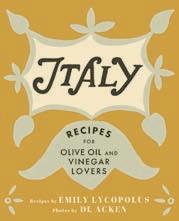






ITALY: RECIPES FOR OLIVE OIL AND VINEGAR LOVERS
Emily Lycopolus ($22.00 TouchWood Editions)

Emily Lycopolus lives in Victoria and is the owner of Olive the Senses, the luxury olive oil and vinegar tasting room/shop in the Hudson building beside the Victoria Public Market. This first in a series of cookbooks handpicks recipes that allow high quality olive oils and vinegars to shine. A nice feature of this elegant volume is that it does not require a major investment in oils and vinegars. All the recipes feature just one or two of four specialty products (Tuscan Herb-infused olive oil, Blood Orange-infused olive oil, Dark balsamic vinegar and Sicilian Lemon White balsamic vinegar). Recipes for appetizers, soups, salads, pizzas, pastas, main dishes and sweets are included. This would make an excellent gift, paired with a few bottles of oil and vinegar, for anyone who appreciates Italian cuisine, fine foods and delicate flavours.

LURE: SUSTAINABLE SEAFOOD RECIPES FROM THE WEST
COAST – Ned Bell ($38.95 Figure 1 Publishing)
Now we cross over to the mainland where Ned Bell, executive chef and ambassador for the Ocean Wise Seafood Program, has painstakingly assembled not just an inspirational collection of recipes but a valuable resource and guide to sustainable seafood choices. Stylish graphics throughout the book illustrate seafood seasonality and open each chapter with different varieties of white fish, fatty fish, shellfish and sea greens. Photographer Kevin Clark’s striking images excel at capturing the texture of each dish, and the chapter on species profiles provides artful portraits of all the varieties of fish, seafood and sea vegetables used in the book. This beautiful cookbook will be well received by seafood lovers looking for new ways to showcase sustainable fish in the most delectable ways.
28NOVEMBER/DECEMBER 2017
What an impressive crop of cookbooks Canada has produced in recent months. If your go-to holiday gift is a book, this list will help you eat local and read local.
THE OKANAGAN TABLE: THE ART OF EVERYDAY COOKING –
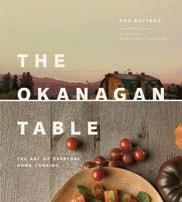
Publishing)
Now we travel to the Okanagan, the region chef Rod Butters considers “the ultimate chef’s playground.” Butters’ company RauDZ Creative Concepts Ltd. oversees operations at RauDZ Regional Table and micro bar • bites, both in downtown Kelowna, and Terrafina at the Hester Creek Estate Winery in Oliver. Despite Butters’ impressive accolades (he’s a member of the BC Restaurant Hall of Fame and the Canadian Culinary Federation Honour Society), his cookbook is filled with tempting yet accessible recipes that make the most of local and seasonal ingredients, such as Peach, Basil and Sour Cream muffins, Haida Gwaii Halibut and Asparagus, Side Stripe Prawns and Gazpacho. This is the cookbook for home cooks looking to expand their repertoire, or newcomers to the province who need an introduction to some of our regional ingredients.
CATHERINE PARR TRAILL’S THE FEMALE EMIGRANT'S GUIDE: COOKING WITH A CANADIAN CLASSIC – Edited
Here is a book for the Canadian historian who also loves to cook. This scholarly volume takes a close look at Catherine Parr Traill’s Canadian classic, The Female Emigrant’s Guide, first published in 1854. The editors provide a fascinating introduction, setting the scene and providing background on Parr Traill’s project as well as on her life. The pioneer’s complete work is reproduced here, including chapters on gardening, wild fruits, fermentations for bread, vegetables, beer, maple sugar, poultry, bees and more (soap making, carpets, dysentery!). The editors also provide a comprehensive, impeccably researched guide to Parr Traill’s world, offering guidance on translating her 19th-century recipes to the 21st-century kitchen. This is a captivating examination of what life was like for female settlers to Canada in the mid-19th century, while also offering up tasty recipes and still-relevant advice for homesteaders.
THREE

TIMES A DAY: SIMPLE & STYLISH
– Marilou and Alexandre Champagne ($34.95 Ambrosia Publishing)

And now to Quebec, for the latest instalment of Marilou and Alexandre Champagne’s Trois Fois par Jour project. What began as an elegant food blog has expanded into a bit of an empire for the couple, with cookbooks, web video series, quarterly magazine and, most recently, a new product line. I think of Three Times a Day as Quebec’s answer to Donna Hay, with stylish photography and design. What makes Marilou’s work stand apart, however, is her honest and generous writing about her past struggle with anorexia, daily challenges as a new parent and now her husband’s diabetes diagnosis. This new book offers plenty of options for food sensitivities and dietary requirements, but always with stunningly beautiful images that capture one woman’s ever-changing relationship with food.

PANTRY AND PALATE: REMEMBERING AND REDISCOVER-
ING ACADIAN FOOD – Simon Thibault ($34.95 Nimbus Publishing Ltd.)
Finally to the east coast, where chef Simon Thibault has created a love letter to Acadian cuisine. If you are not yet acquainted with this cuisine, Thibault describes it as “food that is humble, homey, occasionally homely, and very comforting.” The book tackles preserves, breads, lard (you have to admire a cookbook that gives lard its own chapter), tête de cochon (“head: the other meat”), soups, sides and staples, and desserts. Thibault calls on family recipes, stories, regional folklore and history for inspiration, resulting in a book that will not only inspire you to try something new but perhaps learn about a lesser-known corner of our country.
Rod Butters ($37.95 Figure 1
by Nathalie Cooke and Fiona Lucas ($39.95 McGill-Queens University Press)
29

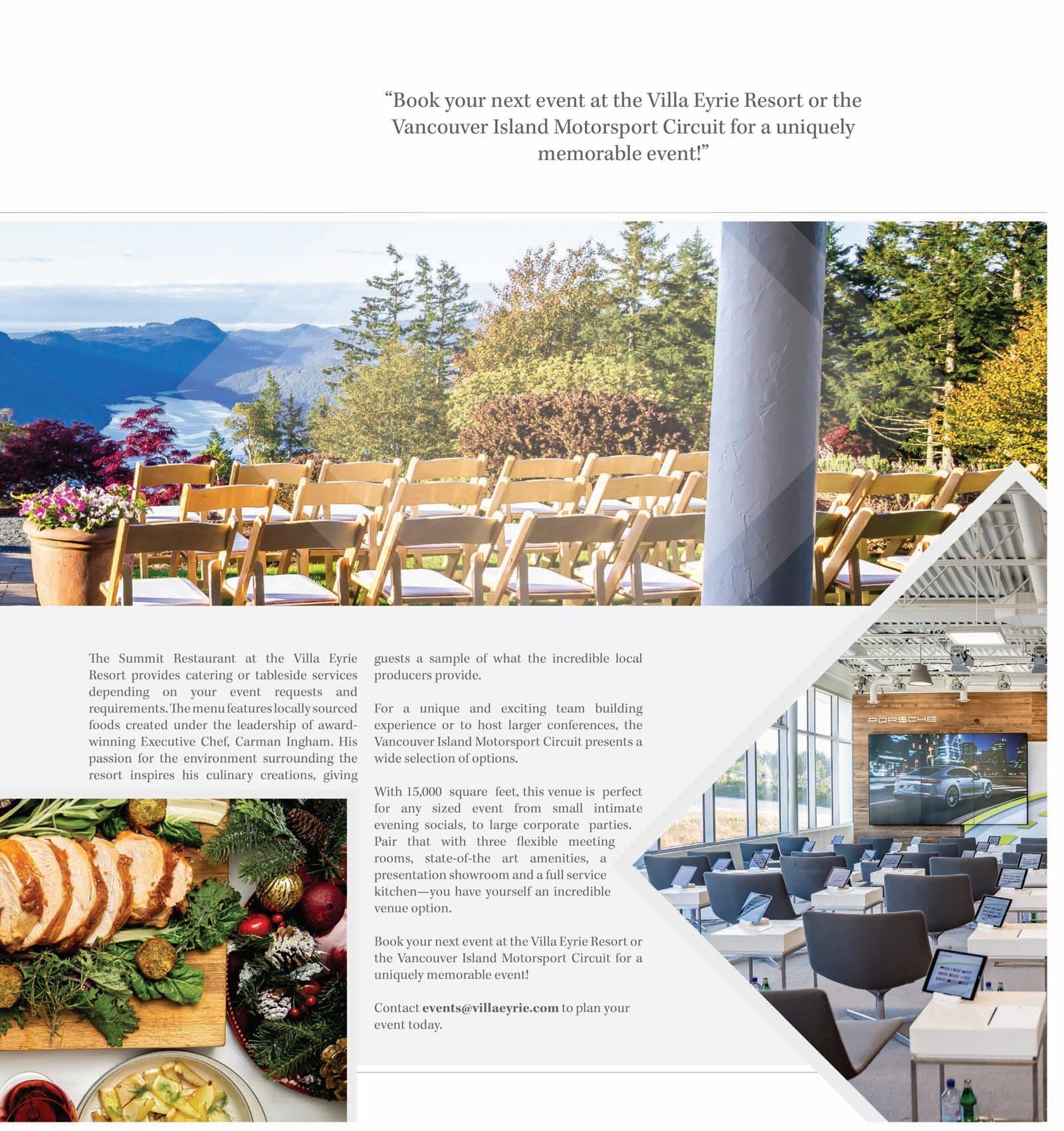
31





































32SEPTEMBER/OCTOBER 2017 ‘Tis the season to purchase one of our reusable ‘Red Bags’ , then stuffing it full of our yummy baked goods to get 10% off your entire bag’s contents! Check our site, or call for more details. IS OUR GIFT TO YOU! 7daysaweek sa a , g Check our site bag’ bak ’ ed Bags R ‘ r eusable s contents! ed
ONE AMBITIOUS S.O.B.
RYAN ORR
EVERY BREWERY IS DIFFERENT, BUT A BREWERY THAT SHARES A WALL with a gas station is more different than most. Pulling into the Shell station on the south side of Sooke Road, just prior to the town itself SOB is located after the municipality boundary but before the town, in a neighbourhood Sookies know as Saseenos, you’ll find Sooke Oceanside Brewing (or S.O.B in its cheeky, very much intended initialism). Although the location was not part of the original vision, things are going very much “according to plan”, the business has had its accelerator pushed to the floor since opening day, and despite hitting the occasional pothole along the way, it has so far managed to maintain that pace since November of 2016.
The project began as a welcome distraction for owner/founder Ryan Orr. After 21 years of professional chef experience, he found himself tiring of the negative, but pervasive, pitfalls of that industry: the night-crawler lifestyle with its long nocturnal hours and illicit recreational indulgences. Trying to manage a team caught up in its youthful pursuit of that romantic, rebellious ideal of “chef life” (thank you, Mr. Bourdain), and also enjoy the precious early days of his young family, became too much. Orr was less and less enthused by the daily grind of the commercial kitchen: “I loved, and still love, to cook but just became sick of the lifestyle.”
He found himself drawn to other interests: he began cultivating honey, which led to a course on mead-making, which then broadened to studying fermented beverages in general. Orr began brewing beer at home, and the flagship lineup of beers for a fledgling brewery began to take shape. Naturally, he wanted to incorporate his decades of work in kitchens into the customer experience for his new project. So he got to work on a business plan for an innovative, waterfront brewery/restaurant: “I try and stay away from the term brewpub, as it leads people to pigeonhole the style of food.” It was time to pack in the knives as executive chef at Clayoquot Wilderness Resort, move back to Sooke, and begin the search for the perfect property to build the company around.
Growing up in the Happy Valley area, Orr always viewed the Sooke region as ripe with opportunity for a brewing venture. How does he justify that, given Sooke’s permanent population of around 14,000 people? Well, he found hope in what some might have seen as a serious limitation. “Don’t quote me on this, but I think at one point Sooke had the largest consumption of Lucky Lager anywhere in Canada. But seriously, don’t quote me on that.” (Note: If you see Ryan, please don’t tell him I quoted him on that.) Urban beer legends aside, it goes without saying that the tastes of the Sooke region aren’t generally in line with what one would consider the “craft beer” aesthetic. “But on the flipside of
that, if you look at the Canada-wide figures for craft-beer vs domestic beer consumption, it’s around 20 percent or close to that, and the market here was pretty much untapped.”
Coupling that with the increasingly prohibitive cost of housing in Greater Victoria (which somehow seems to affect pretty much every facet of our lives), means more and more young families are moving outwards of the city confines and taking their urban tastes with them.
So, how did Orr’s dream of a waterfront restaurant/brewery turn into the unique, human-refuelling section of a gas station? “The property owner had just lost his tenant [a mechanic’s shop], so he went to the municipality to see what it was zoned for. Brewery was on the list, and eventually we connected about my project.” Orr came very close to shrugging off the location as incongruous with his vision, “but my mind started changing about how to get this thing off the ground. I had the beer. I had the branding. Eventually I said, let’s launch this thing.” Although this is still very much a stepping stone en route to Orr’s larger vision, he seems to have hit a very thirsty nerve.
After opening their doors for the first time on November 3, 2016, the brewery sold out of beer in two and a half days. Brewing a batch of beer is a two-week endeavour at the very least, so it wasn’t as simple as “tapping another keg.” Due to the size limitations of the brewing space, and capabilities of the septic waste system, their location has a very real maximum beer output. Rather than close the doors after the beer was sold out, Orr manned the closed till for the sole purpose of being able to explain their issues and meet with their clientele, while head brewer Garritt Lalonde worked monumental hours to try and get the supply chain intact again. They made the decision to restrict opening hours to three days a week, to avoid a pattern of forced closure—not a viable long-term measure, but hopefully enough to offer a consistent customer experience.
While that band-aid was applied, Orr got to work looking at ways to satisfy the welcome, yet unforeseen demand. He managed to establish a reciprocal relationship with another brewery on the southern island, brewing larger-scale batches under Lalonde’s supervision, while utilizing unused capacity at the contracting brewery. The benefits have been two-fold: S.O.B’s core brands are now brewed on a large-enough scale to ensure consistent supply, all summer) long, while alleviating the strain on the in-house system enough to enable larger runs of rotating, one-off batches. The end goal remains the same: fine beer (and eventually food) on the iconic Vancouver Island waterfront. But in the meantime, next time you fill your gas tank on the way up the island’s west coast, remember to take that empty growler along for the ride.

33
Sooke Oceanside Brewery stakes its claim for island craft brewing beyond the capital.
“MY MIND STARTED CHANGING ABOUT HOW TO GET THIS THING OFF THE GROUND.”
DANIEL MURPHY BREWING
JOHANN VINCENT
LEFT TO RIGHT: Greg Walker (tasting room manager), Ryan Orr and Garritt Lalonde(brewer)
HOLIDAY WINE GUIDE
Whether as a festive tipple while wrapping gifts or to pair with the festive bird, these BC wines make ideal seasonal sippers.
After years of chatting to customers about holiday wines, one thing remains consistent. Folks are willing to kick the budget up a notch but don’t want to blow up the credit card. And with drinking local becoming as essential as eating local for many folks, B.C. wines break perfect ground. Bright fruit and vibrant acidity, a wide range of styles and food friendliness take them from casual mingle to formal dinner table, from office party to gift giving. There’s a lot of deliciousness out
there between $20 and $50. Note: prices are appproximate.
SPARKLING
Unsworth Charme de L’Ile ($25), made from Cowichan Valley grapes, is fermented in the same manner as prosecco. Get the party started with this zippy fizz, or enjoy while opening presents Christmas morning. Pretty bottle too. Blasted Church OMG’s ($35) garish label is not my cup of tea. No matter. It’s what’s in the bottle that grabs my attention. At once rich and
racy with an appealing note of toasty brioche amongst the ripe fruit and almond flavours, the wine is a treat on its own, with potato chips or alongside rich seafood and white meat. Similarly, Cipes Blanc de Franc ($50) is a cracking food sparkler. Its juicy red fruits and herbal notes are perfect for roast pork, turkey, duck or any other festive bird.
REDS
Pinot Noir has become a go-to for turkey. But for those who lack a Burgundy budget, two B.C. winery flagship Pinot Noirs will do quite nicely. Averill Creek Pinot Noir ($25) boasts fresh raspberry flavours and spice while Quail’s Gate Pinot Noir
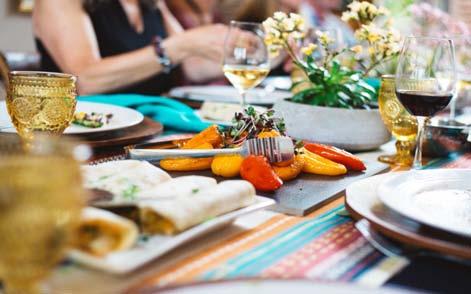



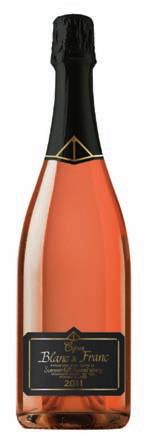

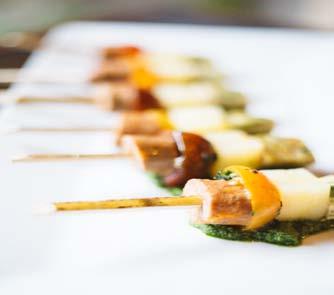
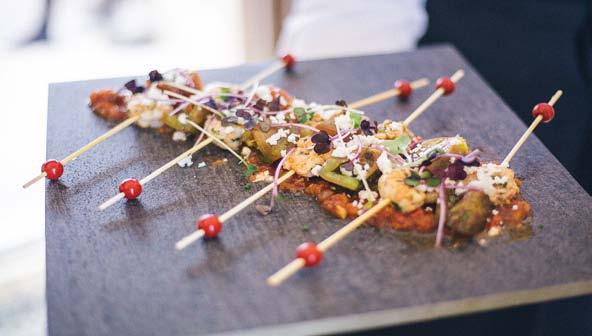

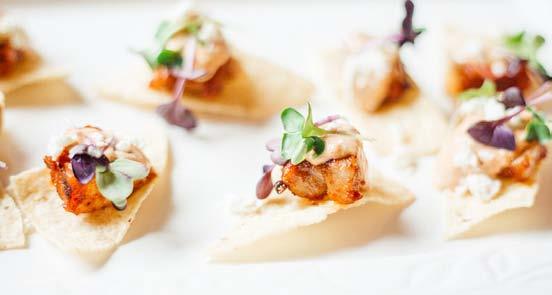
It’s All About the Food
www.ToqueCatering.com 778-432-2460 or email us at chef@toquecatering.com
778-432-2460 or email us a ertoqueca t chef@t om.cingerta .ToqueC www om.cinger
34NOVEMBER/DECEMBER 2017
Molly Jane Photography
JULIE PEGG BC WINE
($30) delivers dark cherry and earthy notes. The wines make a good choice for vegetarian dishes too, particularly mushroom strudel.















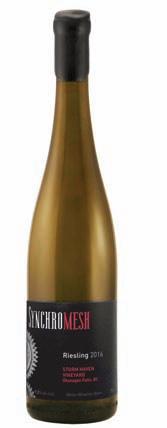

Decided on a change from the bird and opting instead for peppercorn prime rib or roast lamb? Try the well-priced smoke and spicy Adega Syrah ($25) or Laughing Stock Syrah, ($35) where black pepper, dark fruit and Northern Rhône style make it one of the better Syrahs I’ve had this year.


WHITES
Think all Riesling is sweet, Chardonnay oaky and Pinot Blanc simple? Not true. You can dress these wines up and take them anywhere. All flirt charmingly with starters, cheeses and lighter entreés.

Synchromesh hangs stylish hats on six crisp and balanced Rieslings. The entry-level Riesling is off-dry, lush and fruity and a bargain for around $20. Top-tier single vineyard Synchromesh Stormhaven ($40) is all stone fruit and mineral sophistication. A combination of old oak and stainless steel contributes finesse and charm to Meyer Okanagan Valley Chardonnay ($20). Meanwhile, plush yet perky Skaha Pinot Blanc ($18.95) proves what B.C can do when it turns attention to producing this underappreciated varietal.
If there is one varietal that fares perfectly with a range of cheeses, it’s Chenin Blanc. Melon-and-honey Quails’ Gate Chenin ($20) and luscious Old Vines Road 13 Chenin ($25) lift fresh, slightly aged and washed rind cheeses to a delicious height. The grassy/citrus profile of Howling Bluff Sauvignon Blanc ($20) hones in on gamey goat cheese while rich Sauternes-style Clos du Soleil Saturn Late Harvest Sauvignon Blanc ($30) holds its own with creamy, salty, blue cheeses. It could be that many rosé wines are sold out by the time this article is published. Let’s hope not. Poplar Grove, Le Vieux Pin Vaïla, Painted Rock, Culmina Saignée (all around $30), all have enough oomph to stand up to baked ham or Boxing Day turkey and cranberry sandwiches. If they are still about, grab a bottle or two. Rosé is not just for summer any more.
WORTH THE SPLURGE ($50+)
Finally, your friends will love you if you splash out and bring either or both of Foxtrot Waltz Pinot Noir and Foxtrot Vineyard Chardonnay ($45-$65). The same applies to Meyer Micro-Cuvée Pinot Noir and Micro Cuvée Chardonnay ($60$70). How many times have you heard the words sophisticated, silky, seductive used in describing fine wines? Possibly too many. But in this case such lexicon is apt. You can also find Foxtrot wines in magnum. Now that’s an ideal Christmas.
Meet a BC Egg Farmer

Scott Janzen is a third-generation egg farmer from Abbotsford, BC. As a young man, he moved away from the farming life but he came back to it once he had a family and knew that a farm was a great place to raise his kids. Today, he produces two types of eggs for the people of BC.
Learn more by visiting BC Egg’s website at bcegg.com
35
Food is no longer simply functional. Food has become fashion, a trend to capitalize on and then discard when it no longer suits us. Trends live and die on Instagram and Facebook likes and shift faster than you can get to the supermarket. Trends experience a boom and bust at such an alarming rate that it becomes difficult to truly understand both their origins and their effects. In this article, we’re going to go a little deeper. General ideas such as food security and overall nutrition are easy to digest and keep at arm’s length. The class politics and class appropriation of food, on the other hand, dig uncomfortably close to our own biases. We’ll explore two dominating trends, health food and craft culture, and how they affect class divide and the way we think about culture, history and social economics. Let me tell you something. You are not going to like everything you read here, but the aim is to get you to think more critically about how we consume food and what accessibility and inclusion mean when the topic of food is on the table.
Health Trends
Where health food is concerned, there is no limit to what won’t be investigated, uncovered, branded and sold. Debates have raged over the healthiest styles of eating for decades, but now more than ever we are bombarded with opinions on what is best for our bodies. We want so desperately for food to be our medicine—to keep cancers and age at bay and to keep us strong well into our nineties. The reality is that the vast majority of people cannot afford to be on gluten-free, plant-based or organic diets, nor are they able to access fresh fruit and vegetables or hormone-free proteins. Internet celebrities have become fierce harbingers of the next important health breakthrough, and alarmist headlines screech that if you aren’t eating or buying a particular product you are likely doomed. There is also a lot of pearl-clutching happening when food is offered that is not organic or gluten-free, as if the mere act of noncompliance was something to be ashamed of. It takes the luxury of time, money and education to become fully mindful of what one is putting into one’s body, a luxury that many do not have. Wellness, in general, should be accessible. A lot of time is spent debating the merits of rare herbs or roots and so-called “super foods” that hail from the misty mountains of the Himalaya or the deepest jungles of Myanmar. The phrase “food is medicine” has entered into our general vernacular and our shopping habits reflect that. We shop for a pantry and fridge rich in antioxidants, vitamins and minerals as we attempt to circumvent pharmaceutical goliaths. But as we increasingly treat food as medicine, we drive up the price of those foods just as we might when a rare miracle drug hits the market. The more benefits the food offers, the pricier and rarer it becomes. If we are to decree that food is truly medicine, then that medicine should be available to all.
Just as we are all ready to scoff at the ludicrous and extraordinarily luxurious products and regimens promoted by Gweneth Paltrow’s Goop brand, with her wildly expensive Moon Juices and Brain Dusts (which are listed as “pantry essentials”), we might be well take stock of how less economically stable classes view our dedication to almonds and avocados. Is the fault completely ours? No, of course not. And yet isn’t our desire to “avoid some of these uglier truths” partly driving the media hype and the market forces? If we don’t try to alter our own part in this (rather than just be aware) then how can we expect the media or the government or the advertising industry to change the system? Media hype, government regulations and market forces place a high price on buzz-worthy health food trends, and if a buck can be made off them, then why not? The underlying truth is that the problem is systemic. The longer we hide our head in the sand trying to avoid some of these uglier truths, however, the longer these systems are upheld.
Craft Culture Trends
As the class divide between food and its accessibility widens, another facet to this argument is well worth unpacking. Craft and artisanal culture is at the height of its renaissance. Hand-crafted beers, whiskies, coffees and kombuchas; nut butters, preserves, all things pickled and brined; and meats of all kinds, whether smoked, cured, aged or farm-raised, have staked their claim on the shelves of local and chain supermarkets alike. We are chasing a way of life. When we pick up something that boasts it has been handmade, imported through fair trade or crafted in
a small batch, we are borrowing and repurposing the manufactured nostalgia of rural life or the selfcontentment of what we think of as conscious consumerism.
Craft culture is dominated by white-owned brands, supported by resources and access not afforded to less economically stable demographics. It is a rare thing to find a craft product that is honestly backed by a family heritage that has honed the product over many generations. Food company founders are often educated, come from the means to launch a start-up business and are extremely savvy when it comes to marketing the product on social media. The products and methods they sell are built on the idea that they have been plucked from “obscurity” or reinvented (read re-branded) to suit the modern palate.
On the surface, the motivation is to honour “real food” traditions by upholding a romanticized past. However, rural life was often synonymous with poverty, and the labour that was required to carry out such techniques and crafts usually meant that the makers were from the lower working classes. A good example of this is the treasured antebellum society of the American South, where fine craftsmanship in everything from food, to architecture, to fashion was built on the backs of enslaved and indigenous populations. Even the revered Jack Daniels took his craft from knowledge passed to him by an enslaved black man named Nathan “Nearest” Green. Here in Canada we think of maple syrup as a national treasure, but it was the Aboriginal populations who shared their harvesting techniques with the European settlers, who then promptly turned it into a commodity to be exported. Today, one might find bottles of $30 Bourbon, Barrel-Aged Organic Maple Syrup, far removed from its Aboriginal roots.
The rebranding of cultural heritage without specifically acknowledging the darker part of its history perpetuates the systemic whitewashing of lesser-known histories that don’t fit our rosy picture of how our countries were built. Craft culture makes us feel as though we are a part of a history that doesn’t belong to us, what Lauren Michele Jackson called in an August Eater.com article, “a special blend of bohemianism and capitalism ...[that] fetishizes the authentic, the traditionally produced, and the specific; it loathes the engineered, the mass-produced, and the originless.”
Even our desire to buy fair trade or direct trade is fuelled by the use of
36NOVEMBER/DECEMBER 2017
The Politics of Food Part 2: COUNTERING THE CULTURE (Foods Trends and Class Politics)
THE ISSUE
CONTINUED ON PAGE 30
Jill Van Gyn continues her in-depth look at the politics of the plate.
THE REBRANDING OF CULTURAL HERITAGE WITHOUT SPECIFICALLY ACKNOWLEDGING THE DARKER PART OF ITS HISTORY PERPETUATES THE SYSTEMIC WHITEWASHING OF LESSER-KNOWN HISTORIES
awesome people
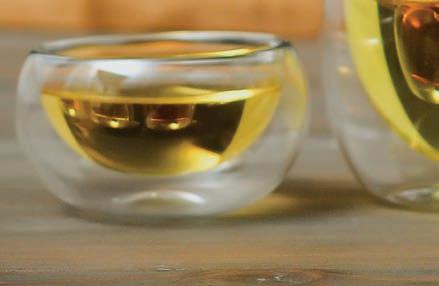
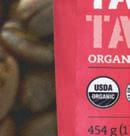

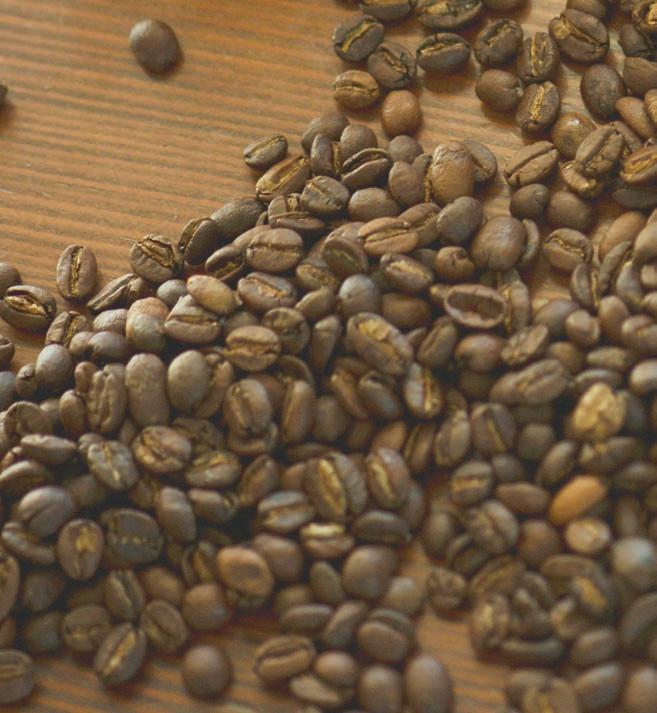


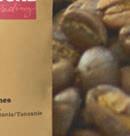

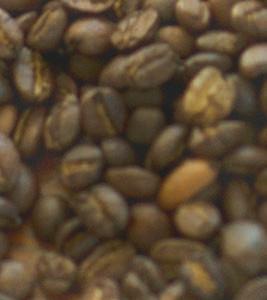





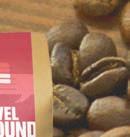











37
your
food. serve
Street
olorestaur
es au
taurant | olor ta taurant.com MossStreetMarket.com warm and dry in the Garry Oak Room with your favourite local organic farmers at 1335 Thurlow St. Parking in the Sir James Douglas school parking lot. Indoor MSM Winter Market Saturdays, 10-noon Moss St Market indoors, starting Saturday, November 4 Saturday and Sunday, Dec 9+10 HOLIDAY MARKET Moss St. Market’s Moss St. Winter Market Fine artisans and crafters with cards, clothing, jewelry, purses, bags, toys, glassworks, woodworks, pottery, bath products, preserves, chocolates, baked goods, prepared & hot food, winter vegetables, meats, sh, mushrooms, cheese, oils, treats, beer, cider, wine, and much, much more... & Tea flights Over 40 single estate pure teas Alcohol and tea tasting events Private parties and gifts for Christmas 832 FORT STREET | 778 747 BREW | terroirtea.com
des Aw Awesome family for a holiday f Bring
friends an
y feast ds and 250.590.8795 Victoria, BC 509 Fisgard
sourced ingredients. made with love and lo of fresh seasonal fo
@
d locally od
COUNTERING THE CULTURE cont’d






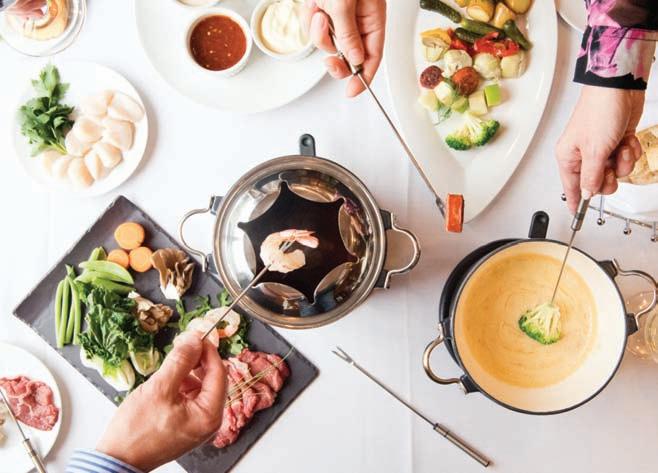

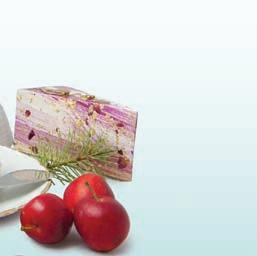












impoverished black and brown bodies in faraway places to sell these products. Smiling farmers plucking coffee or cocoa beans start to ring hollow when we understand the vast amount of money and marketing that is generated by selling these stories to you. Without those stories of down-home rural life, living off the land and Ugandan women rescued from poverty by a benevolent coffee company, we would not buy into these products. Craft culture is a product of predominantly white, upper-middle- class demographics that not only exclude populations of colour and the strong heritage of North American working classes from the contemporary conversation but ignores their histories and contributions as well. We are appropriating a lifestyle, a feeling of being connected to land we never owned, never tilled and never fought for.
So what should we do? Or more importantly, why should we care? Should we stop buying maca smoothie bowls, single-origin, fair-trade coffee or handcrafted hot sauces just because some people can’t access them? Absolutely not. Should we then preach our newfound knowledge and awareness with fervour and zeal in order to re-educate the masses? Definitely not. What we should do is continue to uncover our privilege and try to reconcile what we eat with why we are eating it by keeping the dialogue as balanced as possible and building an educated and open-minded awareness. As food increasingly becomes central to our cultural and personal identities, it becomes a useful tool in investigating our biases and privilege. When we approach food consumption with an almost religious zeal, we have a tendency to become blind to how inaccessible food can be for most. Food should not become exclusive or exclusionary. Rather, food should be a driver of innovation in universal sustainability, nutrition and enjoyment.
38NOVEMBER/DECEMBER 2017
Farm Shop Hours Tuesday to Saturday 10 - 5 Customer Appreciation Day! 15% OFF Christmas Open House ~ Tasty Samples & Hot Mulling Spices at Both Events ~
EAT Talks 3 Announced For 2018
MONDAY, FEBRUARY 5, 2018
The theme for our next EAT Talks storytelling event is The Best Thing I Ever Ate. The stories we tell about ourselves and about the food we love gives meaning to our history and to the things we value most. There is always one memory or one experience that we fall back on when we think about the best thing we ever ate. It might not have been a dish found in a Michelin-starred restaurant or crafted by the hands of the world’s finest chef but perhaps was found in our childhood kitchen, or during a revelatory experience eating abroad, maybe it was just a treasured morsel pulled from our local shores. Food and memory are deeply connected and some of our fondest and most precious memories are preserved in the food that has brought context to our lives.
“The Best Thing I Ever Ate” will take place at Northern Quarter in Victoria and will feature noted speakers from the local food and hospitality industry along with some great food and drink.



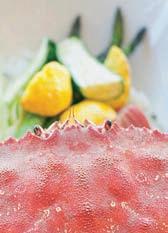


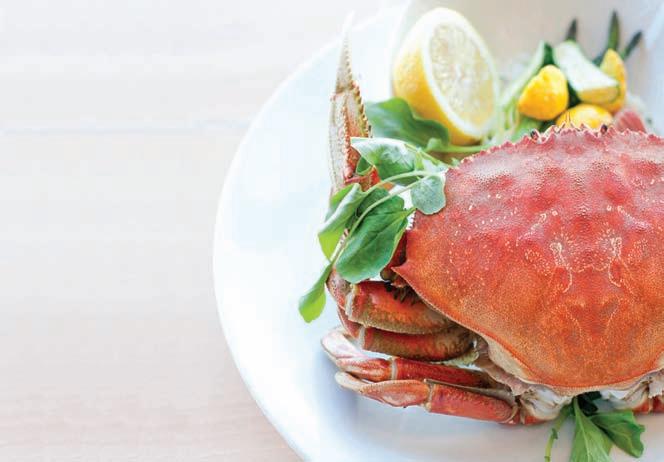
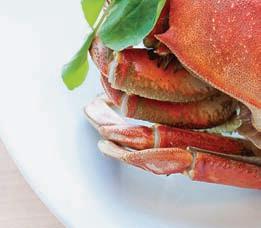
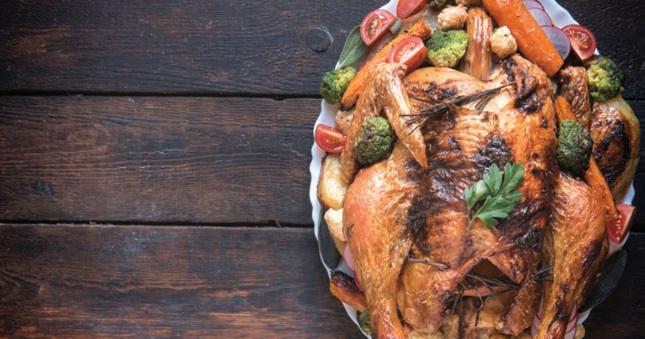

Details and ticket info will be announced in our Jan/Feb issue and online. We hope to see you there.

39 2577 Cadboro Bay Road, VICTORIA 592-0823 TURKEY SO GOOD YOU’LL HIDE THE LEFTOVERS. “Free-Range” Poultry and Game Birds, Quality Meats, Cheeses, Specialty Products & Condiments




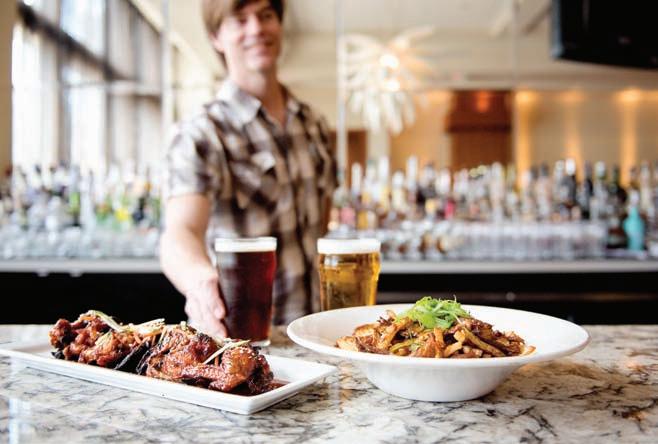





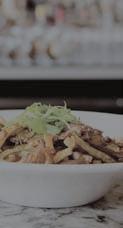



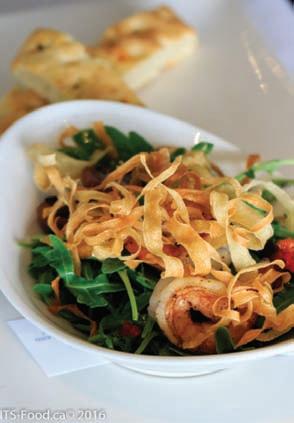



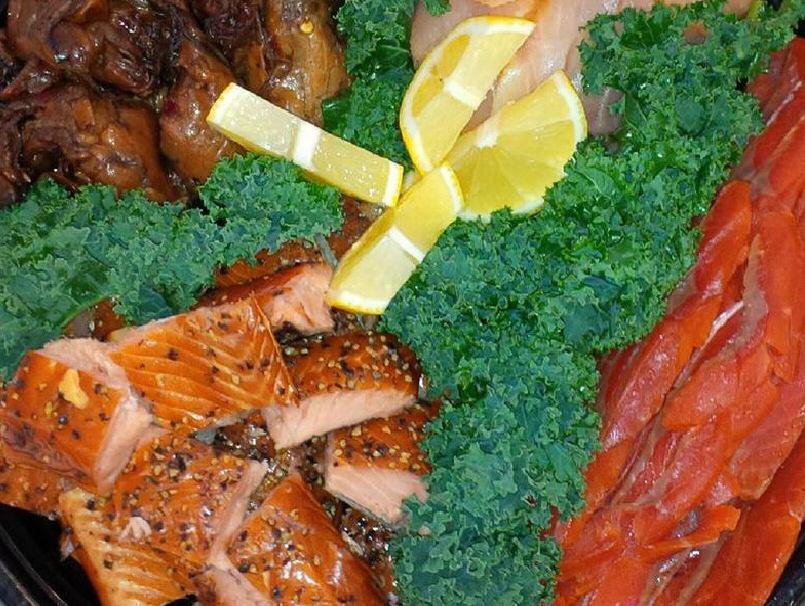
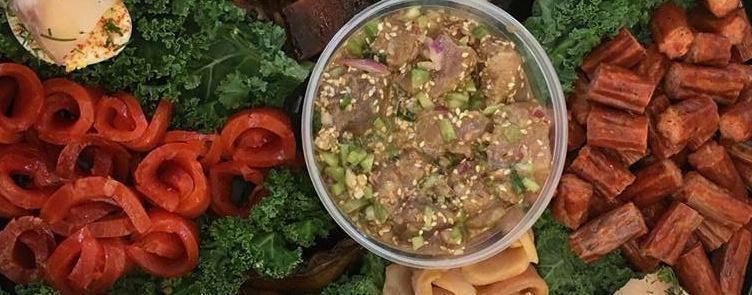






40NOVEMBER/DECEMBER 2017 1715GovernmentStreet 250.475.6260 www.lecole.ca eat@lecole.ca Dinner5:30-11pm TuesdaytoSaturday downtown victoria’s favorite happy hour. join us for half price tapas and drink specials monday - friday 4pm - 6pm
Rebecca Wellman’s THE COAST ROAST
WHEAT BERRIES, FENNEL AND PRAWNS OPTIMIZE THE TRADITIONAL ROAST PORK.
Roast anything takes me back to Sunday night dinners as a kid. The meal was always a treat—we were allowed to eat it on trays in front of the TV (Walt Disney, of course), our plates full of beef, potatoes and lots of good gravy. Roasts are still welcome in my house, though I prefer them a little more healthconscious these days. A little elevated perhaps, with various zests and herb-y rubs and the subtle flavour of fennel. This dish is guest-worthy, warming for the cooler months but not too heavy.
INGREDIENTS
1 bone-in pork loin roast, frenched (about 3 pounds or 4 bones)
1 Tbsp Dijon mustard
1 tsp salt
½ tsp fresh ground pepper
1 Tbsp very fine bread crumbs
1½ tsp minced fresh garlic
1 Tbsp minced fresh thyme
1 Tbsp minced fresh rosemary
1 Tbsp minced fresh sage
1 tsp minced lemon zest
3 tsp olive oil
1 cup hard red wheat berries
2 cups chicken stock
2 bay leaves
½ small fennel bulb, finely chopped (reserve fronds for garnish)
¼ cup white wine
1 tsp salt
1 large shallot, finely minced
1 Tbsp lemon zest, minced
3 Tbsp olive oil
2 Tbsp lemon juice
1 Tbsp chopped chives
¼ cup chopped parsley
12 large prawns or shrimp, roasted (BC Spot prawns are an excellent choice)
2 Tbsp butter, melted
1 Tbsp orange zest
1 Tbsp chopped chives
Salt and freshly ground pepper
METHOD
Preheat oven to 375°F. Line a sheet pan with foil and set a rack on top.
In a small bowl, combine Dijon, salt, pepper, bread crumbs, garlic, thyme, rosemary, sage, lemon zest and olive oil. Season pork generously with salt and pepper and transfer to prepared rack, bones up. Rub herb mixture all over pork roast. Cover each bone with foil. Let sit at room temperature for 30 minutes.
Spread wheat berries onto a sheet pan and bake, tossing occasionally, for 10-15 minutes, until fragrant.
Increase oven to 425°F. Roast pork for 15 minutes, then turn down heat to 375°F and roast for another 60–70 minutes, until thermometer reads 145°F. Remove from oven, tent with foil and let stand for 15 minutes.
In the meantime, pour wheat berries into a large pot. Add the chicken stock, 1 cup of water, bay leaves, wine and salt. Cook for 50-60 minutes (time will depend on type and age of berries) until liquid is absorbed and the wheat berries are tender but chewy. Remove and discard the bay leaves and drain any excess liquid.
Stir in shallots, fennel, lemon zest, olive oil, lemon juice, chives and parsley. Season with salt and pepper and set aside, covered to keep warm.
Mix roasted prawns, melted butter, orange zest and chives in a medium bowl. Season with salt and pepper.
Cut pork into 4 chops, leaving one bone in each. Spoon wheat berries onto 4 warm plates, top with pork and place 3 prawns on top of each. Garnish with reserved fennel fronds and serve with roasted broccolini.
Serves 4.
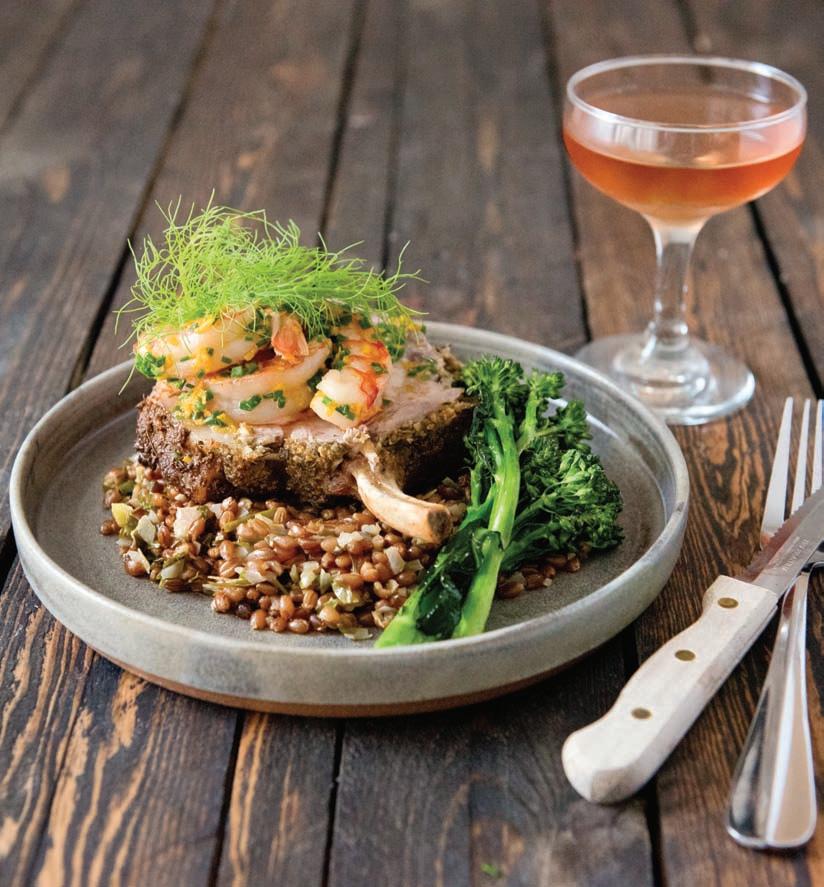
REEBECCA WELLMAN 41
A CLASSIC CAKE
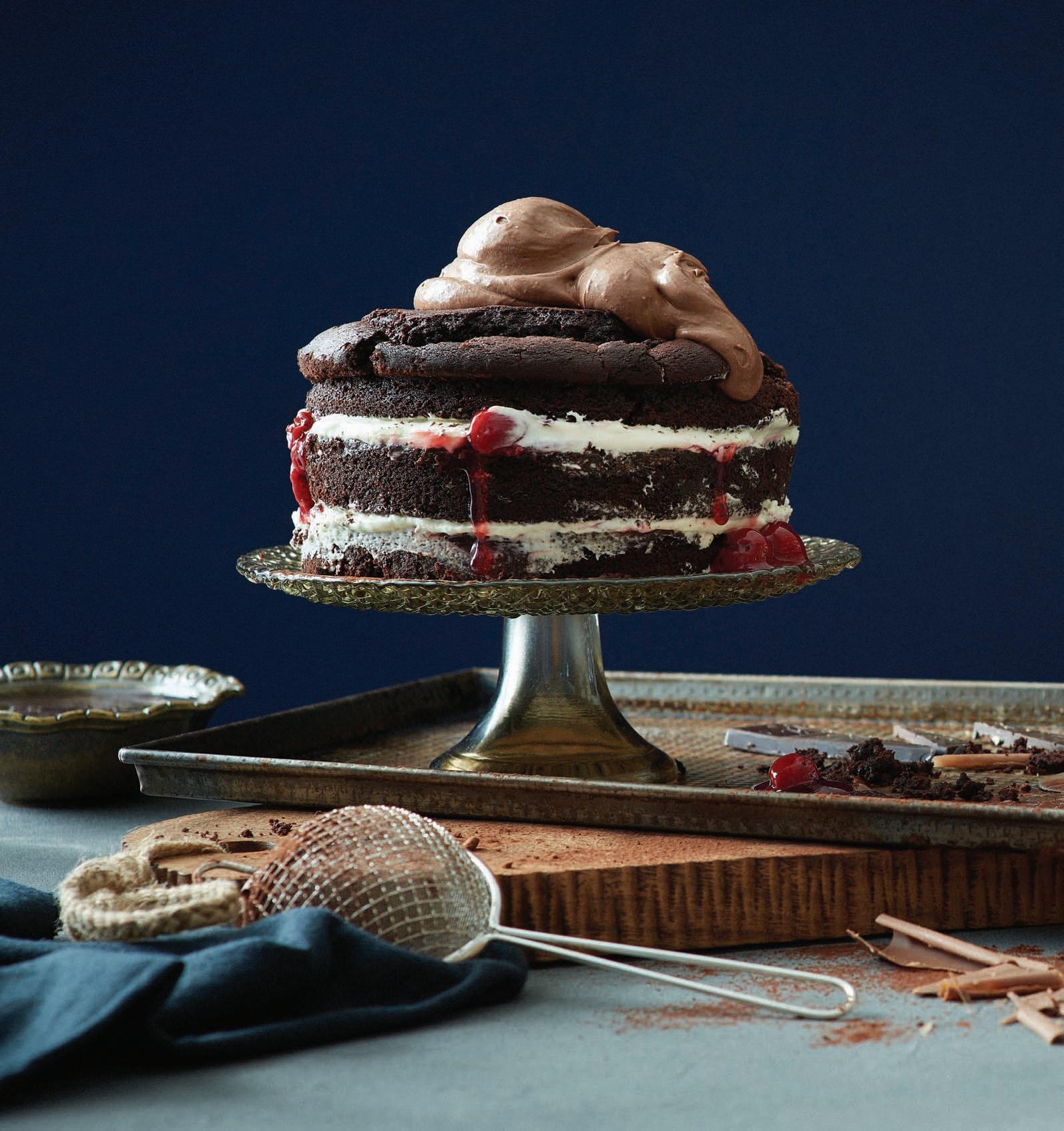
42 NOVEMBER/DECEMBER 2017
Marie-Eve Charron’s BLACK FOREST CAKE
DARK CHOCOLATE AND SWEET CHERRIES MAKE BLACK FOREST CAKE A FAVOURITE AT HOLIDAY TIME.
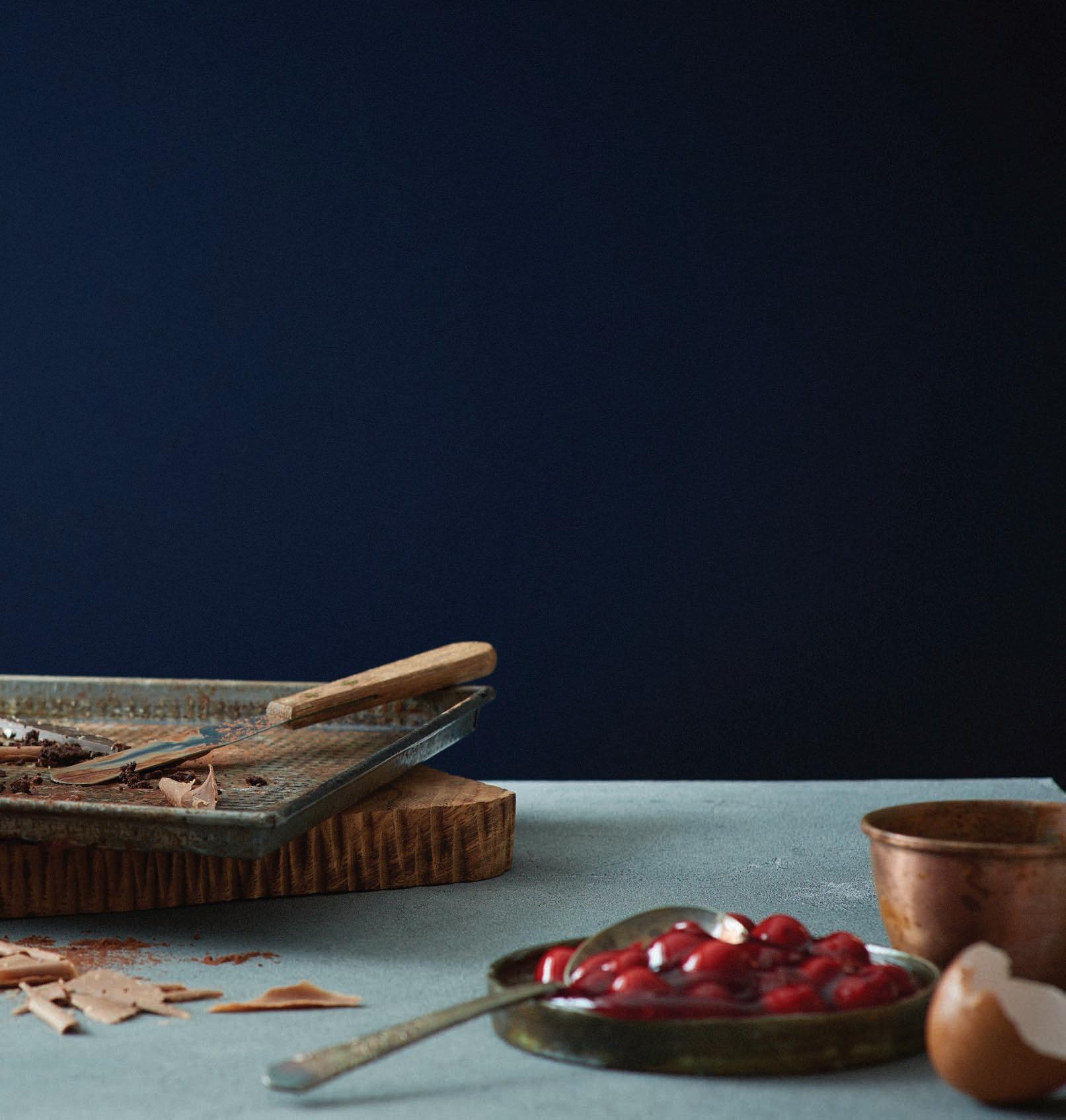
During the holiday season, I like to spend more time in the kitchen baking. This is one of great classic cakes, one that plays dark chocolate against the bright flavour of cherries. Add the Chantilly cream and you have a rich and decadent dessert. It’s always a favourite at my house. Photography by
CAKE
325 ml (1 1/3 cup) cups all-purpose flour
160 ml (2/3 cup) cup cocoa powder
1½ tsp baking powder
½ tsp baking soda
½ tsp salt
2/3 cup unsalted butter, at room temperature ¾ cup brown sugar, lightly packed 3 eggs
1 tsp vanilla
¾ cup stout beer, Cherry Coke or Dr. Pepper ¾ cup dark chocolate drops, melted
Preheat the oven to 350°F.
Lightly butter a six-inch spring-form pan. Line with parchment paper.
In a mixing bowl, sift flour with cocoa, baking powder, baking soda and salt. Set aside. In another mixing bowl, with an electric mixer, beat butter and brown sugar at medium-high intensity for 3 minutes. Add eggs, one at a time. Add vanilla, and beat until the mixture doubles in volume and becomes smooth and homogenous. Using a wooden spoon, combine a third of the flour mixture with half of the liquids. Repeat and end with the flour mixture. Quickly mix until completely smooth. Add chocolate and stir 4 to 5 times. Pour batter into the pan and bake, with the rack in the middle position, about 45 minutes, or until a utensil inserted in the centre of the cake comes out clean.
Let cool 10 minutes and unmold. Let cool completely, or overnight.
CHOCOLATE CHANTILLY 2 cups 35% whipping cream 1 cup white chocolate drops 1 cup dark chocolate drops
Put white and dark chocolate in two different bowls.
In a saucepan, bring cream to a boil. Pour half the cream on the white chocolate, and the other half on the dark chocolate. Let cool 5 minutes and stir to combine.
Cover with plastic wrap and refrigerate for at least 4 hours. Once completely cooled, whip the cream with an electric mixer, at medium intensity, until soft peaks form. Set aside until assembly. Will keep for up to 5 days.
TOPPINGS
Kirsch (cherry liquor)
1 540-mL can cherry pie filling Maraschino cherries, to decorate Chocolate curls, to decorate
ASSEMBLY
Cut the cake in 3 equal layers. Drizzle each layer with kirsch. Spread each layer with cherry pie filling and white chocolate Chantilly. Top cake with a layer of dark chocolate Chantilly and cherries. Decorate with remaining white chocolate Chantilly, maraschino cherries and chocolate curls.
43
André Rozon

44NOVEMBER/DECEMBER 2017
Isabelle Bulota’s A Rare Bird
TRY THIS PROSCIUTTO-WRAPPED QUAIL WITH BOURBON BALSAMIC SAUCE AND FRESH CRANBERRIES FOR A FESTIVE HOLIDAY MEAL.
Although quail doesn’t appear often on local menus, it is prized in Europe and Asia for its more assertive flavour. More flavourful than chicken, quail can stand up to stronger herbs and spices. Think somewhere between chicken and duck.
A small game bird that is raised in captivity, it ranges in size from eight ounces to up to 14 ounces. Rarely found in supermarkets, quail can be ordered from your local butcher or specialty food store. On the mainland, Thiessen Specialty Poultry raises exceptional local quail. They are distributed by Two Rivers Specialty Meats, who have just opened a retail butchery/eatery outlet in North Vancouver. They’re a little tricky to eat, so you might experience trouble negotiating quail with a fork and knife. No worries, it may have been frowned upon for decades, but now etiquette experts say that as long as you do not lick your fingers clean afterwards, you can use your hands! With this simple recipe, you can be the one to blaze a trail for your friends by being the bold host who showcases this beautiful game bird on a festive night.
INGREDIENTS
PROSCIUTTO-WRAPPED QUAIL
5 jumbo quails
5 prosciutto slices
1 Tbsp olive oil
Salt and pepper, optional
1 cup sweet white wine
1 cup chicken broth
2 Tbsp butter
LEMON
AND THYME STUFFING
3 Tbsp olive oil
5 prosciutto slices, chopped
2 garlic cloves, crushed Zest of 1 lemon
½ cup chopped shallots
6 sprigs of fresh thyme
1 cup long grain rice
2 cups chicken broth
WINE PAIRING SUGGESTIONS
This quail dish is low in fat, is a bit salty from the prosciutto and sports acidity and fruitiness from the cranberries avoid high tannin, high alcohol matches. Instead, go for a juicy Gewurztraminer or an earthy Pinot Noir. Ask your favourite wine store for recommendations.
RECIPE + STYLING Isabelle Bulota

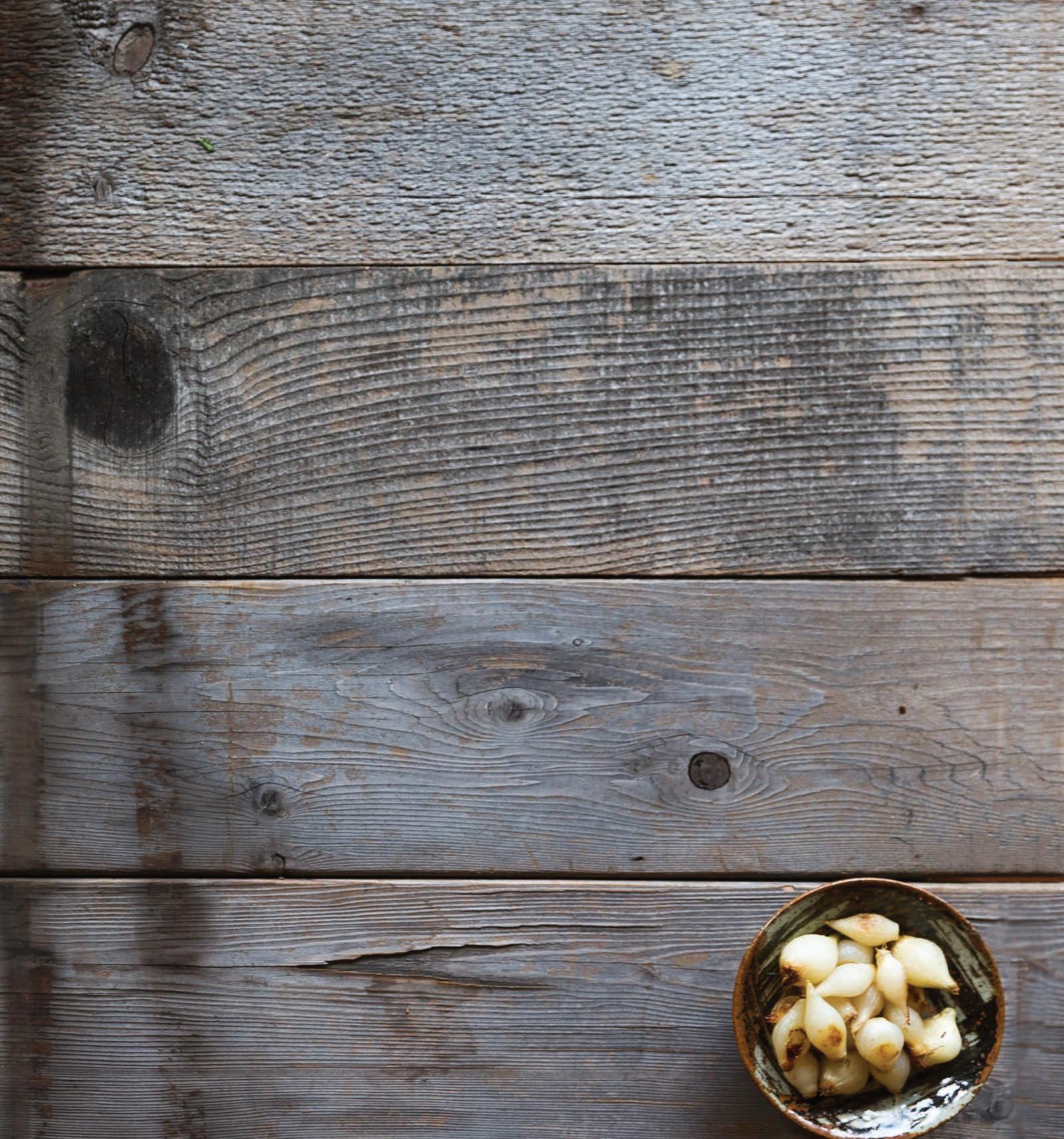
METHOD
Preheat oven to 400°C (200°C).
To make the stuffing, heat oil in a skillet over medium-high heat. Add the chopped prosciutto and cook for 1 minute. Add the garlic, lemon zest, shallots and thyme.
Cook until shallots start to soften, stirring occasionally, then add the rice and the broth, cover, lower the heat and let it simmer for 20 minutes. Remove from the heat and leave to rest for 2-3 minutes. Spread the rice onto a tray to let it cool.
When the rice is at room temperature, fill the quails with the stuffing and close each opening with 2 wooden cocktail sticks. Wrap 1 slice of prosciutto around each bird. Place the birds in a roasting pan and rub each with olive oil. Season with salt and pepper.
Put quails in oven and roast for 10 minutes, then pour the white wine over the birds and leave to roast for another 15 minutes. Remove from the oven and place quails on a plate. Cover with foil to keep warm. While the quails are cooking, prepare the sauce.
BOURBON BALSAMIC SAUCE AND FRESH CRANBERRIES
¼ cup honey

¼ cup balsamic vinegar
½ cup chicken broth
½ cup bourbon (or any other whisky)
¼ cup chilled butter 2 cups fresh cranberries
Heat the honey in a pan, on moderate heat, letting it melt for one minute. Add the vinegar and broth, stirring for 1-2 minutes as the liquid reduces. Add the bourbon and let it reduce to a syrupy consistency. Adjust heat to low and, stirring continuously, add butter until the sauce becomes smooth and thicker. Add the fresh cranberries and let it simmer for another 2-3 minutes.
Serve the quails accompanied by the Bourbon Balsamic Sauce and Fresh Cranberries and your favourite sides. We recommend fresh wild chanterelles cooked with butter, garlic and parsley and roasted Brussels sprouts and glazed pearl onions.
45
PHOTOGRAPHY Lillie Louise Major
The Shop, Two Rivers Meats, tworiversmeats.ca
IN PRAISE OF THE BRAISE

From cheeks to leeks, braising is the delicious, low-maintenance option for fall and winter flavours. It’s slow food at its most satisfying.
 TEXT: SHELORA SHELDAN ILLUSTRATION: LYDIA BEAUREGARD
TEXT: SHELORA SHELDAN ILLUSTRATION: LYDIA BEAUREGARD
BRAISING, A TIME-HONOURED TECHNIQUE
, takes the bite out of winter’s chill. It’s a moist-heat cooking method, where food is cooked in a small amount of liquid in a closed pot over a long period of time, slow and low, gently coaxing deep luscious flavours from tough cuts of meat, breaking down their connective tissue to fall-off-the-bone tenderness. Variations on this uncomplicated cold-weather favourite are infinite. It can be a classic pot roast one night or a sticky short rib feast redolent of ginger and soy the next. And once you master a few basic steps, the world of braising is just a Dutch oven away. It’s also great dinner party fare. Once the dish is in the oven, a host or hostess is free to attend to other matters. It’s even better made a few days ahead, allowing the flavours to really come together. I can’t think of a better way to spend time in the great indoors than knowing I’ve got something five-star-worthy simmering away in the oven. It fills the kitchen with seductive aromas and the promise of hearty nourishment. It warms up the room and the soul. Resistance is futile.
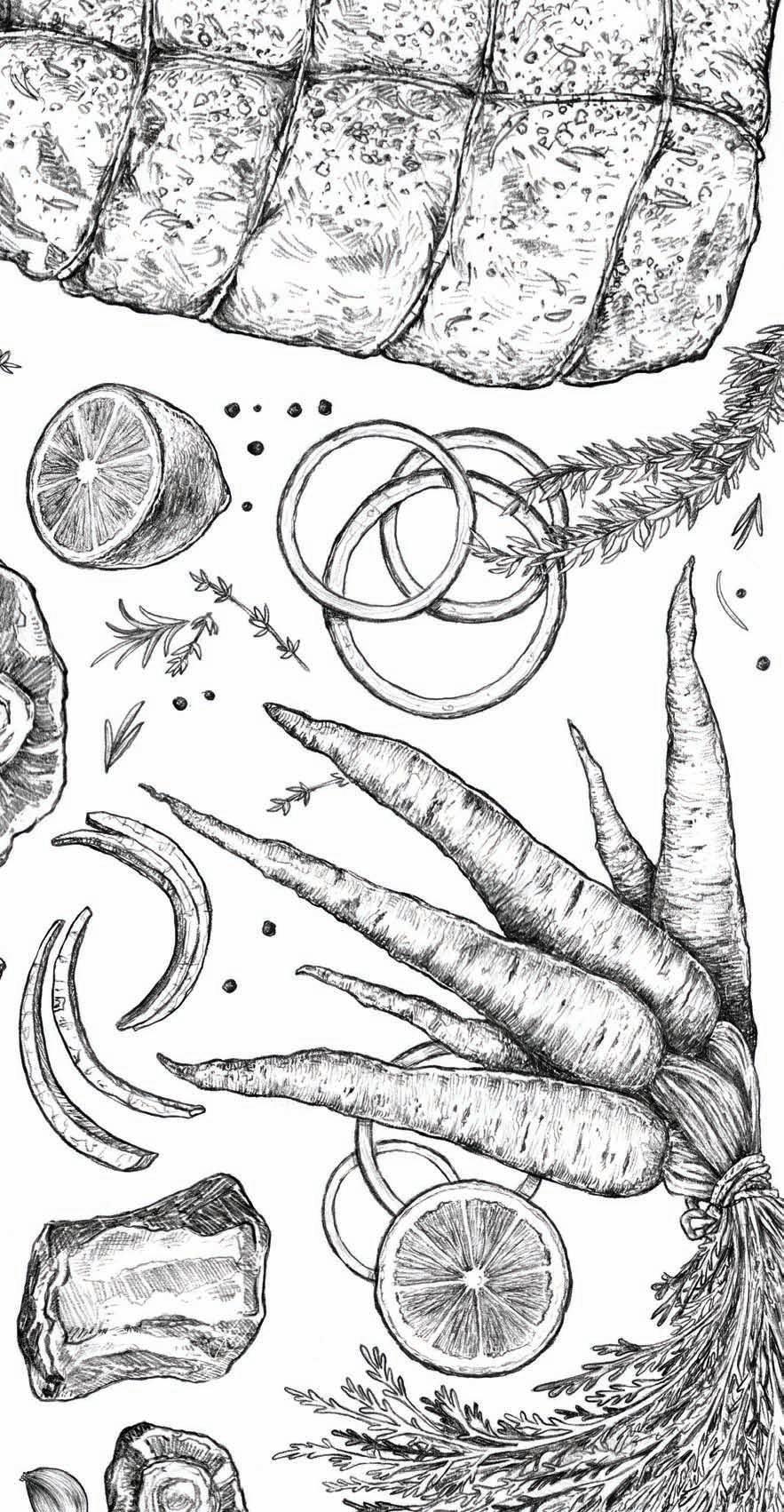
47
IT FILLS THE KITCHEN WITH SEDUCTIVE AROMAS AND THE PROMISE OF HEARTY NOURISHMENT.
CHUNKS OF PORK SHOULDER BECOME ACHINGLY TENDER CARNITAS IN MEXICO
GLOBAL/REGIONAL BRAISED
DISHES
This one-pot wonder is known the world over, due in part to its versatility and affordability, but also its ability to feed a crowd. Chunks of pork shoulder become achingly tender carnitas in Mexico—cue the food truck—or the Portuguese garlic-and-paprika-spiked companion for clams alentejana—cue the vinho verde! Aromatic rogan josh curries tame lamb or beef; red wine becomes the conduit for the hearty Provençal daube of beef and coq au vin; or white wine for the classic Milanese osso buco, made with crosscut veal shanks. From German sauerbraten and Moroccan lamb tagine flecked with apricots and mint, to the Brazilian feijoada completa or the vinegar-charged adobo (the national dish of the Philippines), braising puts an exciting culinary repertoire at your disposal. For further inspiration, I heartily recommend the books All About Braising by Molly Stevens and chef Daniel Boulud’s Braise, with recipes inspired by the cuisines of the world.
EQUIPMENT

The heavier the lidded pot the more evenly it will cook what’s inside, and ideally it should be a pot that can move from stovetop to oven. Bringing a steaming pot of braised goodness to the table will make you a star!
Although you can successfully braise on the stovetop, oven braising guarantees more consistent heat. The low-sided Dutch ovens are perfect, like the many colourful enamelled cast iron beauties on the market. Le Creuset, Staub or Le Cuistot brands come to mind, or the gorgeous clay Emile Henry brand of cookware. They might weigh a ton but they keep an even heat, and they look so flash! If you don’t have a flameproof pot, you can alternatively sear and deglaze your ingredients in a heavy skillet, and transfer everything to your ovenproof pot. A few friends swear by the cult-like Instant Pot, a programmable pressure cooker that has a sauté and slow-cook function, among other things, and are available in five- to eight-quart sizes. It speeds up braising times tremendously, and some of the pots also have Bluetooth capabilities, allowing you to program and monitor from smartphones or tablets. Each to his own, but give me a shiny red Le Creuset pot any day!
Other than a pot, you’ll need a trusted wooden spoon, a sharp knife for cutting ingredients, sturdy oven mitts and a mortar and pestle, or spice grinder, for grinding whole spices. It makes a world of flavour difference.
48NOVEMBER/DECEMBER 2017
THE BEST CUTS
When the tough (cuts) get going, they produce the ultimate in deeply delectable flavours and thick sauces. Think pork shoulder, brisket, pot roast, chuck, beef cheeks, brisket, pork belly, short ribs, tripe, tongue, oxtails or shanks, to name a few. I prefer meaty pork neck bones, one of the last bastions of value, braised with ancho and guajillo chilies and roasted tomatoes, green beans, chayote (pear squash) and some hominy corn, then finished with a hit of lime juice. Insist on buying whole cuts of meat and cutting them yourself. You can trim any excess fat as you see fit and essentially take control of your end

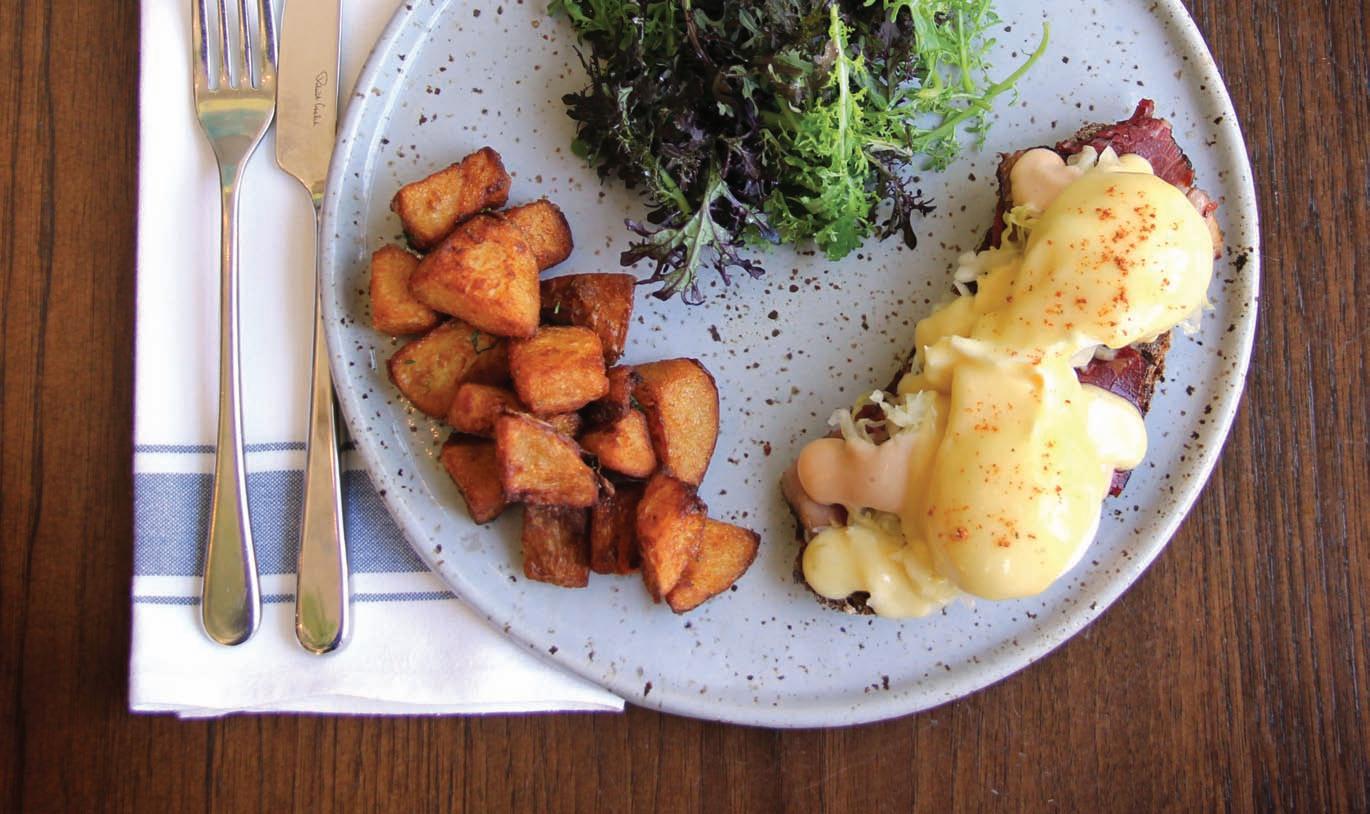

product. Cut on the larger size, as meat shrinks as it cooks. For chicken, turkey or duck, choose legs or thighs and braise them whole, with the bone-in for added flavour. Rabbit, cut in pieces, is also wonderful in a braise. For fish, octopus or skate are great, or whole fish, cleaned and descaled. Vegetarians can play too, and vegetables won’t take quite as long to cook as a pot roast. Chunks of cabbage, winter root vegetables—those big woody winter carrots are ideal—Brussels sprouts, alliums such as leeks, or even a whole cauliflower are all perfect candidates. Poultry and fish will also take less time to cook than cuts of meat.
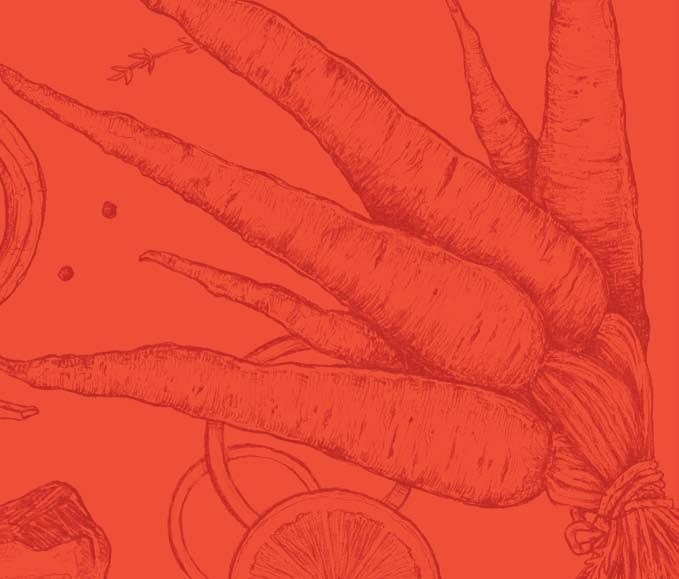
49
SHERI MARTIN
BRISKET BENNY SERVED OVER HOUSE RYE BREAD WITH CHEESE AND RUSSIAN DRESSING TOPPED WITH ORGANIC POACHED EGGS AND A CLASSIC HOLLANDAISE AT AGRIUS ON YATES STREET
HOW IT’S DONE

Just remember these key steps: searing, deglazing, stock and simmer, and you’re on your way to the perfect braise. The first step is flavour-building searing. Known technically as the Maillard reaction, all that caramelized goodness should be not emphasized enough. You want the meat to be brown on all sides, so take your time and don’t crowd the pan. The browner the ingredients, the more flavourful and luscious the end result. Once brown, remove the meat or fish and set aside, and over medium high heat, add in any flavour accents and aromatics, for another layer of flavour. Choose your weapons: dried herbs or spices, orange rind or lemon zest, dried mushrooms or chilies, the trifecta of carrots, onion, celery; chipotle en adobo, ginger, garlic, lemon grass, tomato paste, bay leaves or a stick of cinnamon; it all depends on what direction you’d like to take the dish. Once softened, taking care not to burn the ingredients, deglaze the dish to release all those flavourful aromatics and browned bits on the bottom of the pan into the mix. Choose wine, cider, vermouth, beer or even water, stirring constantly until the liquid reduces by half and all those bits have been taken up into the sauce. The meat or fish is then added back to the pot along with the braising stock, be it chicken, beef, fish or vegetable. “Good quality stock is key,” says chef Cory Pelan of Whole Beast, who is a big fan of braising and shares a recipe with us. “Either make your own or buy the real thing from a good butcher shop,” he says. I couldn’t agree more. The meat should not be completely submerged in the stock. If it is you’ll be making stew, not braising. Put the lid on and let the dish cook in the oven, around 300F°, until you achieve melting, meaty goodness. If using only the stovetop, make sure your heat is at a low simmer, and check often. You don’t want it to boil.
Halfway through cooking is the time to add any other chopped vegetables, such as turnips, squash, peppers, parsnips, celery root, chopped mushrooms, dried fruit, or chunked potatoes.
Once your braise is done, let is rest for 15 minutes and degrease the sauce if need be and adjust the seasoning. If you are left with too much sauce, you can reduce it. Use a soup ladle or a measuring cup to scoop some of it out and reduce it in a small pot before adding it back in. If the sauce is too thick, you can thin it out with some hot stock or other liquid. Just let it simmer a couple of minutes to incorporate into the mix.

50NOVEMBER/DECEMBER 2017
VIETNAMESE CRISPY HUĔ PANCAKES AND BRAISED BEEF CHEEKS WITH GINGER, GARLIC, SOY, TOASTED CARDAMOM AND CORIANDER AT STAGE WINE BAR IN FERNWOOD VILLAGE
SHERI MARTIN
FINISHING

Although optional, a final flourish of flavour just before serving brings the whole dish to fruition, in my opinion. Add in freshly chopped herbs such as basil, parsley or cilantro for a verdant note; a hit of vinegar, lemon or lime juice or zest for a tangy lift; a salty umami blast of soy or fish sauce; or chopped olives, horseradish, Dijon mustard or preserved lemon. Now is also the time to add cooked beans. Garbanzo beans are my favourite and go so well with any dish with a Middle Eastern or Indian theme. Hominy corn is another great addition to any pork braise with a robust chile pepper and tomato theme. Just heat through and adjust seasoning.

51
SHERI MARTIN
CRANBERRY-BRAISED DUCK LEGS WITH WINTER HERBS, AROMATIC STAR ANISE AND CINNAMON AT PADELLA IN ESTEVAN VILLAGE
Chef Cory Pelan of the Whole Beast and the Village Butcher knows how to coax maximum flavour out of meat. As a braising aficionado, he recommends beef cheeks, one of his favourite cuts. “They impart huge flavour, texture and viscosity to the braising liquid,” he says, “keeping the meat moist and juicy.”
(This is due to the cut’s high percentage of collagen.) He suggests pairing the dish with creamy mashed potatoes, your favourite winter veg and an Okanagan Bordeaux blend such as Poplar Grove’s Legacy. Bon appétit!
BRAISED BEEF CHEEKS WITH PANCETTA AND ROSEMARY
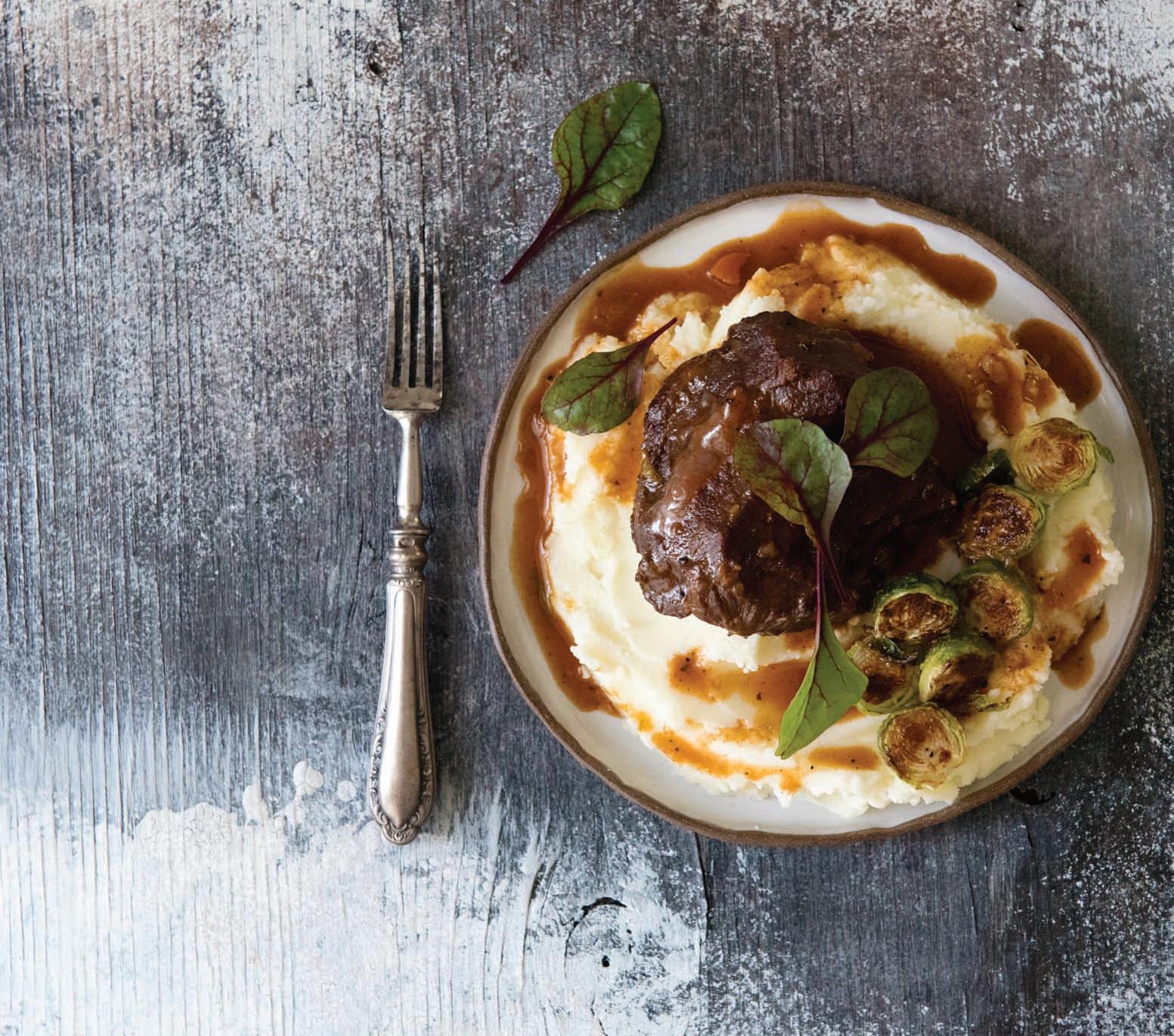
FROM CORY PELAN, THE WHOLE BEAST Serves 6

4 Tbsp olive oil
5 beef cheeks (about 2 kg)
1 cup pancetta diced
1 cup onion diced
3 cloves garlic thinly sliced
¾ cup carrot diced

¾ cup celery diced


3 Tbsp tomato paste
2 Tbsp flour
1 cup red wine
3 cups good quality beef stock
2 sprigs rosemary, stems removed
1 Tbsp butter
Salt and pepper to taste
Pat-dry beef cheeks and season with salt and pepper. Heat olive oil over medium-high heat in a heavy-bottomed 8-quart saucepan or casserole and brown cheeks well on all sides, working in batches to avoid crowding the pan. Remove from pan and set aside.
Add pancetta to pan and sauté till light brown. Add onions, garlic, carrot and celery and sauté for 5 minutes or until starting to soften. Add tomato paste and cook for 2 minutes stirring well. Add flour and cook for 2 more minutes, stirring well. Add wine and stir till combined, then cook for 2 minutes.
Add stock, rosemary and the cheeks and bring to a simmer. Cover pot and braise for 2.5 hours or until tender. Let cheeks rest in braising liquid for 15 minutes and stir in butter just before serving.
52NOVEMBER/DECEMBER 2017
WELLMAN
THE RECIPE REBECCA
IT’S IN OUR HANDS. HAND-CRAFTED BREAD MADE WITH FRESHLY STONE-MILLED FLOUR AND ONLY CERTIFIED ORGANIC OR SUSTAINABLY GROWN LOCAL INGREDIENTS . NATURALLY LEAVENED AND BAKED TO CRUSTY PERFECTION IN WOOD-FIRED BRICK OVENS. 1517 QUADRA ST.



DINING OUT (WHERE TO TRY BRAISED DISHES)
If braising at home is not in the cards, take comfort at some of the many restaurants conjuring up hearty winter flavours. Here are a few.
Chef Carmen Ingham of the Villa Eyrie cues rustic Roman gusto for lamb shoulder braised overnight in reduced balsamic, red wine and lamb stock. Enjoy it with gnocchi alla Romana spiked with sharp pecorino cheese and Calabrian chilies for a fragrant, spicy note. villaeyrie.com
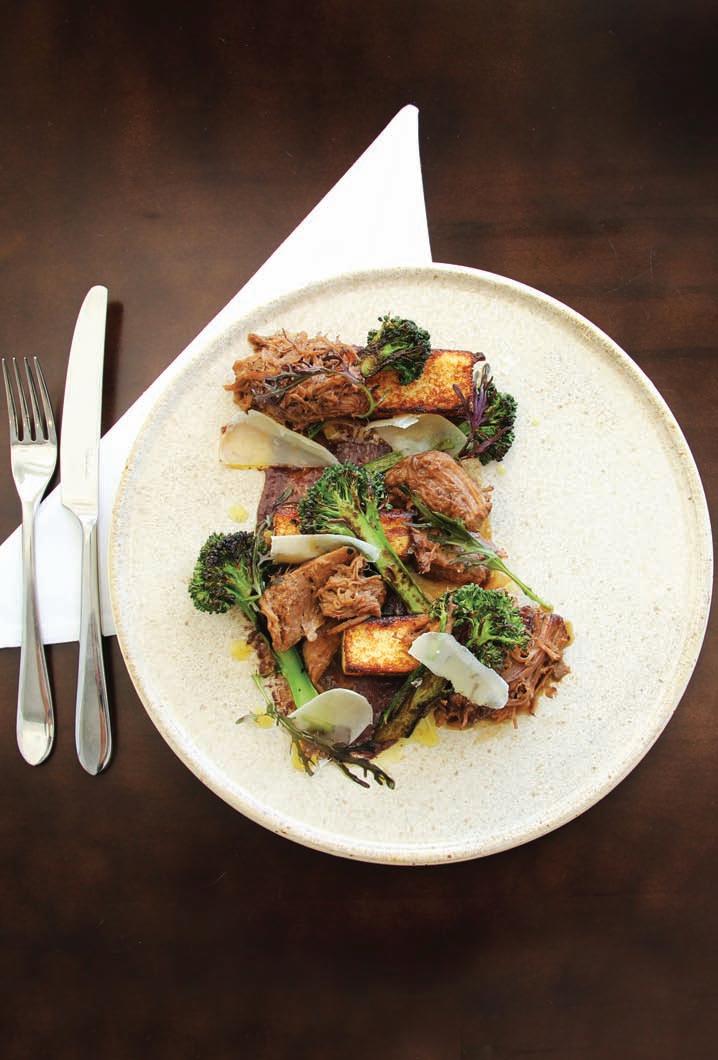
Sean Hansen’s love of Asia’s multi-faceted flavours shine through at Stage Wine Bar with Vietnamese crispy Huĕ pancakes and braised beef cheeks. Ginger, garlic, soy, toasted cardamom and coriander defines the ambrosial fall-apart cheeks nestled nicely in two rice flour pancakes with a hoisin and peanut-based sauce for anointing. stagewinebar.com
Chef Kyle Gignac of Padella warms up winter with cranberrybraised duck legs. Cranberry juice in the braising stock counterbalances the duck’s richness with winter herbs, aromatic star anise and cinnamon adding complexity. The resulting robust sauce envelops duck meat and seasonal squash for a lusty ragu topped with house gnocchi and a snowy finish of pecorino. padellakitchenandwine.com
Agrius’s daily brisket benny provides a rich and satisfying repast. Slow smoked and braised to tender effect, meaty brisket slices are served over house rye bread with cheese and Russian dressing topped with organic poached eggs and napped with a classic hollandaise. Add on hash browns for the “full nasty mode,” it’s far too late for salad. agriusrestaurant.com
53
BRAISED LAMB SHOULDER WITH GNOCCHI ALLA ROMANA, CHARRED BROCCOLI, CALABRIAN CHILI, PECORINO AT THE SUMMIT RESTAURANT AT VILLA EYRIE ON THE MALAHAT DRIVE.
SHERI MARTIN
FRESH OYSTERS
Holiday Heaven on the Half-Shell
It’s popular to speculate about who might have pried open and slurped the sweet, briny meat of an oyster first. But here on the West Coast, the evidence is ancient. Wherever you find a calm beach or a cozy cove, you’ll often also see a slash of white in the sea-eroded bank, a layer of crushed shells, tossed here by feasting indigenous families.
Text: CINDA CHAVICH • Photos: REBECCA WELLMAN

54NOVEMBER/DECEMBER 2017
A SELECTION OF RAW OYSTERS ON THE HALF SHELL, EVENING COVES, KUSSHI, AND BLACK PEARLS PROVIDED BY THE WANDERING MOLLUSK WANDERINGMOLLUSK.COM
For like salmon, oysters (and related shellfish) were a staple food for coastal Salish people, and the many shell middens dotting our island coastlines, literally the litter of history, tell us where they lived and harvested these briny bivalves.
Fast forward to the 21st century and oysters are still a west coast obsession. Oyster farming in B.C., mainly on the west coast of Vancouver Island along the shores of Baynes Sound and the Discovery Islands further north, is a $40-million industry. We are the largest oyster-farming province in the country, producing 60 percent of Canada’s 26,000tonne annual crop.
And unlike farmed salmon, farmed shellfish (like oysters and mussels) is completely sustainable and OceanWise. Oysters are not fed, they eat the wild plankton in the sea, and farming them has little or no environmental impact.
WHAT’S IN A NAME
Nearly all of our B.C. oysters are the Pacific type (Crassostrea gigas), the elongated, frilly oysters first introduced into our waters from Japan. Pacific oysters can take on a variety of tastes, ranging from sweet and lightly briny to watermelon or cucumber flavours. You can also find another Japanese species here, the tiny Kumamoto (Crassostrea sikamea), loved for its sweet, mild and buttery flavour.
On the opposite coast—in PEI and New Brunswick—the native American Oyster (Crassostrea virginica) is now farmed, an indigenous Atlantic type with a rounder, smoother shell. Malpeques and Bluepoints (named for the bays where they’re grown) are Atlantic oysters, known for their crisp texture and briny flavour.
The Belon (Ostrea edulis) is found in France, a flatter European oysters with a shallow, saucer-shaped cup, a meaty texture and a bold flavour.
The wild native or Olympia oyster (Ostrea lurida), still sometimes found in Washington waters, has all but disappeared here, a victim of overfishing in the 1800s.
But oysters were once cheap and plentiful.
According to the ads and reports appearing in the earliest Victoria newspapers, it must have been a great city for miners and mollusk lovers. Rudolph’s Oyster Saloon was operating on Waddington Street in 1859. By 1861, Sooke Oysters were “constantly on hand” at the Phoenix Saloon.
“This is the first newspaper reference identifying where oysters were being harvested in British Columbia, although the oyster beds in the Gorge waterway at Tillicum Narrows had been recognized as early as 1846,” notes a recent article in the Royal BC Museum’s magazine. Curious. By 1865, four other Victoria oyster saloons were advertising “the celebrated Olympia oysters in every form.”
Island oysters were exported to meet the growing demand. Records from 1910 indicate 7.7 million oysters were harvested in Vancouver Island waters, from Alert Bay and Nanaimo to Cowichan and Victoria.
Unfortunately, this oyster windfall soon ended. Overfishing led to a collapse in the wild oyster population; the “Oly” is functionally extinct here today.
Though researchers at the VIU’s Deep Bay Marine Field Station have begun efforts to reintroduce the native oyster to Baynes Sound, manager Carl Butterworth says there is “no restoration work at the moment,” and B.C.’s only native oyster remains a “species at risk.”

MOLLUSK MEN
Jess Taylor and Sean Roberts are experts at inserting a knife into the hinge of an oyster shell and almost instantly shucking it for your slurping pleasure. As The Wandering Mollusk, they’ve made a business of popping up at parties around town to take oysters to the people, serving up thousands of the freshest local oysters over the past three years. “At parties, we’ll shuck 600 oysters in two hours,” says Taylor. “I’ve shucked hundreds of thousands of oysters.” With their mobile shucking cart and deep knowledge of the briny bivalve, Taylor says The Wandering Mollusk is committed to sharing the local oyster culture.
“Sean and I want to be the champions of our local oysters,” says Taylor, “to talk about our farmers and our ‘merroir’ and celebrate it.”
HOW TO OPEN AN OYSTER
1. Get a good shucking knife, one with a solid handle and thick blade, and a pair of heavy gloves to protect your hands.
2. Scrub oysters before shucking, if necessary, to remove sand or mud.
3. Set the oyster on a clean towel, on a flat surface, with the deeper, cupped side down. Fold the towel over the oyster to partially cover it, and hold it on the board.
4. Place the point of the knife into the hinge between the top and bottom shell (at the pointed end of the oyster).
5. Twist the blade and pry the oyster open, sliding the blade inside, along the top shell, to release the meat.
6. Separate the top shell from the bottom, then cut the abductor muscle on the bottom shell.
7. Set the shucked oysters on a layer of crushed ice or rock salt to keep them up right, taking care not to lose any of the juicy liquor in the shell.
Of course, freshness is paramount when it comes to oysters, and that’s what these wandering shuckers deliver. Their relationships with local oyster farmers mean they can guarantee the oysters they serve have been out of the water for only a few days before they land on your plate.
“We get the glory, but it’s the farmers who deserve our respect—it’s a tough gig. You wouldn’t believe how hard these guys work.”
When The Wandering Mollusk delivers their shucked oysters to individual events, they come with information sheets describing the type of oyster, flavour profile and source. The named oysters are brands of specific producers, and though the variety is the same, the “merroir” (where, when and how the oyster is farmed and what it’s eating) changes its shape, size and flavour. They may be grown in trays or bags near the plankton-rich surface, deep in fast water, or “au naturel” on an intertidal beach.
At BCOysterGuide.com you can read more about the various types of island oysters available—like the Fanny Bay oyster, the Mac’s Beach oyster, Satori and tiny Zen from Hollie Wood Oysters on Denman Island, or the Black Pearls and Beach Angels from the eight families that form the Out Landish Shellfish Guild around Quadra and Cortes islands. Many producers use tumbling machines to knock off the thin edges of the shells and encourage the oysters to form deeper cups as they grow. It makes for oysters that are easier to shuck (without annoying bits of shell in your oyster) and lots of oyster liquor to slurp.
Oysters grown where there’s more kelp and sea plants can have a fresh, cucumber flavor, while those grown in colder, deeper water tend to be briny and crisp. You might detect a
55
JESS TAYLOR OPENING A SWEET AND JUICY KUSSHI OYSTER
minerality, even a touch of melon. Some have a buttery texture, but you don’t want an oyster that tastes soft or looks milky (that’s an indication they’re in their spawning phase and though perfectly safe, not great eating). Oysters generally spawn in warmer months, which is why winter is prime oyster season.
At The Wandering Mollusk, Taylor says he favours briny, sea-tumbled, beach culture oysters, like Evening Cove from Salt Spring Island, “an oyster lover’s oyster.” Tray oysters tend to be sweeter, he says, adding the small, mild Kusshi from Stellar Bay Shellfish in Deep Bay is a good “gateway oyster” to try.
SELL, SHUCK, SERVE
The Wandering Mollusk will shuck a plate of oysters for your party for pick up at their kitchen (845 Viewfield Road in Esquimalt) just an hour before you need them. Or you may find them shucking at pop-up Sunday events at The Livet. Belly up to other oyster bars in the city and order a platter of pre-shucked bivalves—think 10 Acres Kitchen, Steamship Grill or Ferris’ Upstairs Seafood + Oyster Bar, where the oysters come raw on the half-shell, housesmoked or cooked up in various ways, from crispy breaded oysters and oysters fried in butter and garlic to baked with a wide range of toppings.
But you can also enjoy fresh oysters at home. First, find a solid source. A local fishmonger like Finest at Sea or Oak Bay Seafood is a good place to start. At the latter, they also smoke local oysters in their own smokehouse and the takeout kitchen offers tasty plates of crispy fried oysters and chips, or oyster chowder to go.
When buying live oysters, you can ask to see the label that each grower must affix to every shipment, which lets you know exactly when and where the oysters were harvested. Make sure they are fresh and tightly shut, with no fishy smell.
It’s always fun to shuck and serve a selection so you can appreciate the different oyster-growing regions and what goes into creating each unique oyster. Freshly shucked, naked or with a drop of lemon juice or red wine mignonette, is the traditional way to enjoy raw oysters. A crisp white wine or bubbly makes the perfect sipper. If you’re concerned about contamination, serve your oysters cooked. Heating them to 90°C for 90 seconds will kill most food-borne illnesses, though the toxin causing PSP (paralytic shellfish poisoning) is not killed by cooking. Oysters can live a week out of water. Don’t store them on ice (they will die in fresh water). Rather, place a damp cloth in a pan, arrange the oysters in a single layer (deep cup down to preserve the juices), cover with a damp cloth and refrigerate at 1-4˚C. Once shucked, serve oysters on a bed of ice and eat within two hours of shucking.
SAFE TO EAT?
It used to be said it was best to eat raw oysters during months with an “R”—September to April—when the waters are coldest and the weather still chilly for harvesting and
transportation. Though refrigeration and modern farming methods mean oysters are now harvested and available year round, changes to the climate are affecting water temperatures and causing concern for farmers.
Oysters are filter feeders and take in whatever’s in the water. Last year’s outbreak of norovirus, which sickened 400 people and shuttered several B.C. farms for months, likely came from raw sewage dumped into local waters that spread through the region. The BC Centre for Disease Control never pinpointed the exact source of the outbreak, but the virus was spread by ocean tides and currents from B.C. to U.S. farms in Puget Sound.
In an article in the British Columbia Medical Journal, researchers concluded that a wet fall and unusually cold winter may have allowed the virus to survive in coastal waters. The fact that the outbreak occurred between November and March also negates the old adage about eating oysters in cooler months.
And there are also increasing worries that warming waters can host diseases like E. coli, Red Tide (paralytic shellfish poisoning) and Vibrio parahaemolyticus, a naturally occurring bacterium that can affect raw oysters.
So is it safe to consume oysters?
There is always a risk associated with consuming raw fish and shellfish. But Darlene Winterburn, executive director of the BC Shellfish Growers Association (BCSGA), says farmers are cooperating with government and regulators to prevent future problems.
All commercial oysters go through federally inspected processing plants before they get to market, which makes them safer than self-harvested shellfish, she says.
DOUBLE OYSTER AND SPINACH STEW
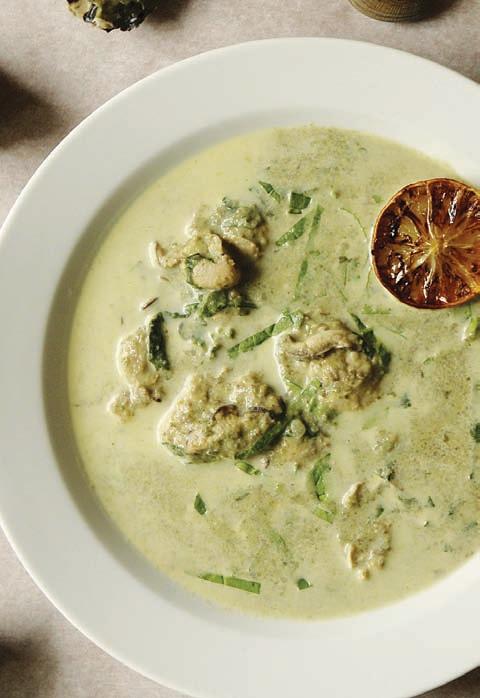
I created this recipe to use the pre-shucked oysters you can find in jars or tubs at the seafood shop. The puréed base of potatoes, oyster mushrooms and spinach thickens the chowder—no need for a lot of cream and extra calories. Oyster stew is traditional at Christmastime, and with slivers of brilliant green spinach and red bell pepper it’s particularly festive.
1 bunch spinach, divided
1 large onion, minced
6 medium oyster mushrooms, minced
1 Tbsp butter
1 Tbsp olive oil
1 large Yukon Gold potato, peeled and chopped
2 cups stock (use fish or clam broth)
½ cup heavy cream (optional)
2 cups 2% milk
1 pint shucked oysters, halved if large, liquor reserved Salt and freshly ground black pepper
Slivered roasted red peppers and sweet Hungarian paprika to garnish
Wash the spinach well in a large sink of water and squeeze dry. Discard the stems, roll the leaves and cut into chiffonade. Set aside half of the chiffonade – mince the rest of the spinach.
Mince the onion and mushrooms in the food processor (separately) to save time.
Heat the butter and oil together in a large saucepan over medium high heat and sauté onion for 5 minutes. Add the mushrooms, potatoes and half of the spinach and cook together, stirring, for 5 minutes longer. Add the stock and reserved oyster liquor, cover, bring to a boil and simmer on medium-low heat for 15 minutes or until potatoes are soft.
Add the cream and simmer 2 minutes longer, then puree using an immersion blender. When the mixture is very smooth, add the milk and reheat, just to a simmer.
Stir in the oysters (whole or cut into 2-inch pieces if very large). Cover the pan and cook on medium heat for 2-3 minutes, just until the oysters have plumped and curled around the edges.
Stir in the remaining spinach and stir 30 seconds, until spinach turns brilliant green. Do not overcook.
Season to taste with salt and pepper. Ladle into wide soup bowls. Top each with a tablespoon of slivered roasted red peppers and sprinkle with sweet paprika to garnish the plate.
Serves 6.
56NOVEMBER/DECEMBER 2017
DOUBLE OYSTER AND SPINACH STEW
Sustainability... A New Edge
Our master craftsman at Artisan Workshop has perfected the process of shaping, multiple wetting and sanding, oiling and buffing rescued broadleaf maplewood into live edge serving boards, wine racks, coffee tables, shelving and other products. The woods used originate on Vancouver Island, and are pulled from the chipping jaws at mills, or found as dead fall, or pruning and transformed into beautiful wood products for natural living.



Find them at Slaters 2577 Cadboro Bay Road 250-592-0823

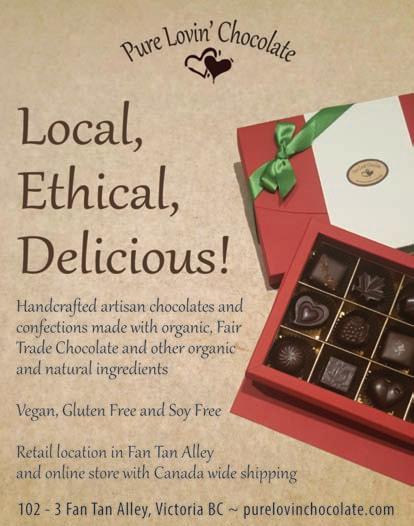

holiday gift guide
Everything from gift certificates to Christmas presents, we’ve got you covered this season



rk horsead
dark horse
rk
remium ta PerlbA n whis orc ounde e r a blend of 12 and 6 anadian, Da 100% C
e A its L tage SpirinVt
k Hors emium DarrP
m wttarer win fec e per h Twn. ink o dr anhattanM o make an t ersat k v Dar , and de eet , sw y y, sw Spic and 653 P
We at Vintage Spirits Love Alberta Premium Dark Horse Whiskey. 100% Canadian, Dark Horse is a blend of 12 and 6 year aged rye whiskey rounded out with a dollop of corn whiskey. Spicy, sweet, and delicious Dark Horse is versatile enough to make an amazing Manhattan or drink on its own. The perfect winter warmer!


vintagespir
ta lber
Alberta Premium vintagespirits.ca 653 Pandora Ave. | 250.383.4161
57
Liquid Assets






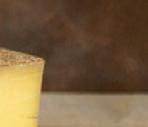

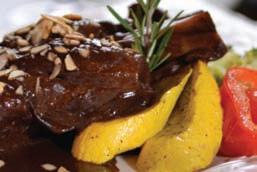

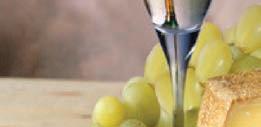




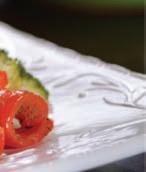
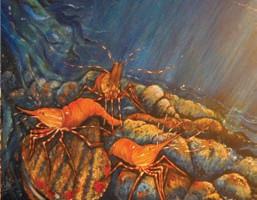
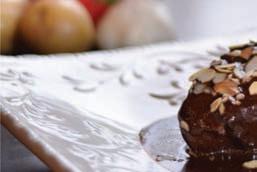
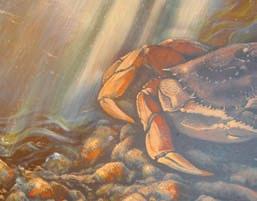











GREAT REDS
From Salt Spring to Italy, these winter suggestions are sure to please.
FINCA CUARTA RIBEIRA SACRA MENCIA 2016, SPAIN $20.00-23.00
In the great province of British Columbia, unless you have hiked el Camino Real through the verdant Galician countryside, the Mencia of Ribeira Sacra is not common knowledge. Located in the remote mountainous reaches of northwest Spain, the vineyards are perched on almost vertical slopes plunging hundreds of meters into the river below. Soft and supple with bramble, coffee and spice aromas, sweet fruit flavours, a patina of soft tannins and a long supple finish. Very highly recommended.
GRAN PASSIONE VENETO ROSSO 2016, ITALY $20.00-23.00



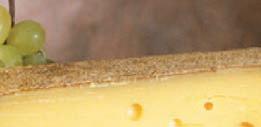

An Amarone knock-off at a third the price is always worth a look and I was very much surprised at how much I enjoyed this hearty Italian red from the Veneto. A blend of Merlot and Corvina, the grapes are dried and concentrated before pressing and fermentation. Rich and succulent, with sweet fruit flavours redolent with plum, cherry and Christmas spice. Very powerful yet nicely balanced with a long lively finish.
VILA REGIA DOURO VINHO TINTO 2015 PORTUGAL $10.00-13.00
Sogrape Vinhos is the Arnold Schwarzenegger of the Portuguese wine biz. In a world driven by the fickle whims of the wine market, Sogrape is more than just a player, hanging in there! After several decades, the company is still building on its strengths and making wines people like at great prices. A blend of Douro stalwarts, this hearty red from the sun-scorched vineyards of the Douro Valley in northern Portugal, has plenty of heft with lush fruit flavours and plenty of character.
GARRY OAKS ESTATE PINOT NOIR 2015, SALT SPRING ISLAND, BC $27.00-30.00
Medium-bodied with fresh, red cherry flavours, a silky texture, soft acidity and a blush of finegrained tannins that develops through the finish. The winery is located halfway up the FulfordGanges hill on Salt Spring Island and is definitely worth the pullover if you are ever out that way.
ALTESINO BRUNELLO DI MONTALCINO 2012, ITALY $53.00-60.00
Sometimes you need to dig a little deeper into that threadbare pocket to fish out an extra buck or two for a really good bottle of wine. There is just no avoiding it and if providence is on your side the upside can be nothing short of a revelation. This Brunello is worth every penny and although still young, with a long life ahead, it is absolutely five-star. Very fresh, very elegant with juicy fruit flavours, polished tannins and great complexity. Simply superb!
MARQUÉS DE RISCAL RIOJA RESERVA 2012, SPAIN $29.00-34.00
Classic in style with a huge nose that does not require seeking out, it just comes out to greet you. Lots going on here with ripe cherries, vanilla and spice aromas that just keep going. Good weight on the palate with a soft silky texture and ripe fruit flavours that develop and expand through the finish.
BENI DI BATASIOLO LANGHE ROSSO 2014, ITALY $18.00-20.00
A blend of the three graces of Piedmont: Dolcetto for the fruit, Barbera for the acidity and Nebbiolo for the mildly tannic structure. Not the biggest red in the neighbourhood but a solid middleweight contender with loads of character and great fruit at a fraction of the price of its better know cousins, Barolo and Barbaresco.
ROCCA DELLE MACIE CHIANTI CLASSICO 2015, ITALY $17.00-20.00
Predominately Sangiovese with a splash of Merlot to flesh it out, this juicy Chianti Classico has a lot going on, with layers of red cherry, spice and dusty earth aromas that just keep coming and don’t ease up. Medium-bodied, with bright fruit flavours, clean acidity, soft tannins and good length. A keeper!
FROM THE CELLAR
POPLAR GROVE NARAMATA BENCH CABERNET FRANC 2000, OKANAGAN, BC
How much of this shockingly good dowager from the Naramata bench is still lurking about, long forgotten in some enthusiastic aficionado’s basement? Who knows, but I think, not bloody much. Pity! I have enjoyed, over the last few weeks, a bevy of bottles of both the Cabernet Franc and the Merlot of the same vintage and I stand testament that they have all proved hale and hearty with good corks and plenty of life. Richly scented with a whiff of tomato leaf, a beetroot-like bouquet and a gentle, silky texture. Just lovely!
58NOVEMBER/DECEMBER 2017
LARRY ARNOLD
106 Superior Street | 250.380.0088 | IlCovoTrattoria.ca
Authentic Taste of Italy Victoria’s Authentic Taste of uthentic Taste
Victoria’s
Celebrating years
LOCAL FLAVOUR
Please support the advertisers featured here as their support allows us to offer this magazine free of charge.
DUNCAN
Hudson’s On First
Award winning dining in a beautifully restored heritage home. Local ingredients, classic techniques and made from scratch cooking are a just few reasons to visit us in Duncan more often. Celebrate Bubbles & Brunch, Lunch and Dinner.

163 First St. Duncan, BC, 250-597-0066, hudsonsonfirst.ca
Duncan Garage Café & Bakery
Festive and Funky, The Duncan Garage Café and Bakery features Holiday cookies, fruitcakes, breads, jams and so much more. Gift them. Serve them. Or take a minute, breath, relax and enjoy them one at a time with your favorite beverage. Committed to serving local,organic and healthy vegetarian food and baking for over 15 years. 330 Duncan St., Downtown Duncan (across from the railway station), 250-748-6223
MATTICK’S FARM
Adrienne’s Restaurant & Tea Garden
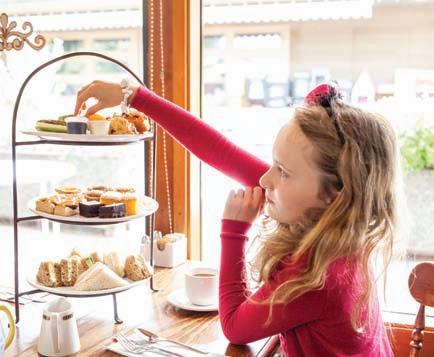
High Tea - Come and visit our Bakery, Deli and Restaurant for Breakfast, Lunch and Afternoon High Tea, we also offer Afternoon Tea plate and Kid’s Tea plate! Book your reservations for Christmas High tea, try our Linzer and Mocha tortes, Christmas Stollen and GF Fruitcake. Happy Holidays!
Open daily! 5325 Cordova Bay Road, Victoria, BC, 250-658-1535 AdriennesTeaGarden.com
VICTORIA PUBLIC MARKET

Whisk
We at Whisk would like to wish all of our loyal and new customers a happy and prosperous Holiday season. Come and visit us at Victoria Public Market for lots of great gadgets and giftware. Gift cards and registry.
At the Victoria Public Market, 778-433-9184, whiskvictoria.ca, Facebook and Instagram. Open 7 days a week
Victoria Public Market 778 433 9184

VICTORIA
The Local General Store
Come visit our warm, old-world 21st century general store to find unique locally-made and fair trade gifts for all celebrations. A one-stop sustainable source of seasonal organic produce, as well as household goods, stationery, toys, body care, and refillable cleaning products.
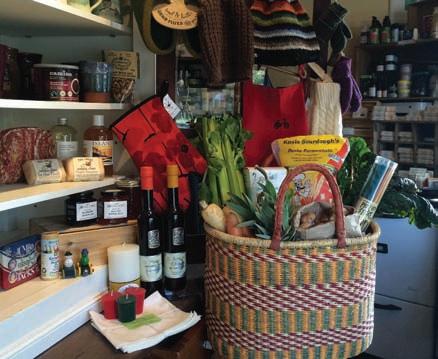
1440 Haultain St, (Corner of Haultain & Belmont) (778) 265-6225, thelocalgeneralstore.ca
Tastes & Spirits - Victoria Conference Centre

Try this lively sampling area showcasing regional food and drink producers as part of your visit to the Victoria MidLife Show. Tastes opens at 10 am, Spirits opens at noon, both run until 5 pm. Check out the rest of the event for interactive exhibits, main stage presentations, workshops, and prize draws at 1 and 4 pm. Admission to the entire event only $5.
Nov 18, Victoria Conference Centre, 720 Douglas Street, www.midlifeshow.com
59
WHISK
THE LOCAL GENERAL STORE 1440 Haultain St, (Corner of Haultain & Belmont) (778) 265-6225 Mon-Fri 9:30-6:00 Saturday 9:30-5:30
RESTAURANT & TEA
Kitchenware
ADRIENNE’S
GARDEN



















































































































































 story by DANIEL MURPHY photography by JOHANN VINCENT
story by DANIEL MURPHY photography by JOHANN VINCENT





























































 BY REBECCA BAUGNIET
BY REBECCA BAUGNIET
















































 | LEPETITDAKARBC.CA
| LEPETITDAKARBC.CA

































































































































































































 TEXT: SHELORA SHELDAN ILLUSTRATION: LYDIA BEAUREGARD
TEXT: SHELORA SHELDAN ILLUSTRATION: LYDIA BEAUREGARD
































































